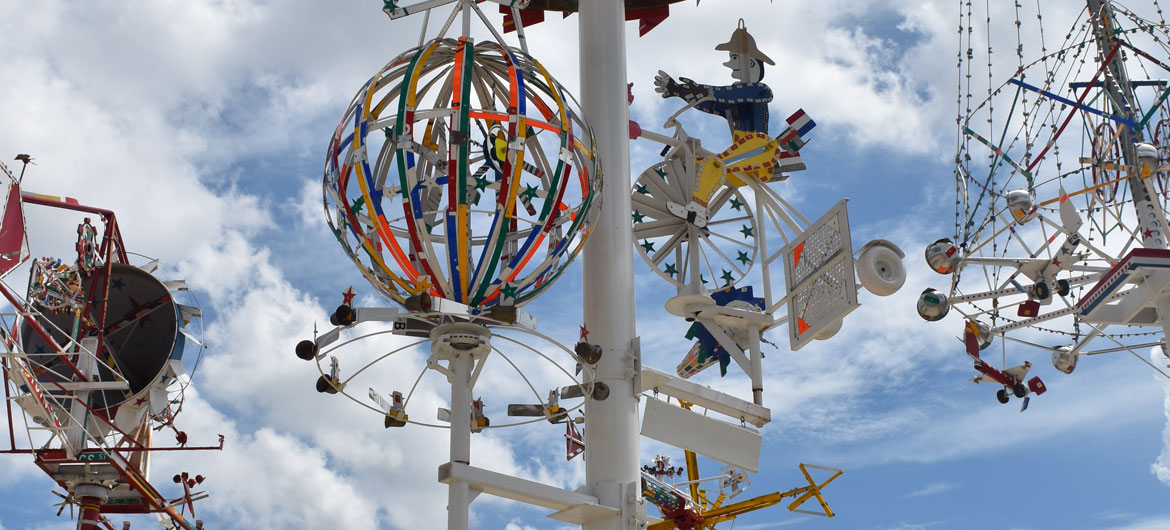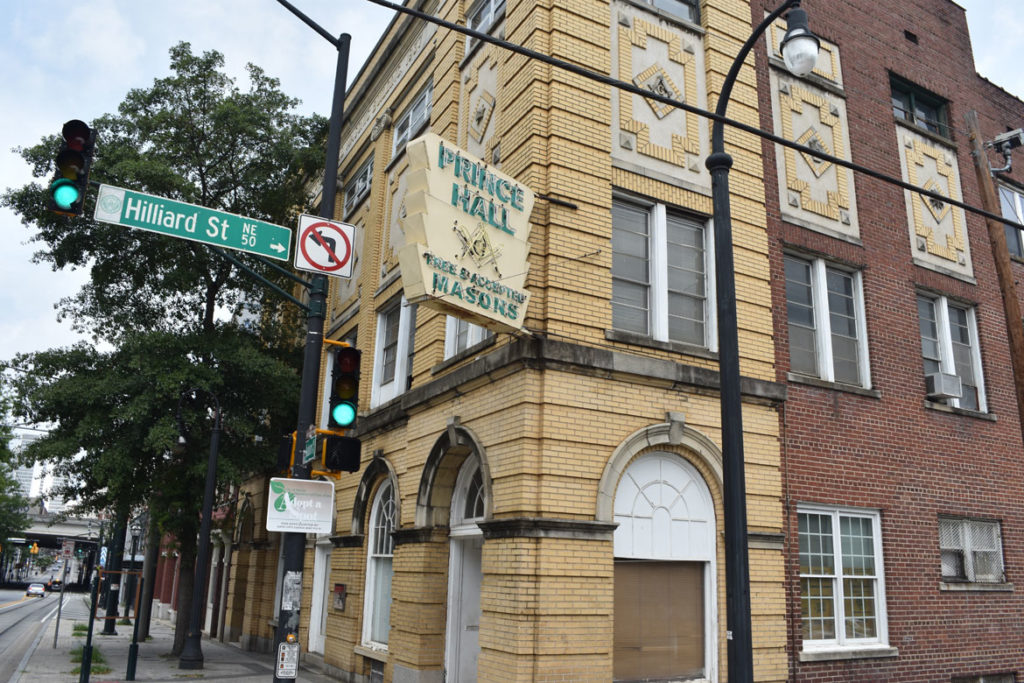I’m on a camping road trip to the American South to research visionary art environments and tourist traps, waterfalls and caves, history and creatures. I’m going to be posting photos as I go along, when I’m occasionally connected to the web. The photos appear below in reverse chronological order—with oldest at bottom and newest at top. Check back here for more. Then in the coming months, I aim to write more expansively about the things I’m seeing. But for now, these are just some quick notes.
If this is the kind of coverage of arts, cultures and activisms you appreciate, please support Wonderland by contributing to Wonderland on Patreon. And sign up for our free, weekly newsletter so that you don’t miss any of our reporting.
Shenandoah Caverns at Quicksburg, Virginia
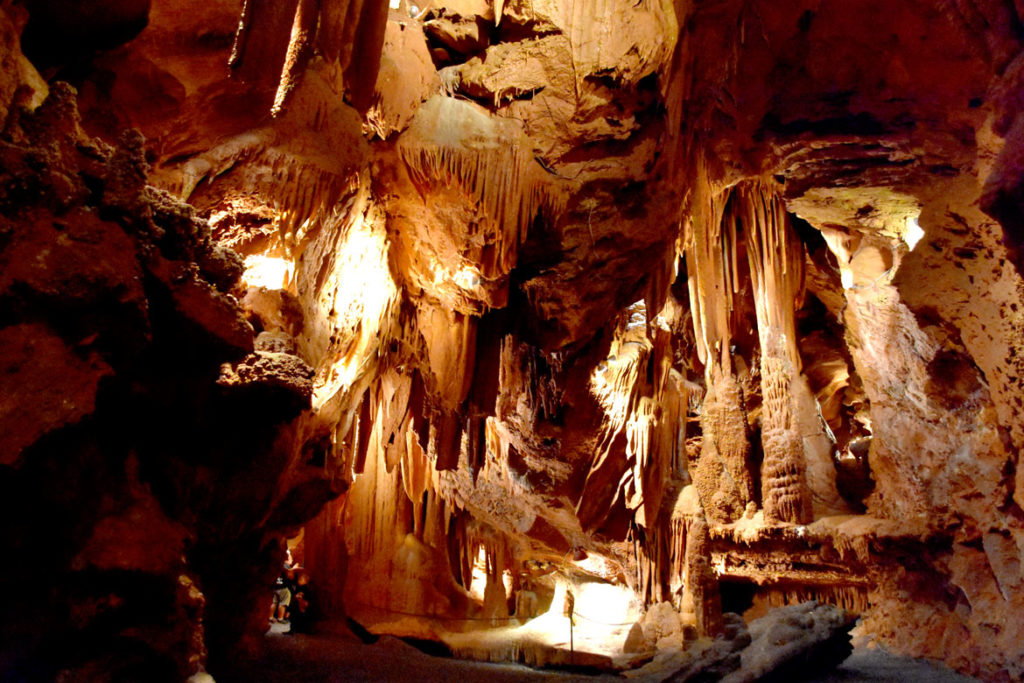
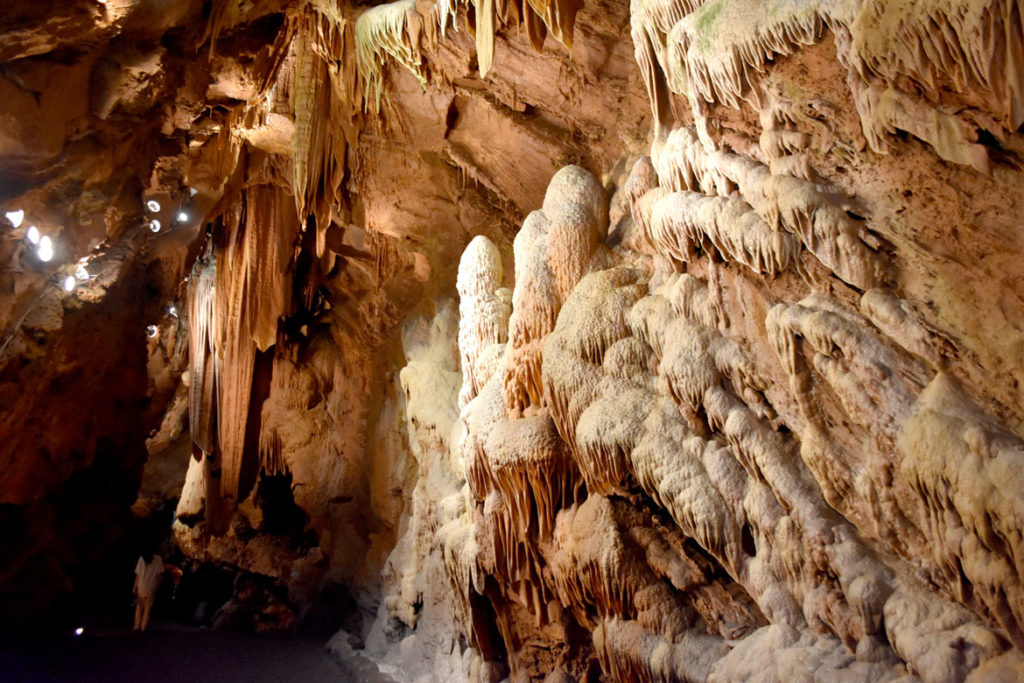
Shenandoah Caverns at Quicksburg, Virginia, offers a one mile-long guided tour through 17 underground cavern rooms named things like Capitol Dome, Rainbow Lake and Beyond the Veil. There are also formations that notably resemble bacon.
The cave was discovered in October 1884 and opened as a public attraction in May 1922.
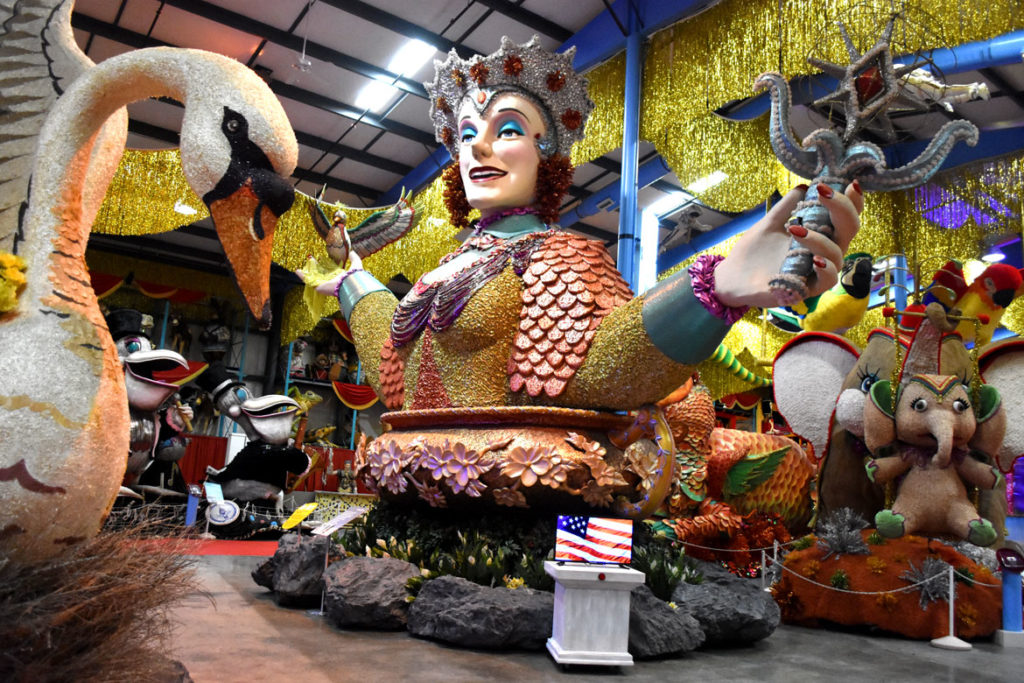
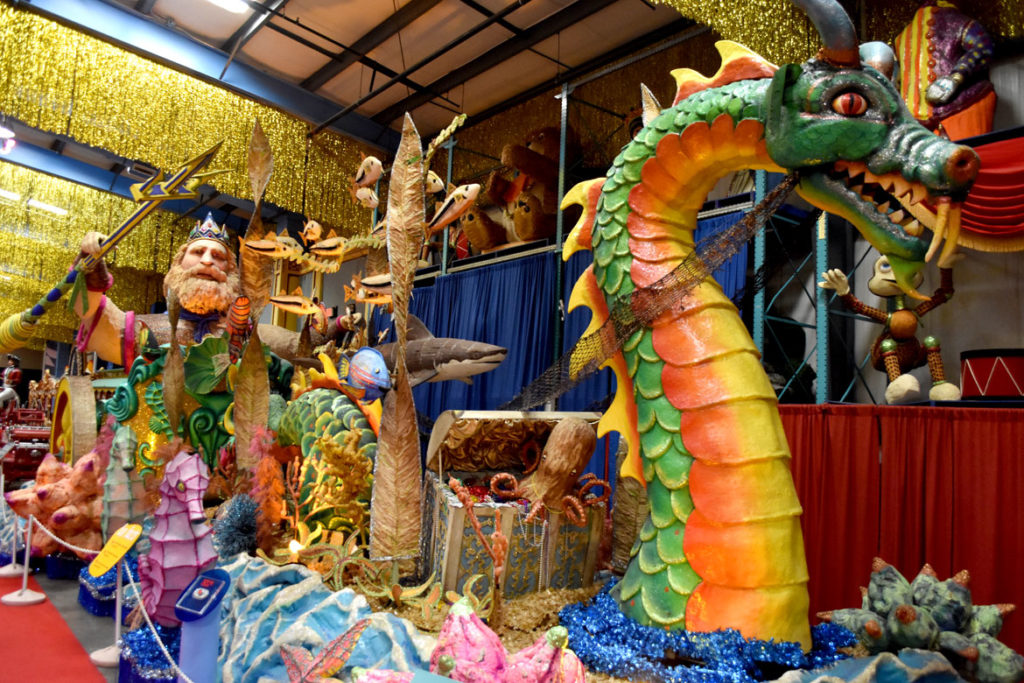

As you wait for your cave tour, you can wander the attraction’s Main Street of Yesteryear, which showcases antique department store holiday window displays from the 1940s and ’50s—from Cinderella’s ball to circuses.
Shenandoah Caverns also includes American Celebration on Parade, a warehouse filled with decades of mothballed floats from Presidential Inauguration Parades, Rose Parades, Miss America Pageant Parades and Philadelphia Thanksgiving Day Parades. They were made by the Hargrove company that currently runs Shenandoah Caverns and affiliated attractions.
Dinosaur Kingdom II at Natural Bridge, Virginia
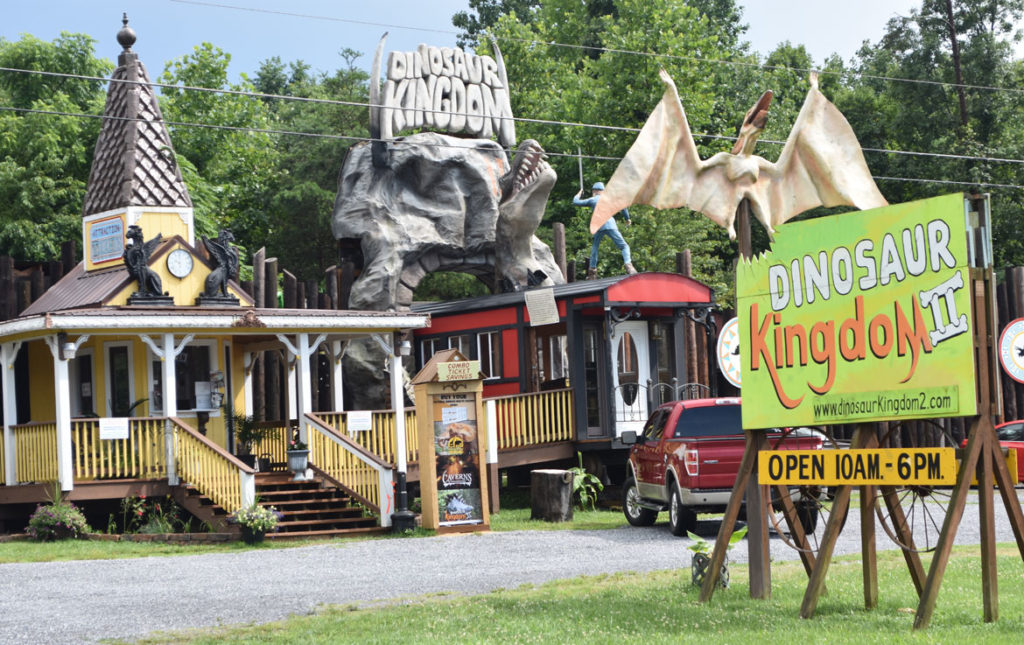
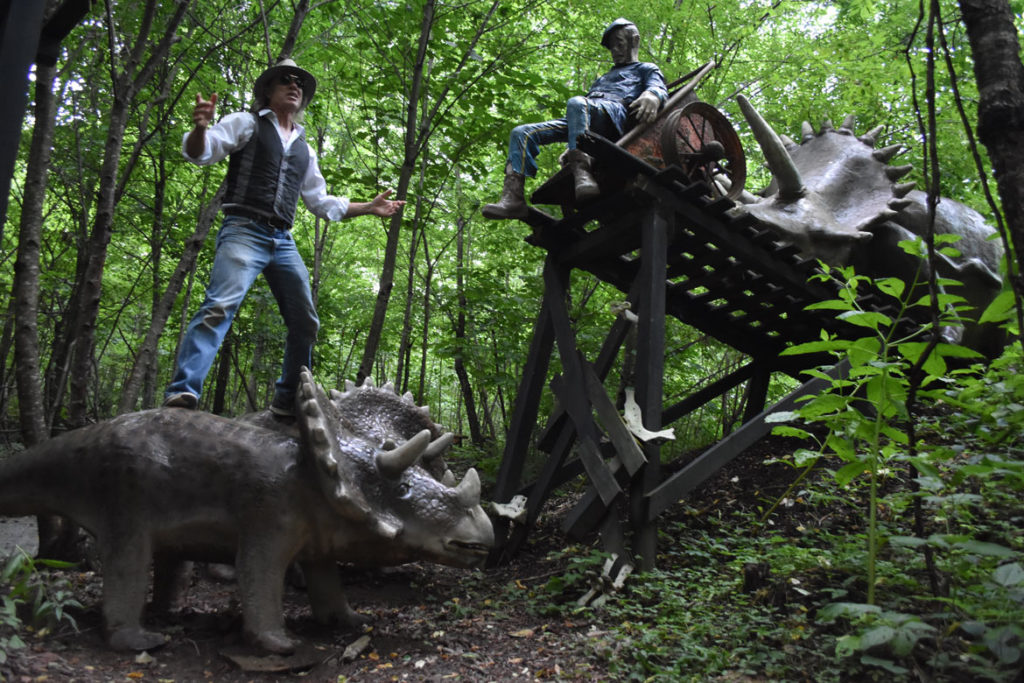
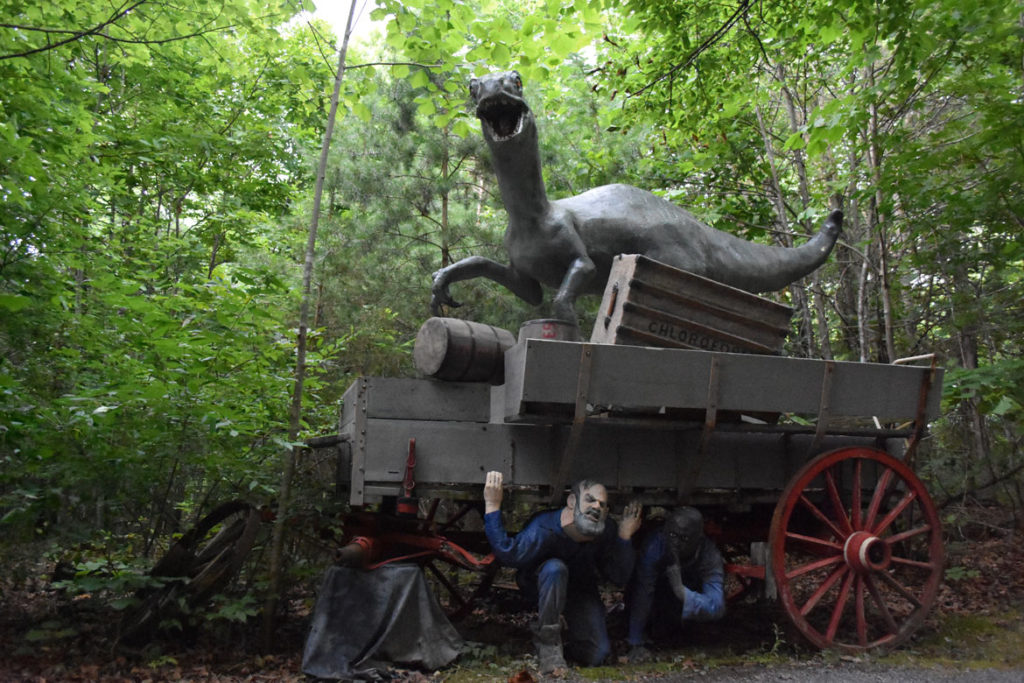
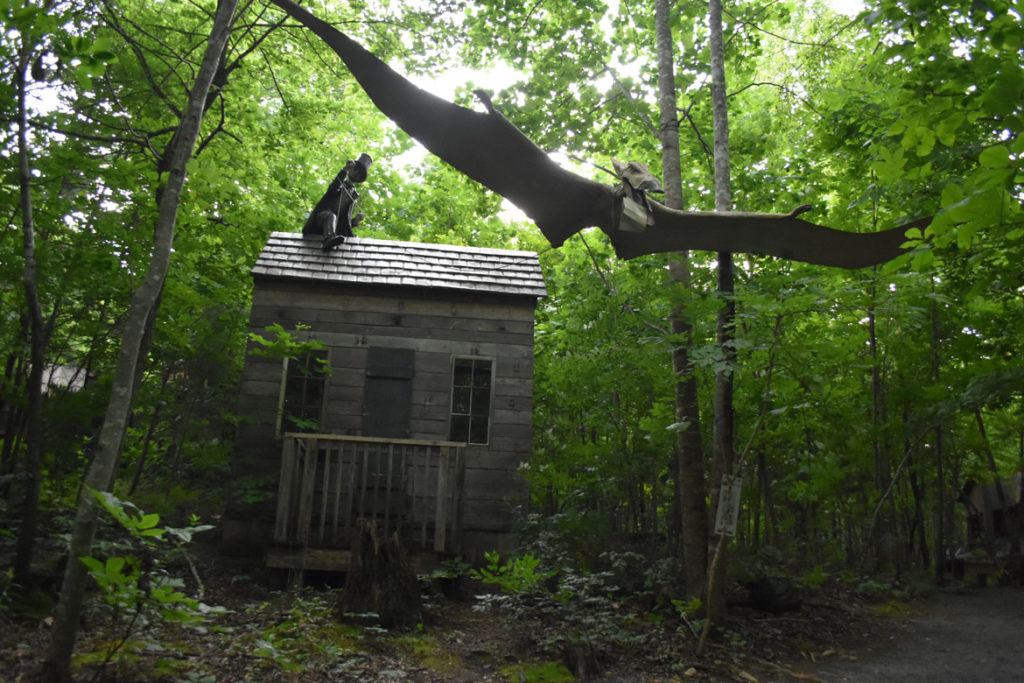
As you enter Mark Cline’s Dinosaur Kingdom II at Natural Bridge, Virginia, a sign explains: “It’s mid-June, 1864. General David Hunter has just raided and burned nearby Lexington and has continued maneuvering his troops toward Lynchburg. Several Union scouts have detoured near Natural Bridge and have discovered that their recent cannon fire has awakened PREHISTORIC CREATURES who have been cryogenically hibernating in a lost section of the Natural Bridge Caverns for millions of years. An idea forms to use these giant reptiles as WEAPONS OF MASS DESTRUCTION against the South. But, you will soon see that not everything goes as planned!”
Cline kindly gave us a tour. He’s the creator of several foam and fiberglass attractions including the Haunted Monster Museum and the original Dinosaur Kingdom, which both burned in 2012, as well as Foamhenge, which, as the name suggests, is Styrofoam replica of Stonehenge. Cline walked us down Dinosaur Kingdom II’s Western main street dubbed “Extinction Junction” and into the woods, where fiberglass Confederates and Union soldiers and dinosaurs battled it out.
“Them wacky Yankees is at it again! … But ole Dixie has more than a few tricks still left up her sleeve,” the website proclaims. “…Enter into a time tunnel and discover Stonewall Jackson battling a vicious spinosaurus! Get surrounded by deadly meat eaters! See Abe Lincoln after he’s lassoed a pteranodon chewing up the Gettysburg address! Witness a stegosaurus being milked!”
Bassett, Virginia
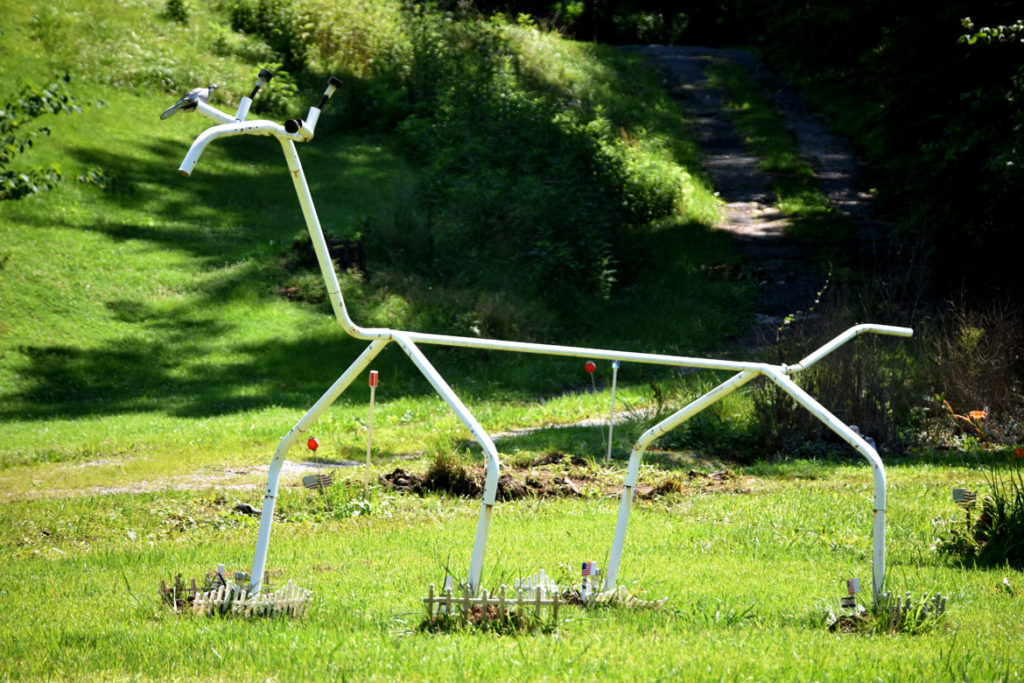
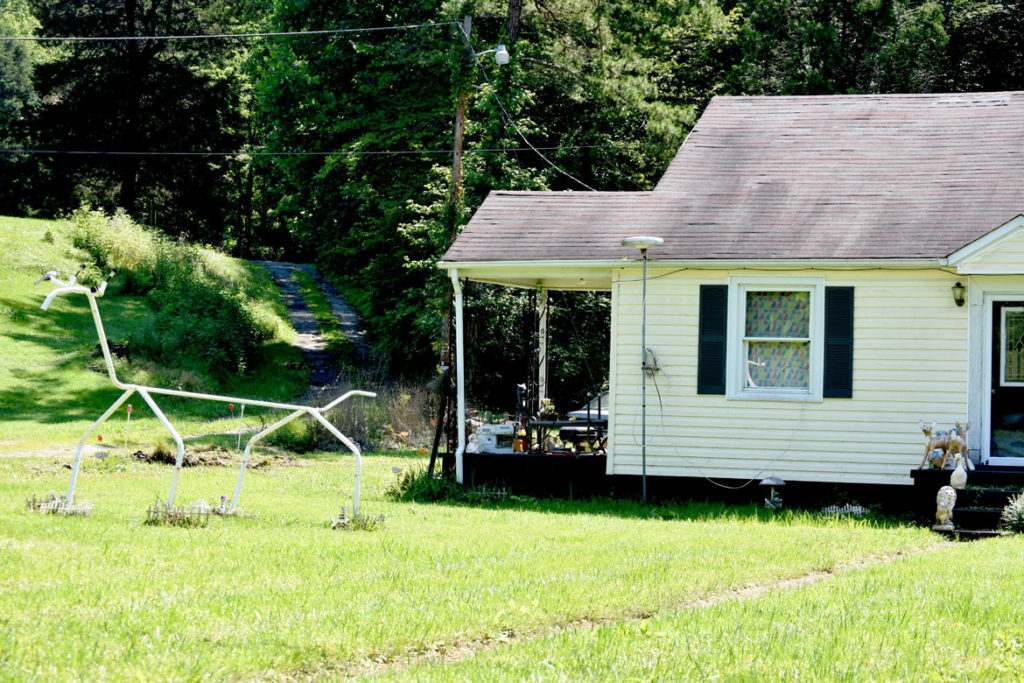
International Civil Rights Center & Museum in Greensboro, North Carolina
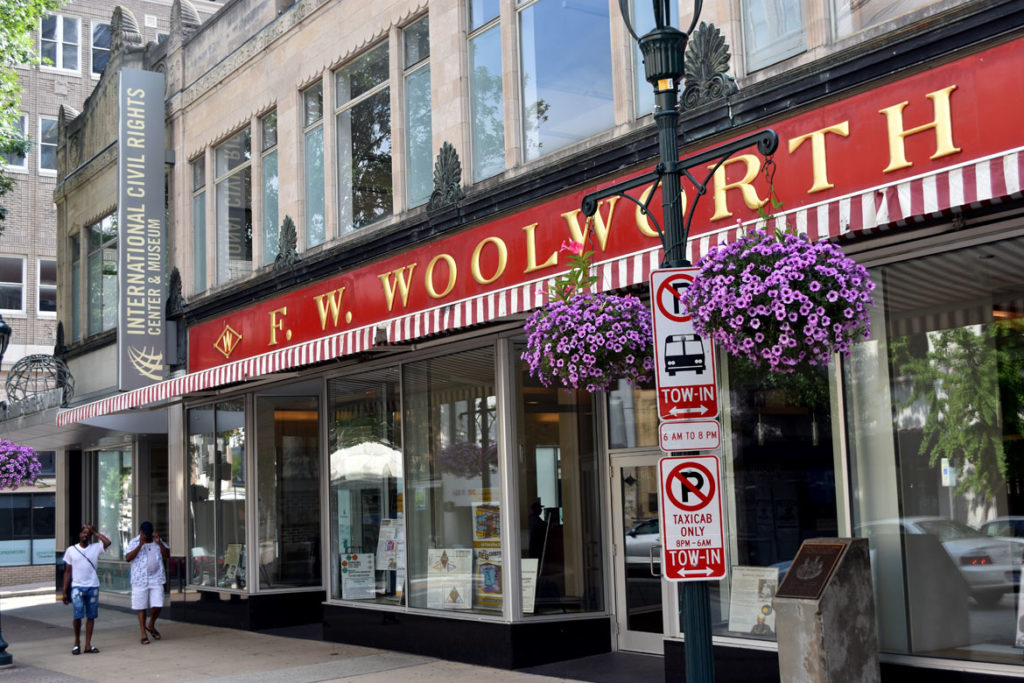
In February 1960, four freshmen from North Carolina Agricultural and Technical State University sat down at the “whites only” lunch counter at the F.W. Woolworth store in Greensboro, North Carolina, to challenge racist segregation laws. Ezell A. Blair Jr. (now Jibreel Khazan), Franklin E. McCain, Joseph A. McNeil and David L. Richmond were soon joined by hundreds of students, civil rights organizations, churches and community members in a six-month-long protest—that inspired similar sit-ins to desegregate businesses all across the American South. The Greensboro protest reduced business so much at the Woolworth that management finally desegregated the lunch counter on July 25, 1960. The sit-in protests helped lead to the passage of the Civil Rights Act of 1964, outlawing racial segregation in public accommodations. Since the Greensboro store building closed in 1993, it has been turned into the International Civil Rights Center & Museum, which debuted in 2010, where you can see the original lunch counter where the protests began.
Elsewhere in Greensboro, North Carolina
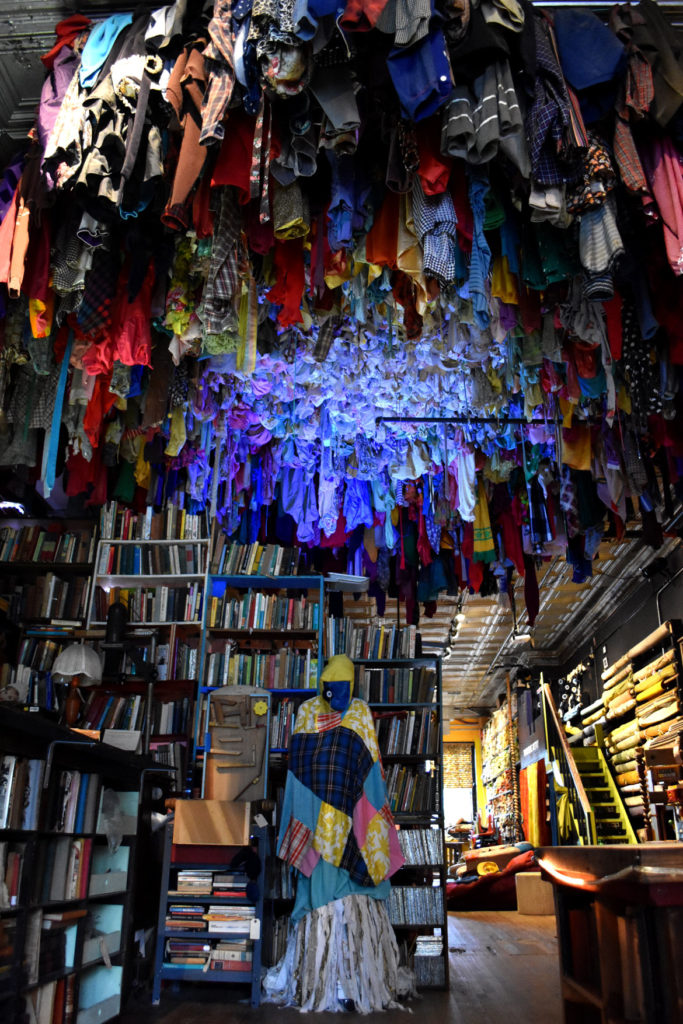
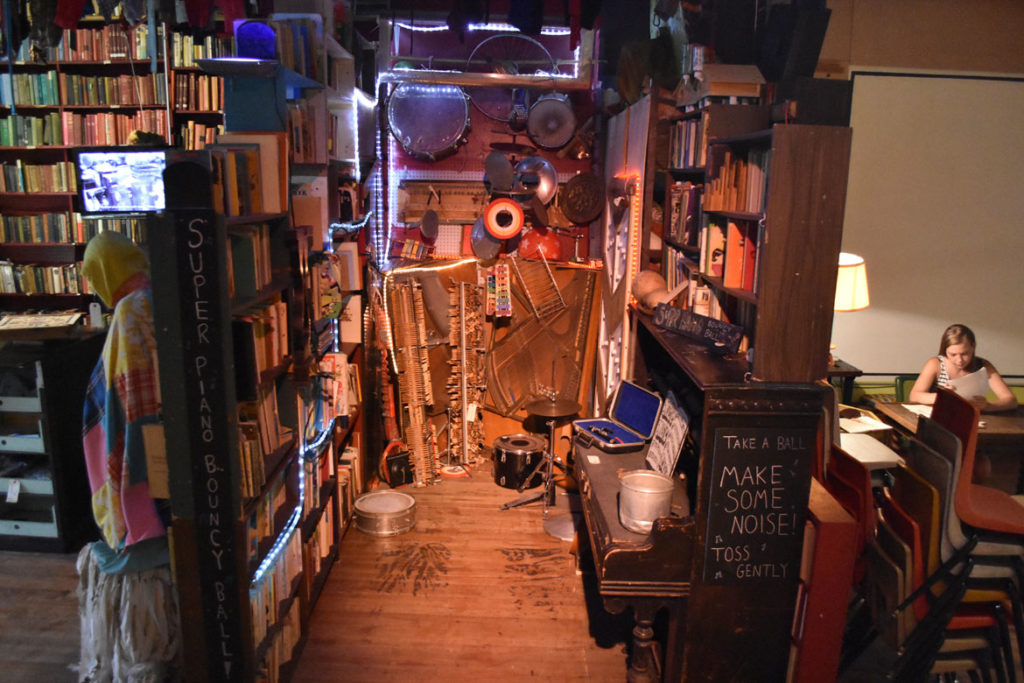
Elsewhere is a museum and artist residency that makes its home in the 3-floor, former thrift store that was operated Sylvia Gray in Greensboro, North Carolina. “Over time her inventory became more or less a collection, more or less a hoard, more or less an archive that detailed her tastes, interests, and perceptions of value,” the institution reports. “…The astounding accumulation amassed over her lifetime remained in a massive heap that was boarded up after her death in 1997.” Gray’s grandson George Scheer visited with friends on spring break from the University of Pennsylvania in 2003 and got the idea to transform it into … something. With friends’ help, they made it into a “living museum,” an art environment that is part shrine to Gray’s collecting and part “changing, interactive environment of artworks, objects, and programs that inspire new ways to look at and re-purpose recent cultural surplus.”
Körner’s Folly in Kernersville, North Carolina
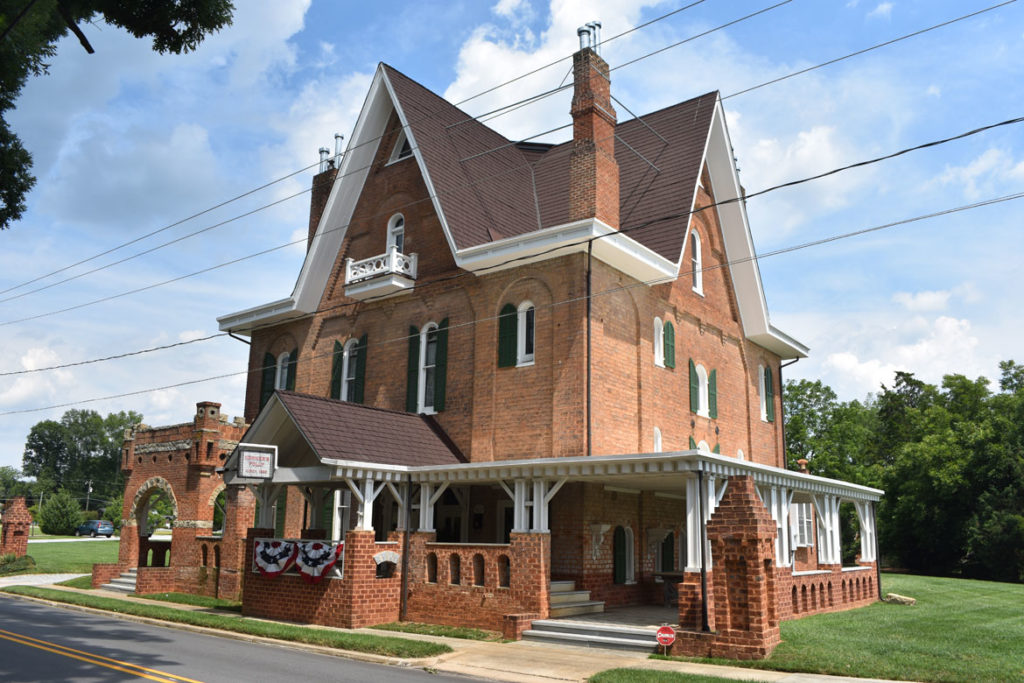
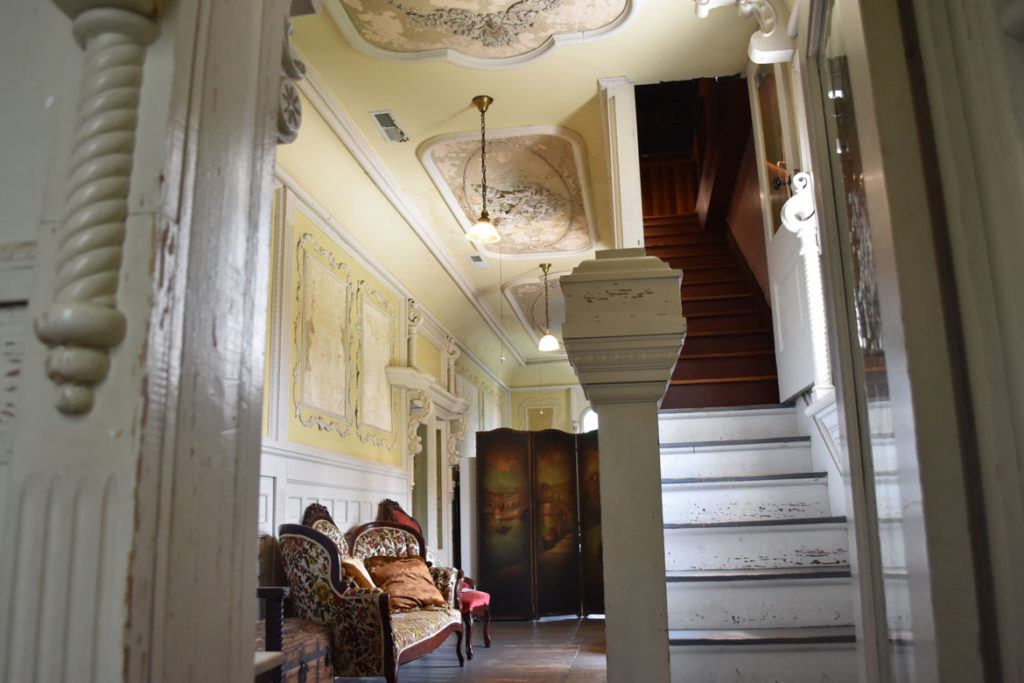
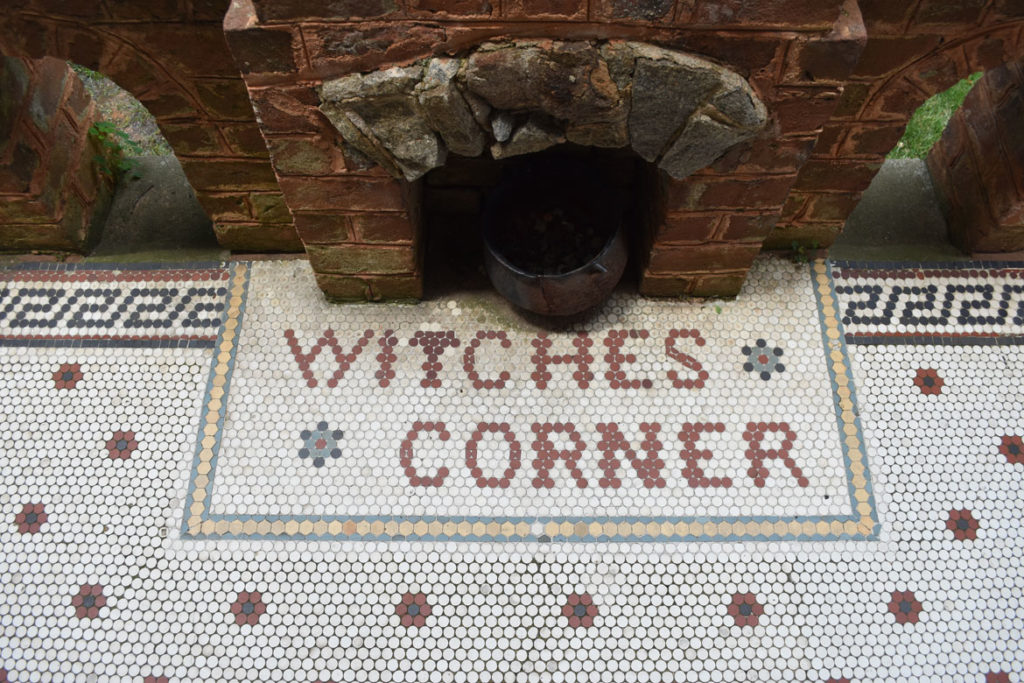
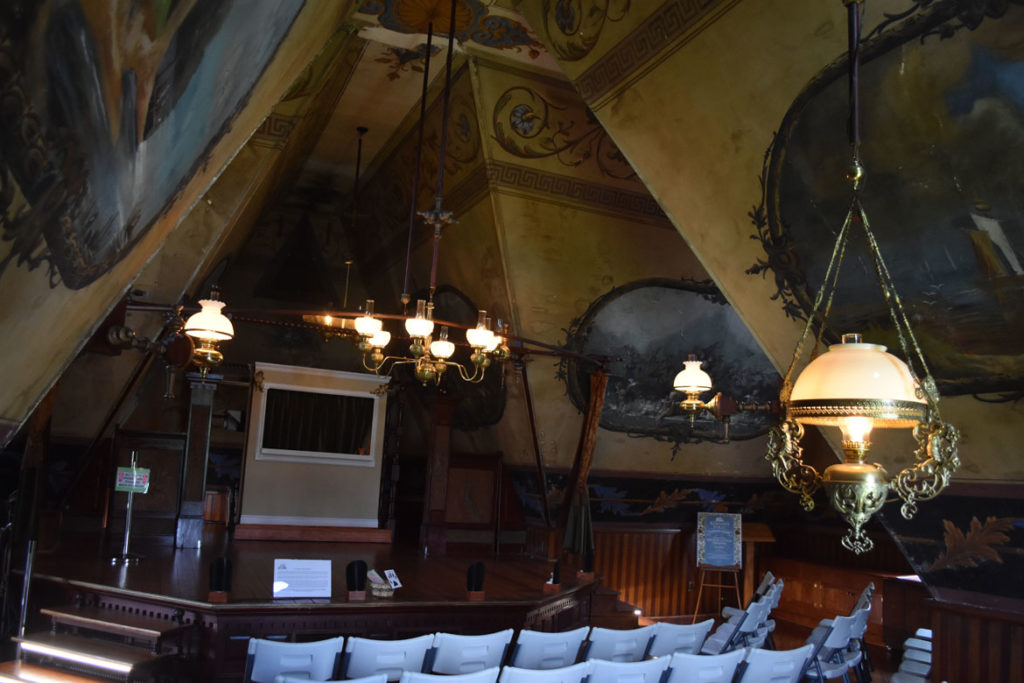
When artist and designer Jule Gilmer Körner began work in 1878 on what became known as Körner’s Folly in Kernersville, North Carolina, he intended it as a demonstration his interior design work for his clients. And he never stopped renovating it—creating 22 unique rooms spread out over three floors and seven levels, some just 5 ½ feet tall and designed for children, to a reception room and, perched in the top floor, Cupid’s Park Theater with ceilings soaring more than 20 feet tall.
Asheville, North Carolina
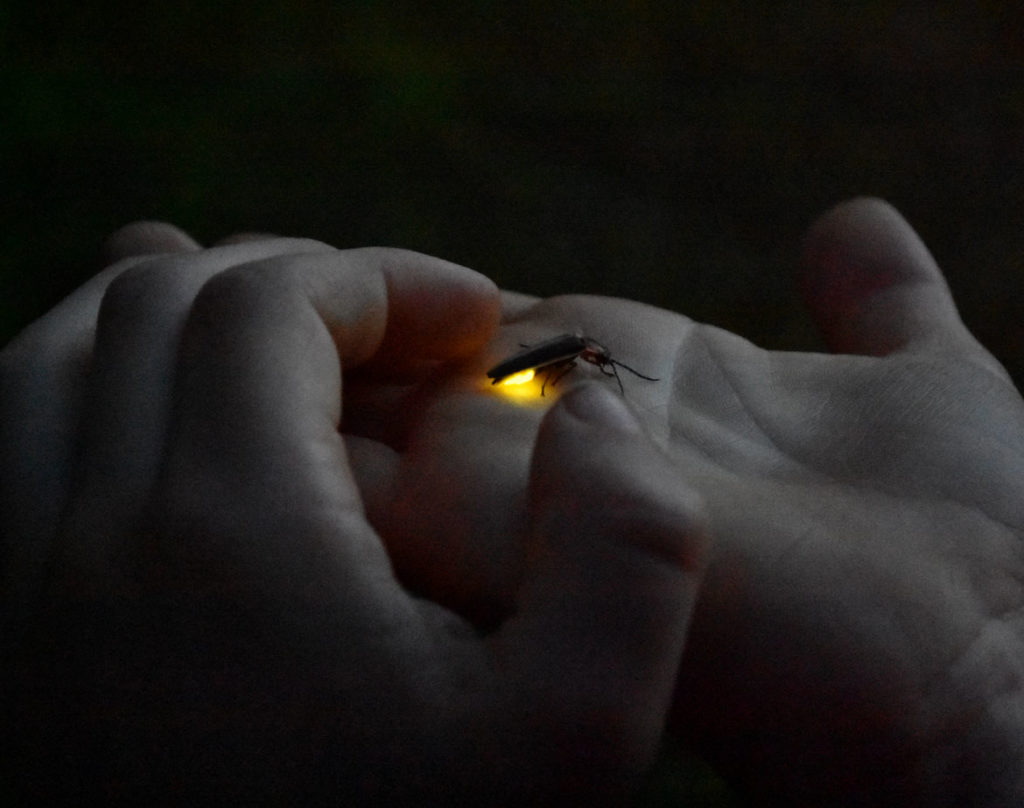
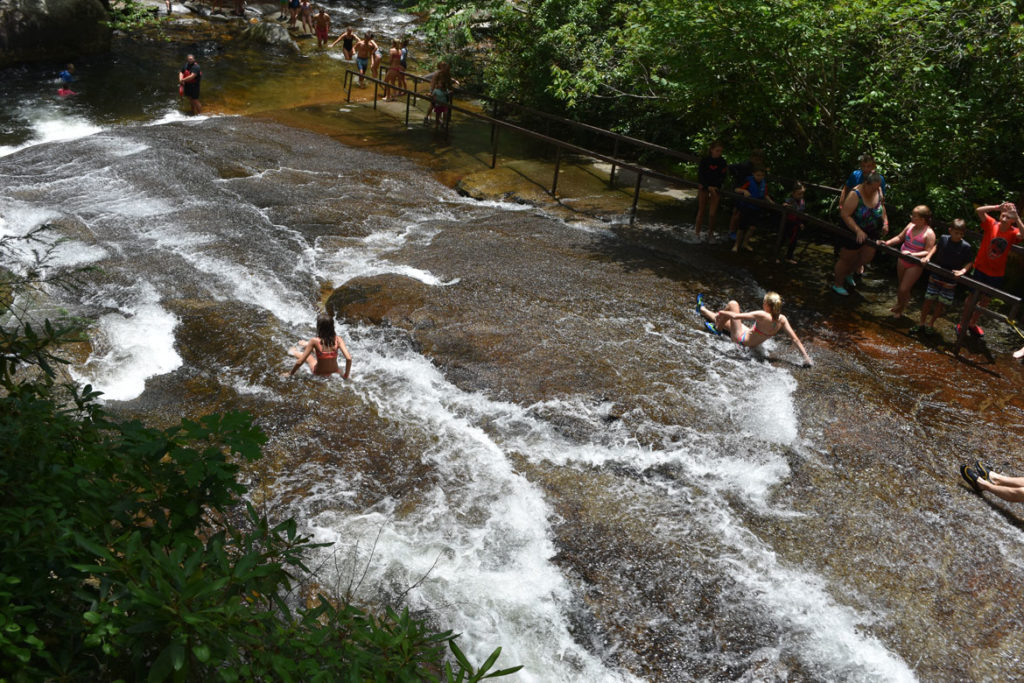
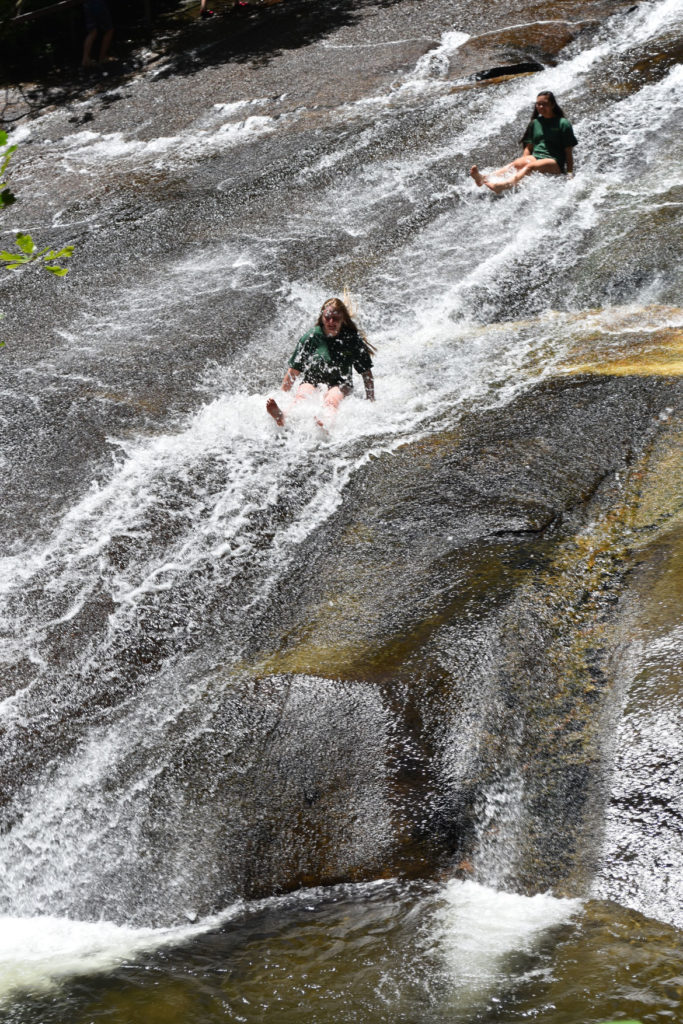
Sliding Rock is a 60-foot-long natural waterslide in Pisgah National Forest just north of Brevard, North Carolina, and about an hour southwest of Asheville. The exhilarating/harrowing slide dumps you into a chilly 50 to 60 degree pool at the bottom.
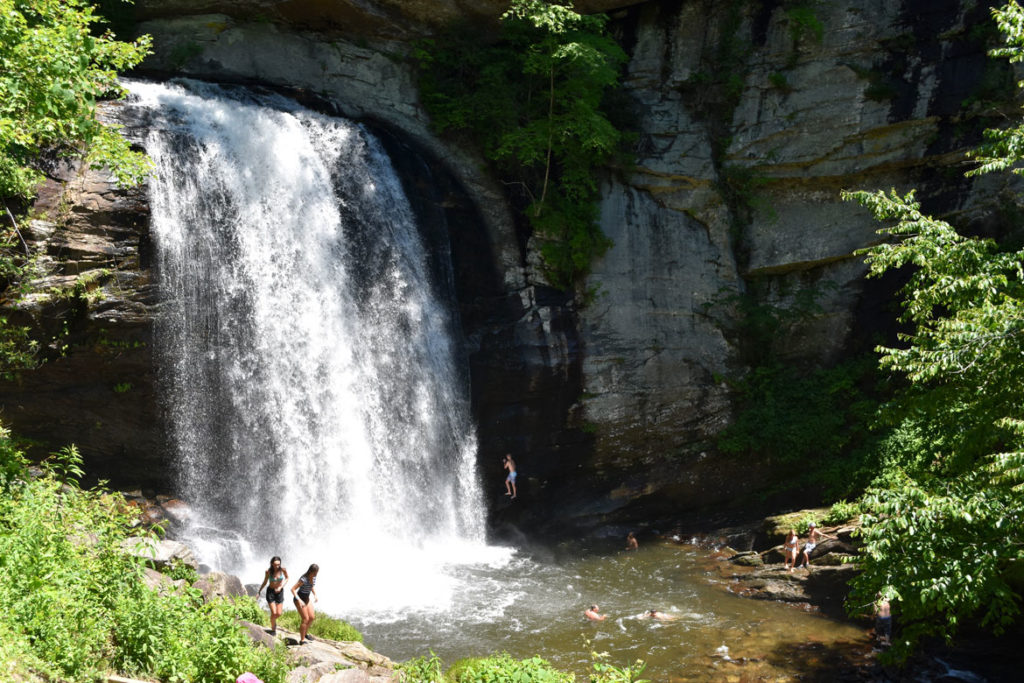
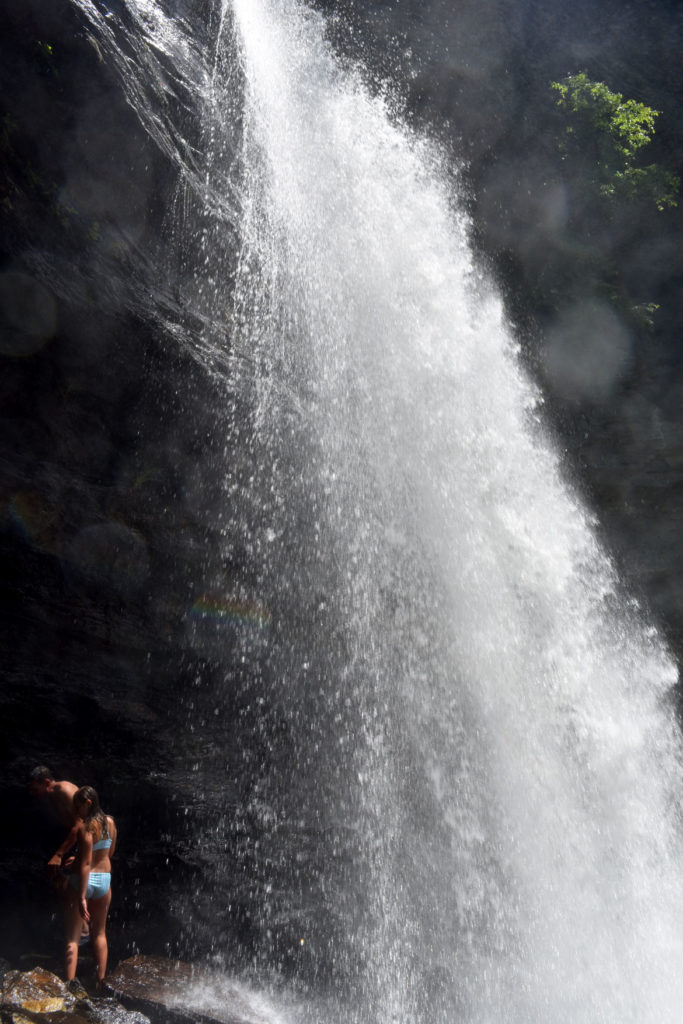
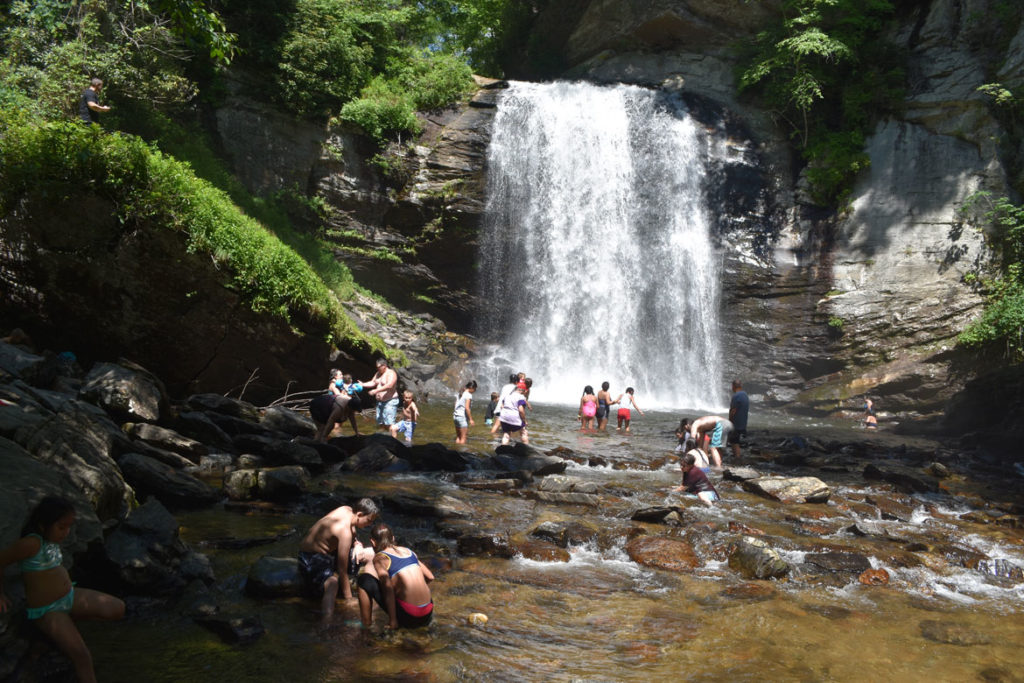
Nearby Looking Glass Falls is a 60-foot-tall waterfall in Pisgah National Forest just north of Brevard, North Carolina, and about an hour southwest of Asheville.
Cherokee, North Carolina
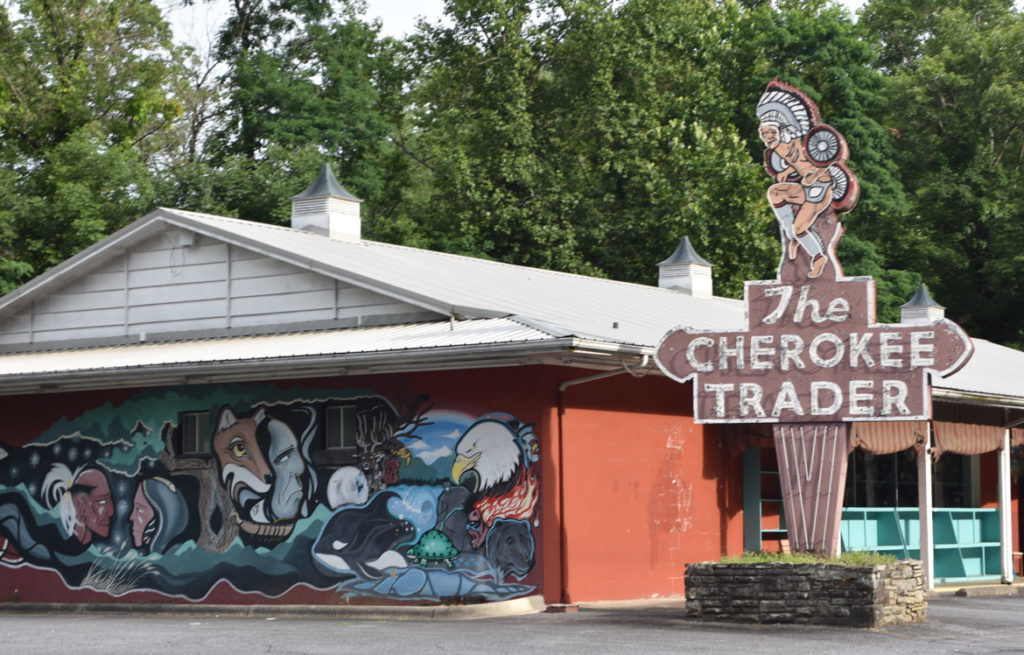
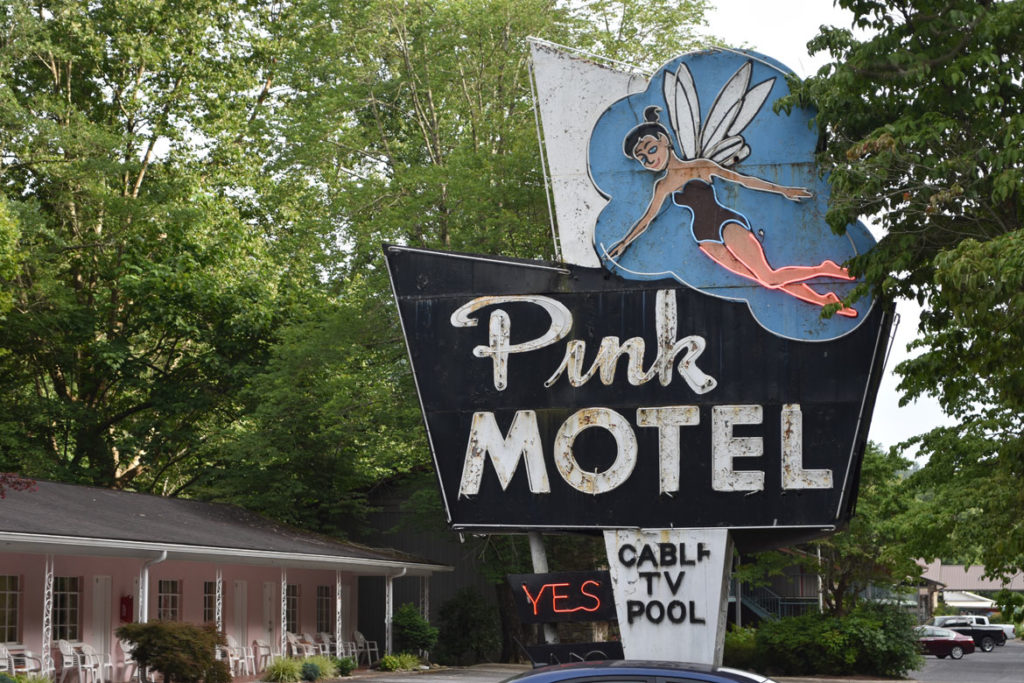
Oconaluftee Visitor Center at Great Smoky Mountains National Park, North Carolina
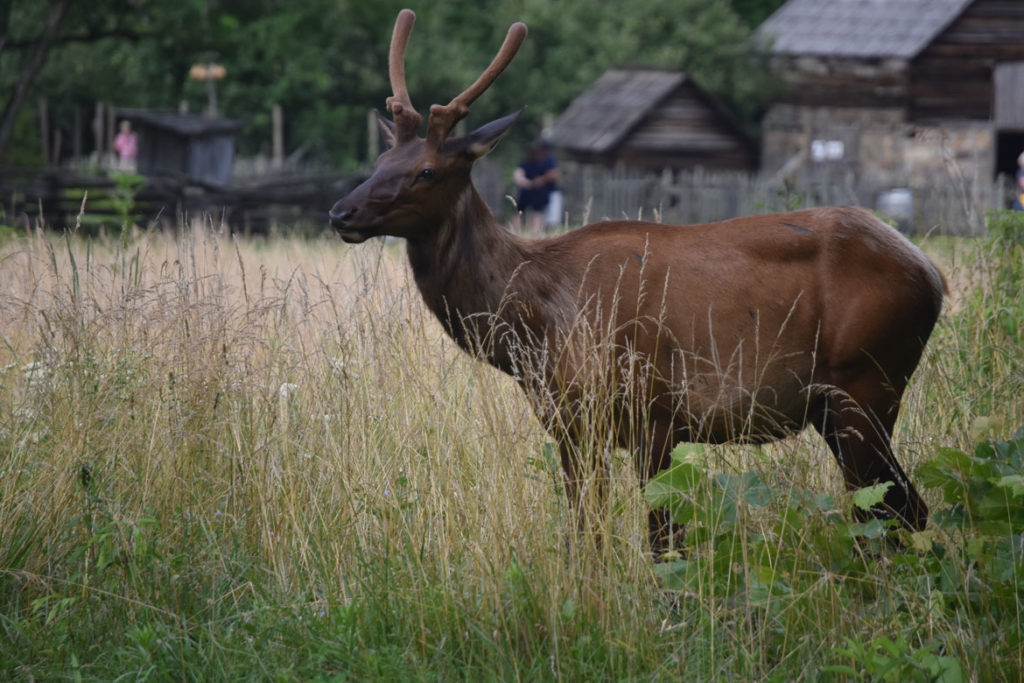
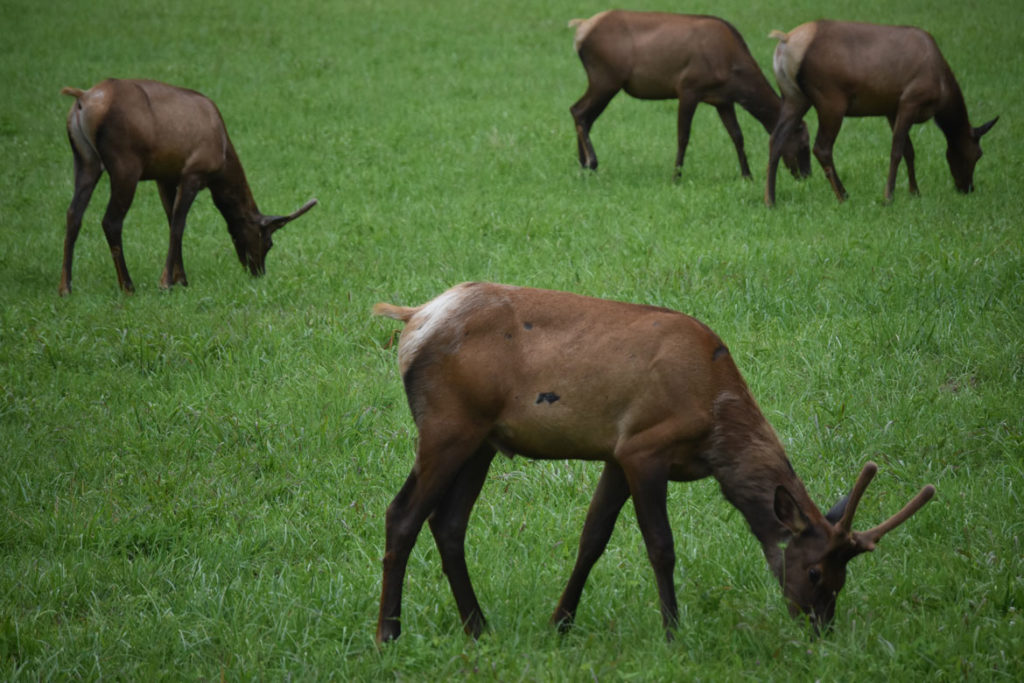
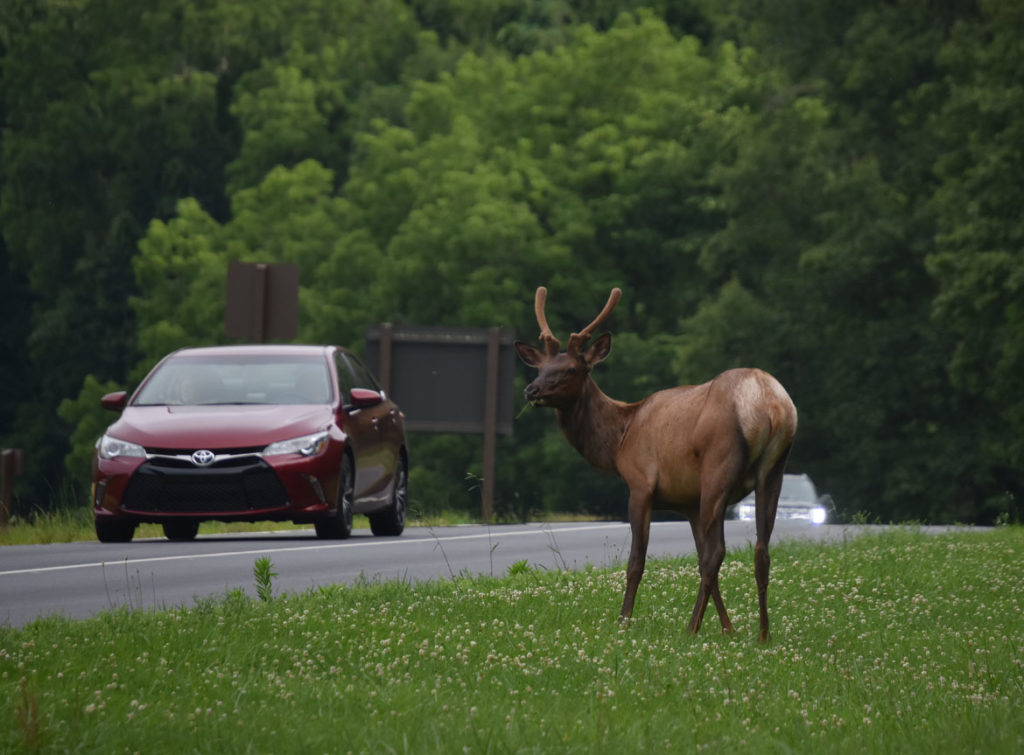
Great Smoky Mountains National Park
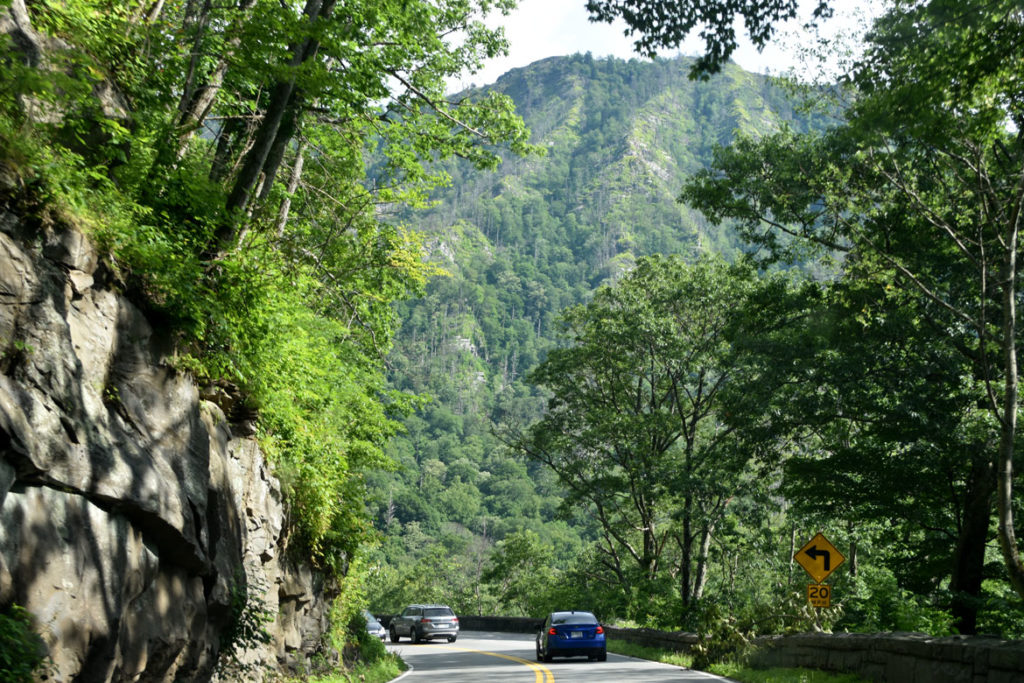
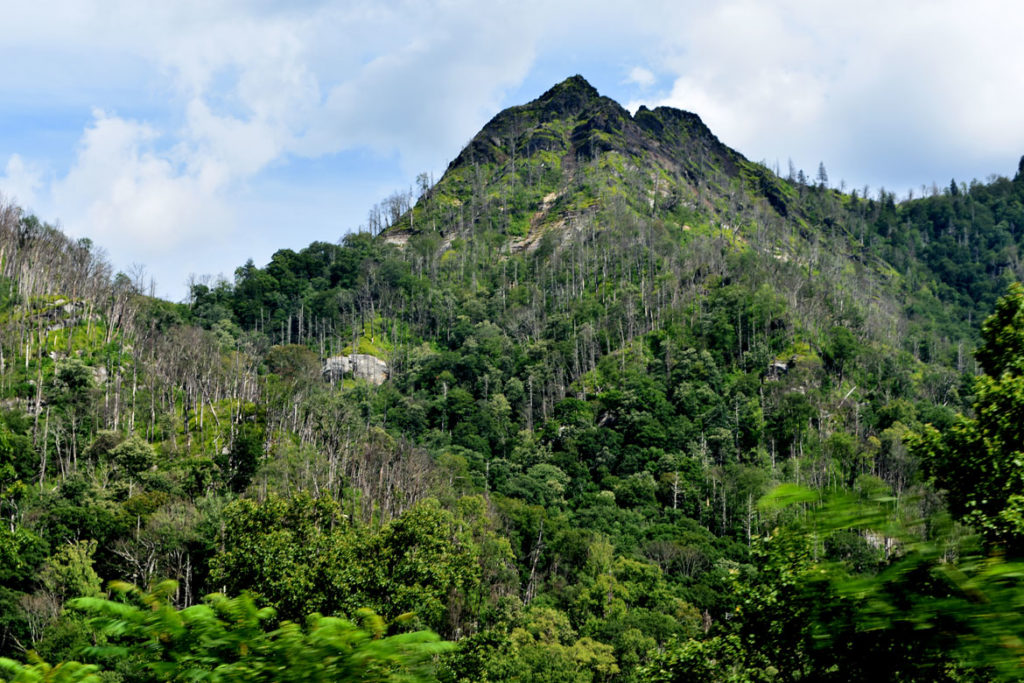
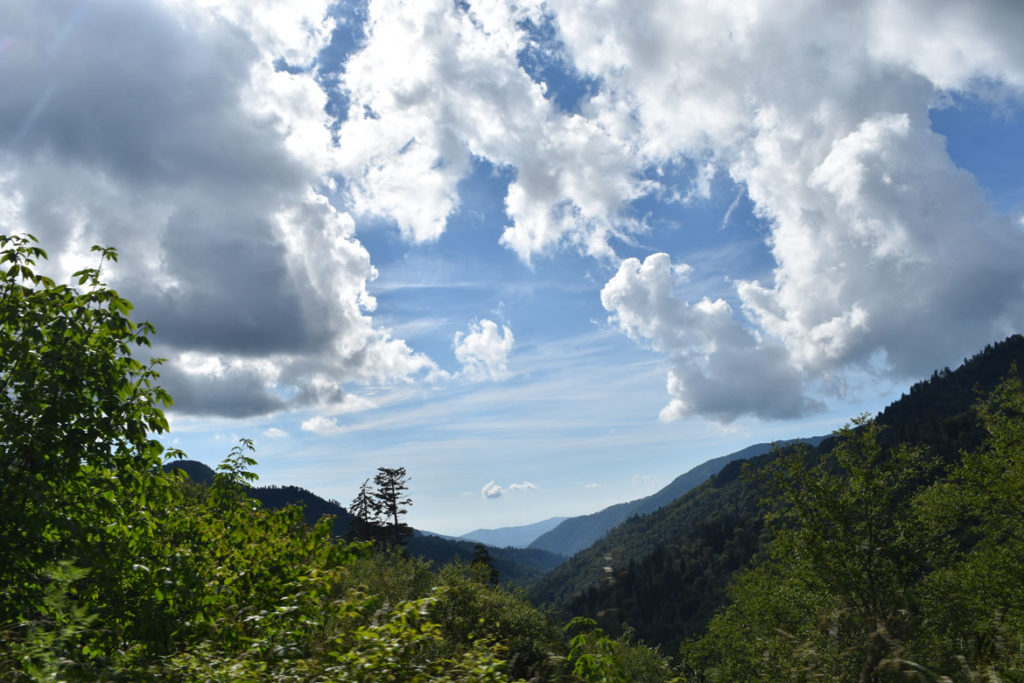
Gatlinburg, Tennessee

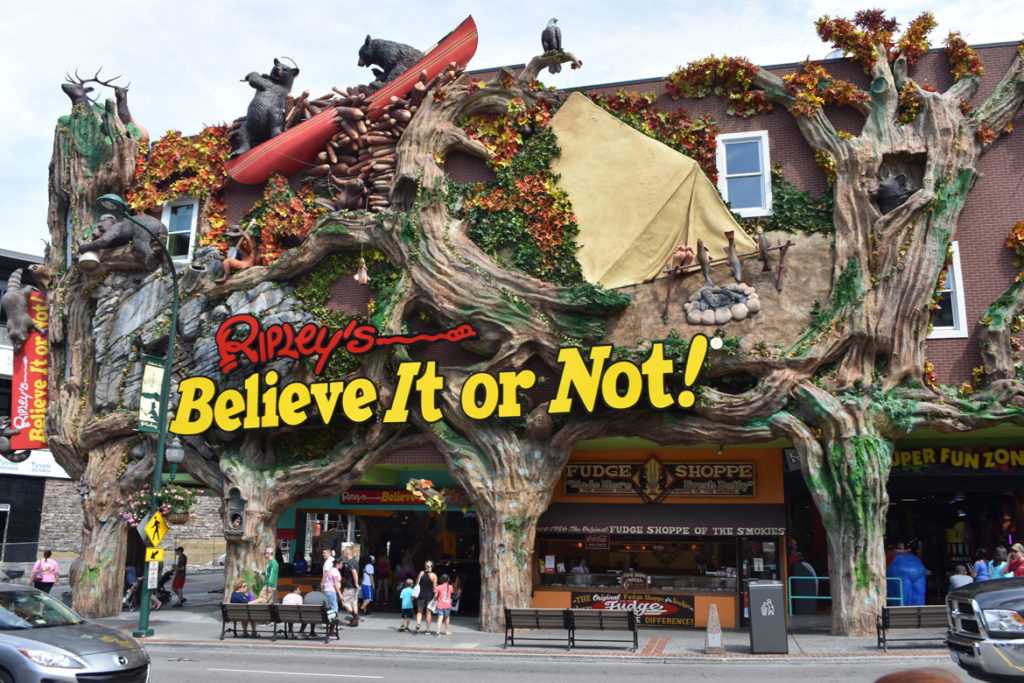
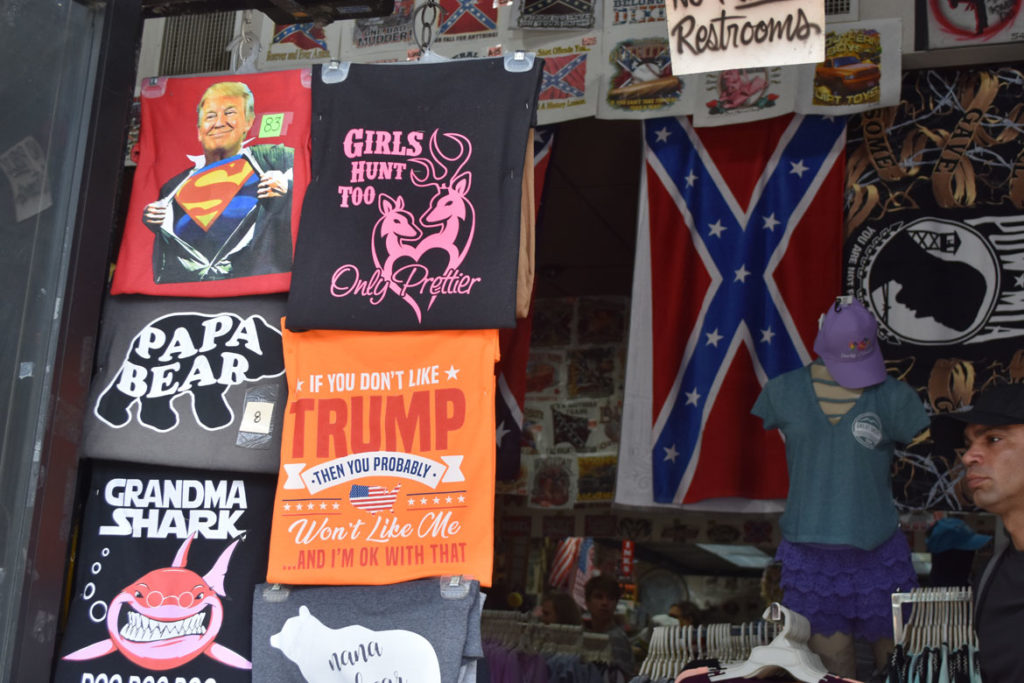
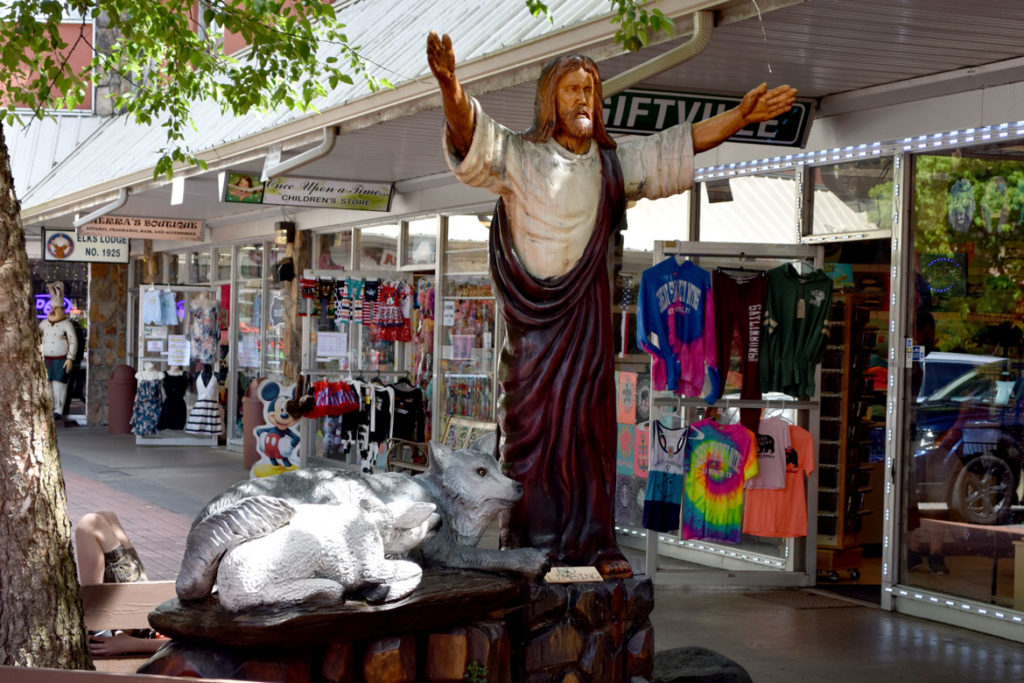
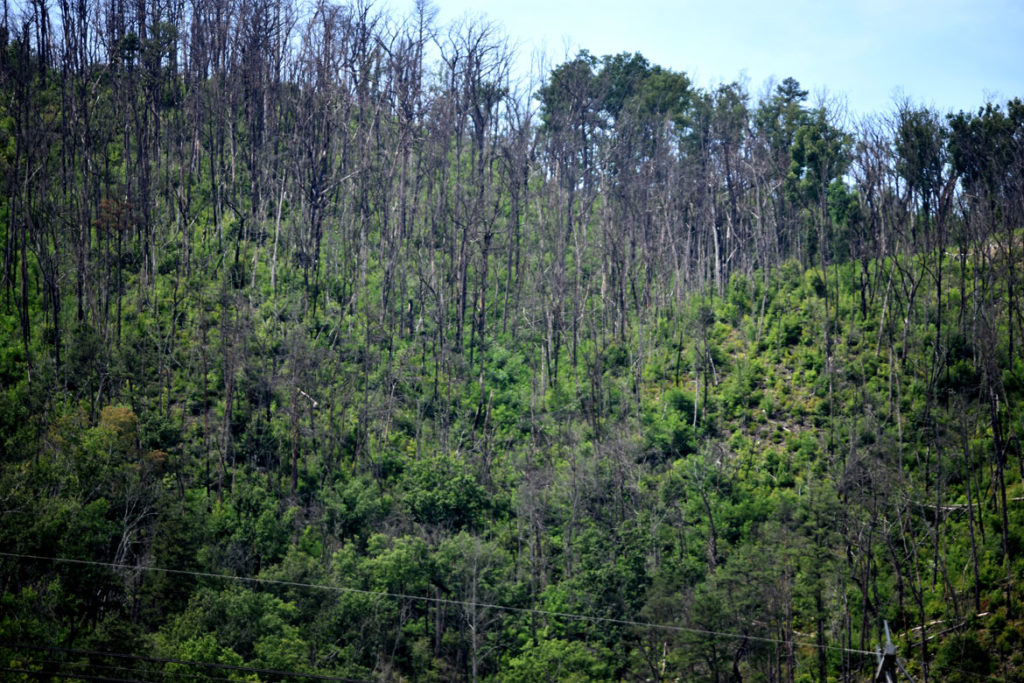
Pigeon Forge, Tennessee
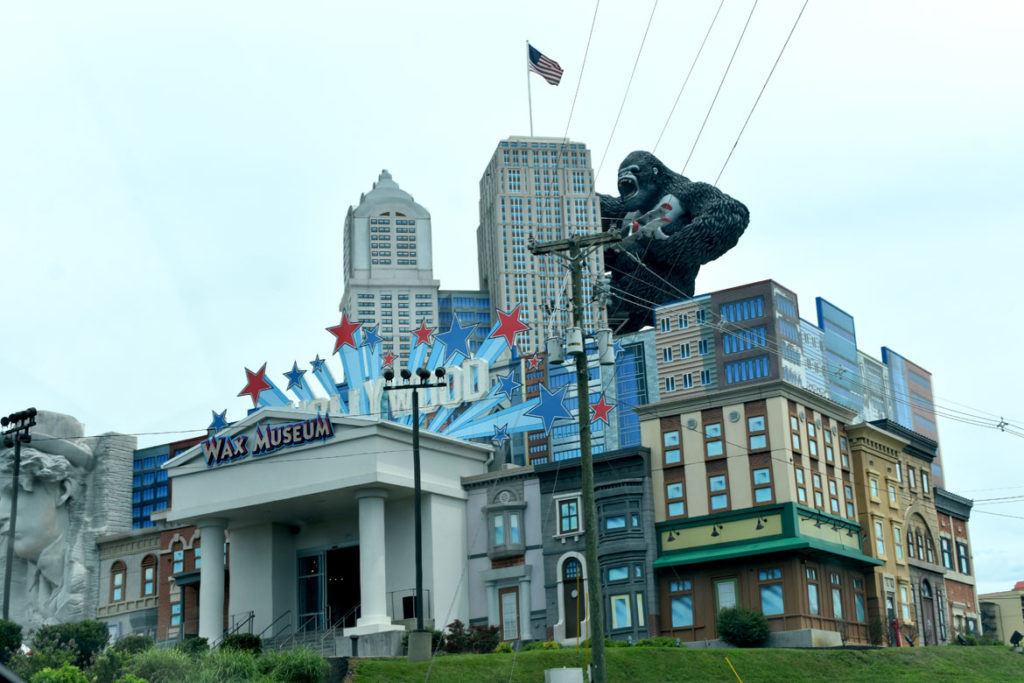
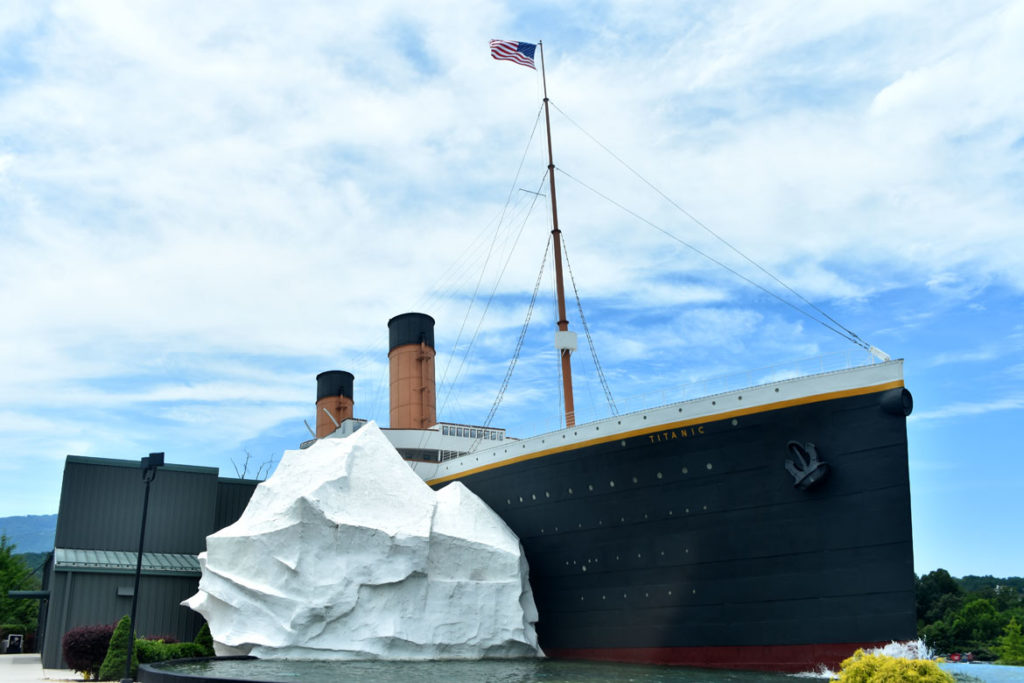
Rock City at Lookout Mountain, Georgia
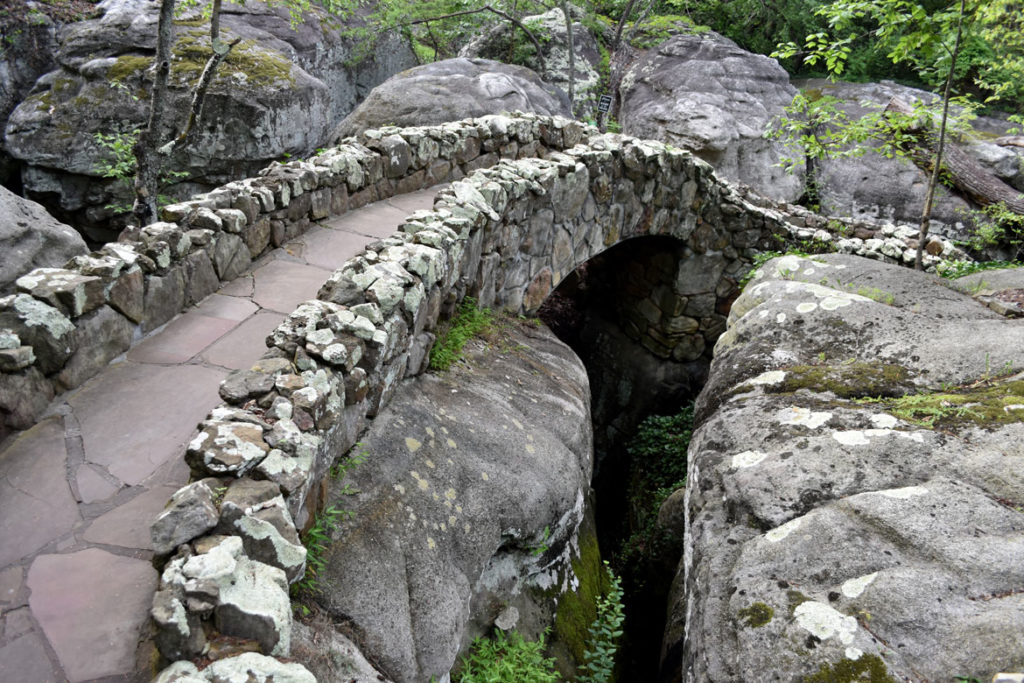
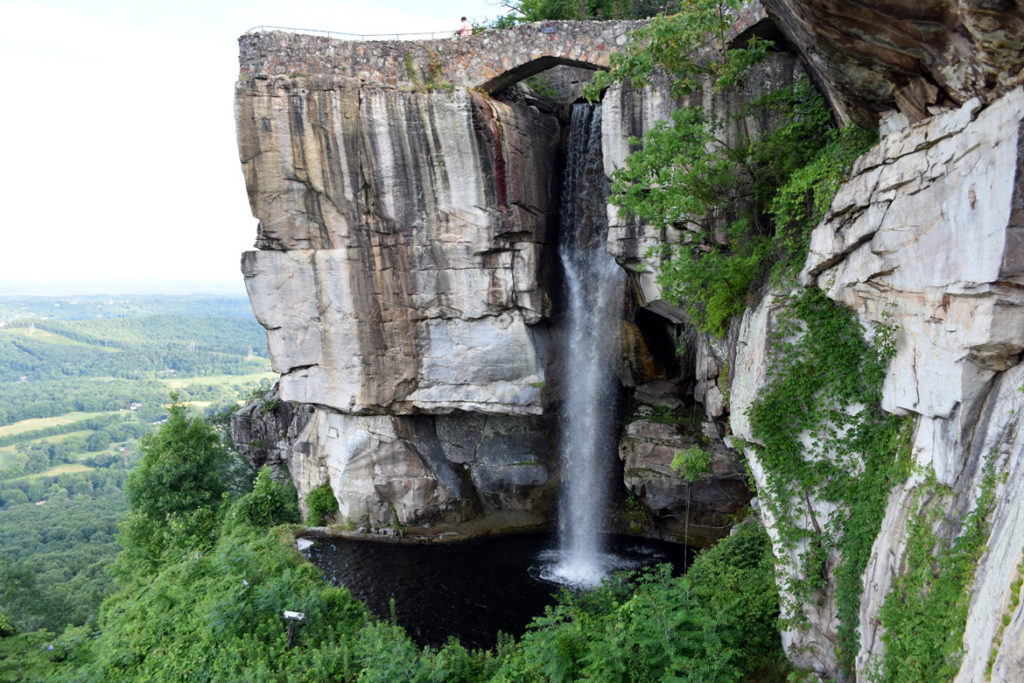
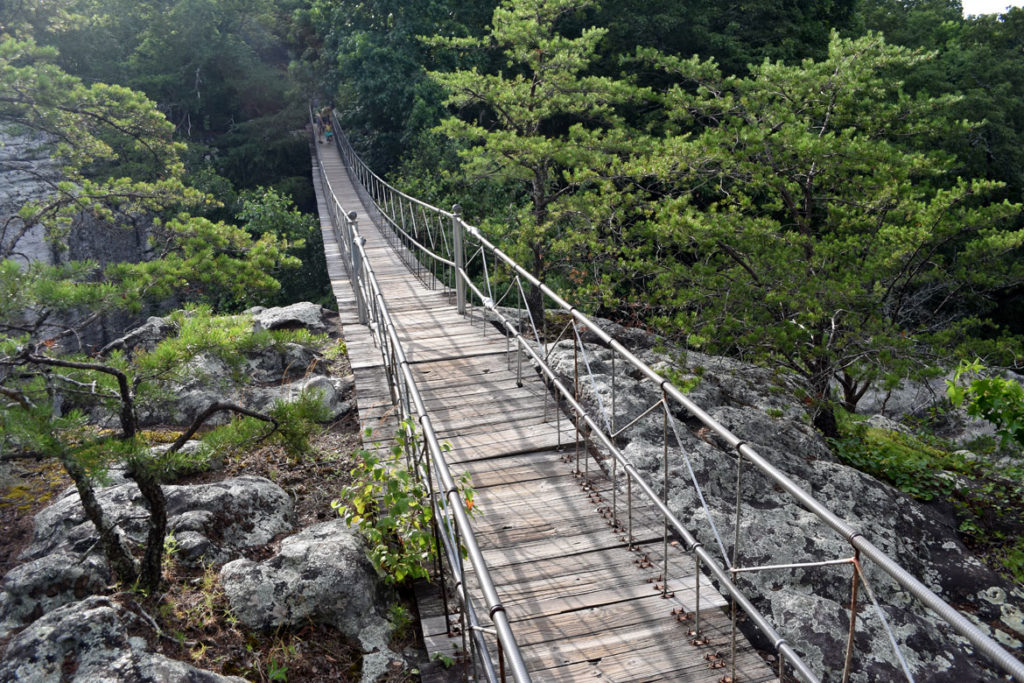
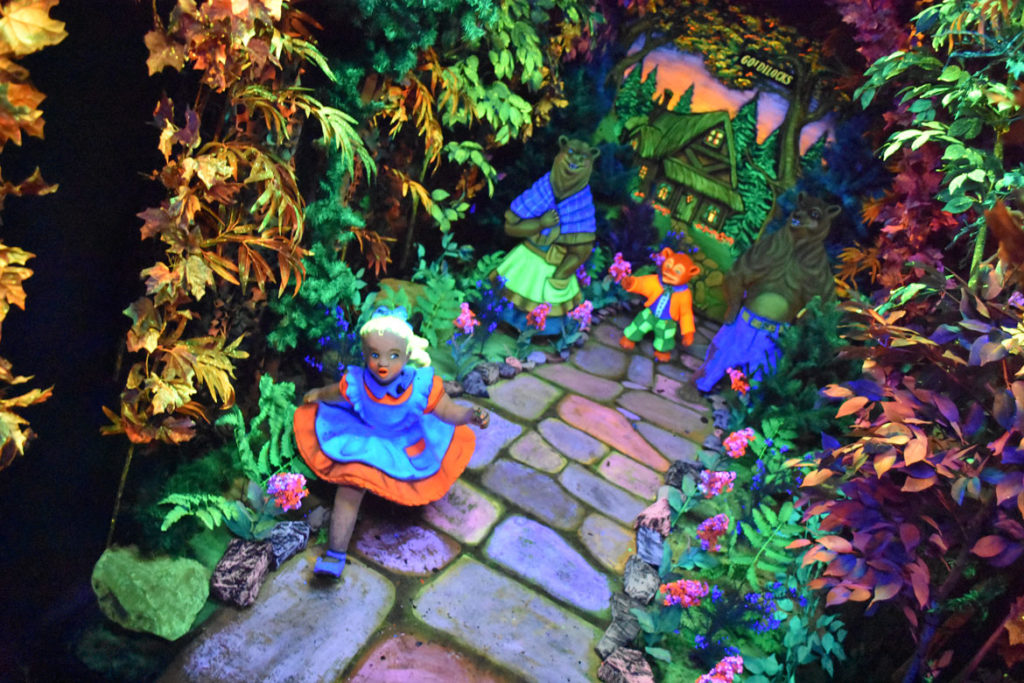
In 1924, Garnet Carter and his wife Frieda constructed a residential neighborhood on the top of Lookout Mountain, Georgia, the site of the Civil War battle. They called their development Fairyland, inspired by Frieda’s love of European folklore. Mr. Carter planned a golf course for the place, but as construction was delayed, he built what’s billed as the “nation’s first miniature golf course.” Garnet franchised the mini golf concept across the United States, while Frieda dreamed up a path winding through rock formations atop Lookout Mountain, ending at an overlook dubbed “Lover’s Leap.” She transplanted wildflowers along the boulders and canyons and punctuated the journey with statues of gnomes and fairytale characters. Rock City, as they called it, opened to the public on May 21, 1932. Today, it’s a soothing stroll though narrow canyons, over stone bridges and past splashing brooks. Atmospheric music is piped in along the way. Finally, you arrive at that monumental outcropping with a waterfall crashing down the side and, they say, a view of seven states. To attract visitors to this out-of-the-way location, Mr. Carter hired a sign painter by name of Clark Byers to paint barns from Michigan to Texas for free—in exchange for letting him paint the words “See Rock City” across the structures. The slogan became a classic of roadside advertising. The tour of Rock City ends with you descending into Fairyland Caverns and Mother Goose Village, black-light fairytale dioramas added in the 1960s. Some feel they clash with the calming natural surroundings, but the eye-popping displays have a dazzle all their own.
Howard Finster’s Paradise Garden at Summerville, Georgia
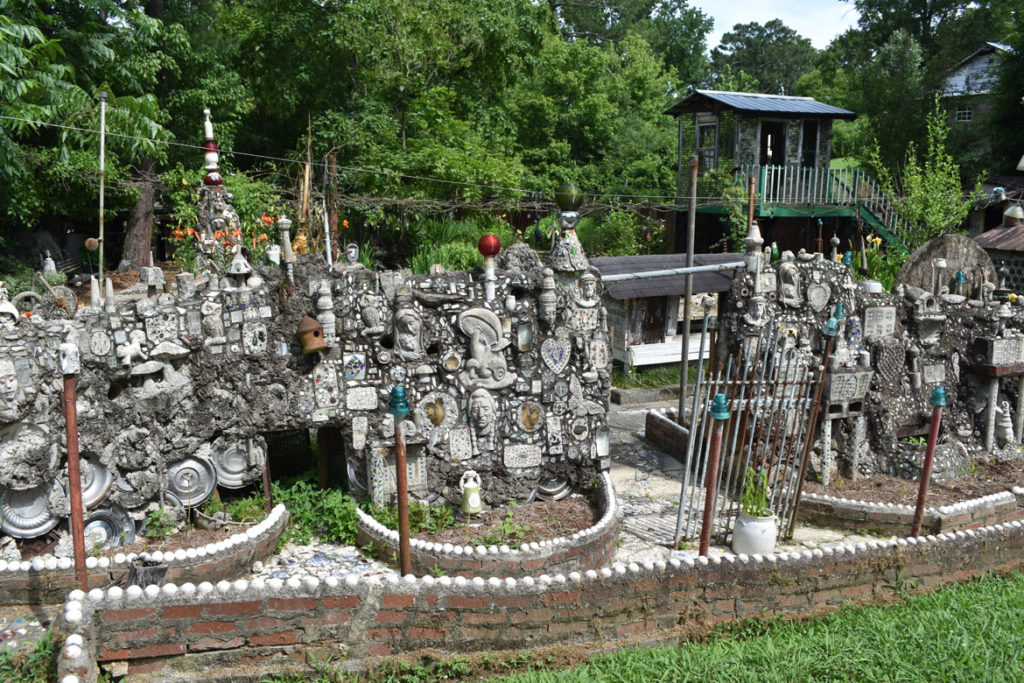
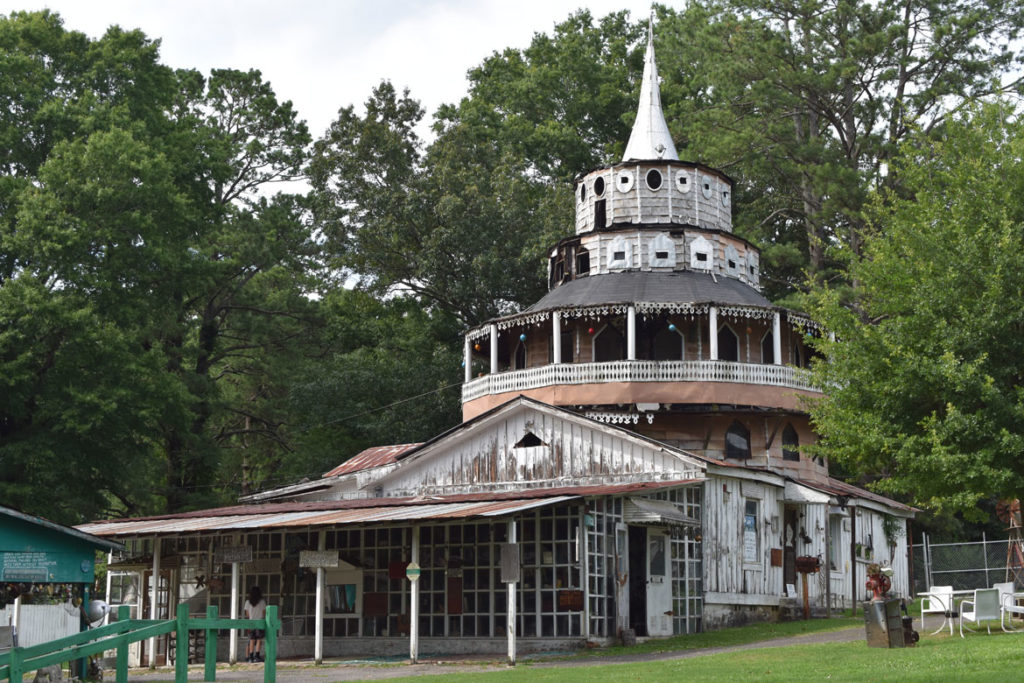
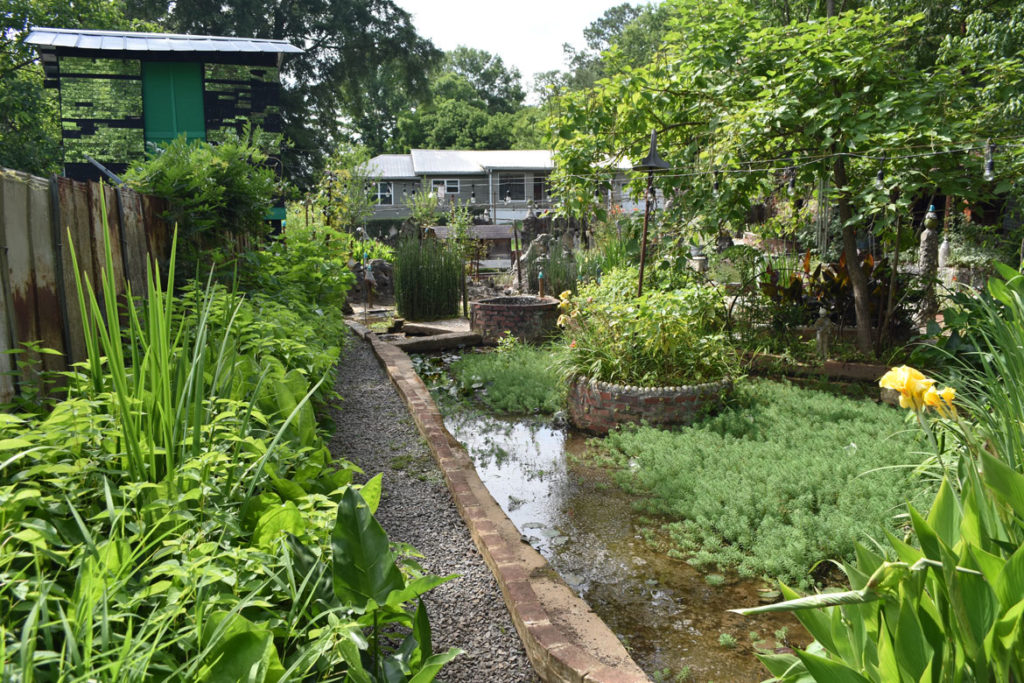
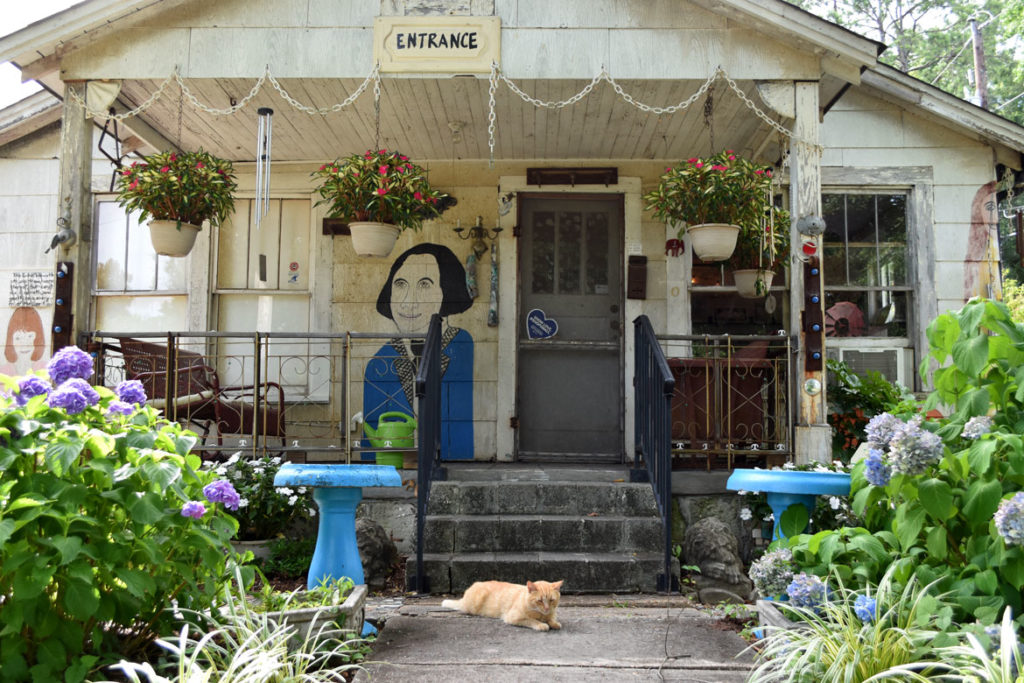
In 1961, minister and repairman Howard Finster (1916-2001) bought four acres of waterlogged land at Pennville, Georgia. People had used the place as a dump. Finster channeled the water and cleaned up the trash—some of which he used to create art. “I took the pieces, you threw away, and put them together by night, and day, washed by rain, dried by sun, a million pieces all in one,” he proclaimed. Beginning in 1945, he had constructed a garden museum at his home in Trion, Georgia, featuring models of houses and churches and celebrating human invention. Some of these constructions served as the foundation for his Plant Farm Museum, now known as Paradise Garden. “It is a place to meet with God,” Finster said. “The Rock Garden is a place of joy, wonder and discovery. It is a place to be with those you love.”
The Rock Garden at Calhoun, Georgia
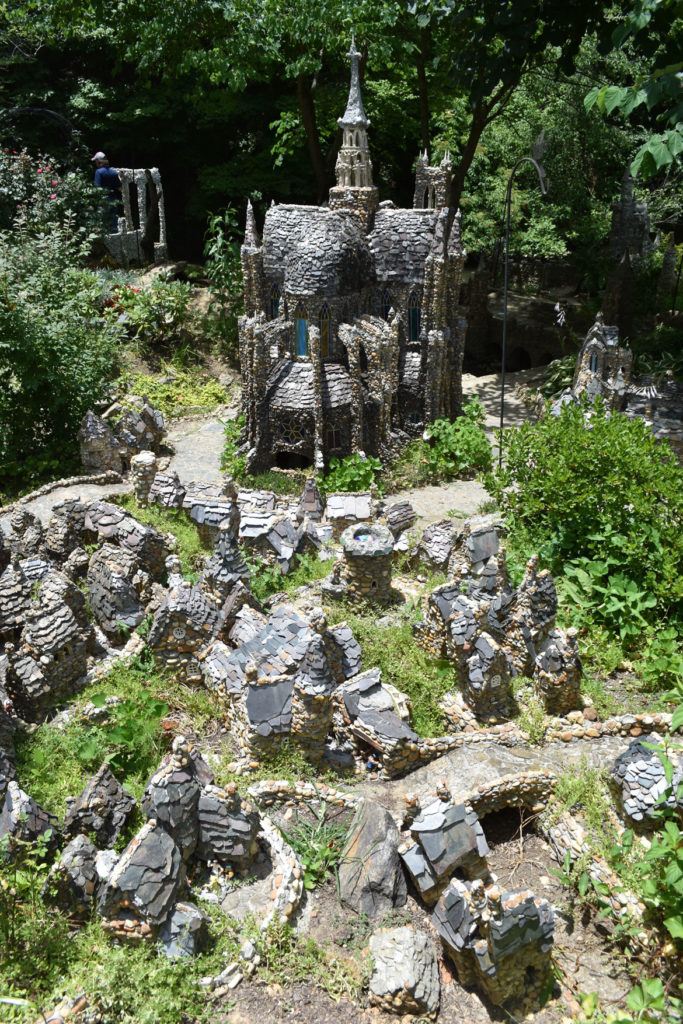
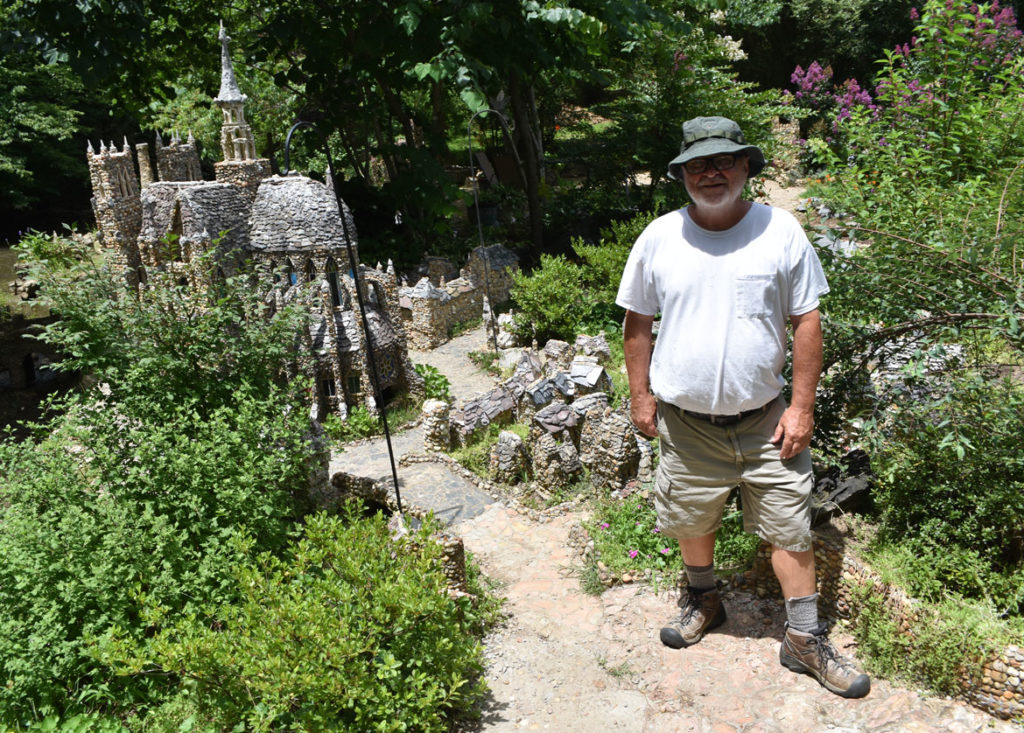
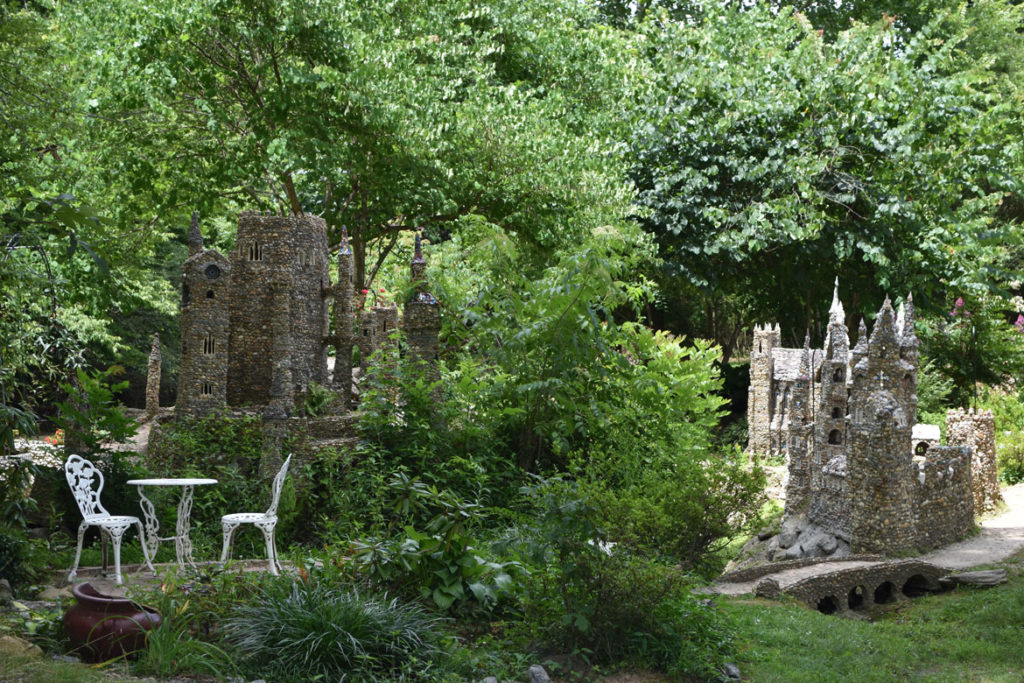
It was a sweltering hot afternoon when we arrived at the Rock Garden behind Calhoun Seventh Day Adventist Church in Calhoun, Georgia. Since September 2007, a retired gentleman who goes by the name Old Dog has constructed a miniature fairytale village of castles and cathedrals and cottages out of concrete and stones and shells along a creek behind the church. “It is a place to meet with God. The Rock Garden is a place of joy, wonder and discovery. It is a place to be with those you love,” he has said. The buildings are certainly less than life-sized, but some rise more than 6 feet tall. We were fortunate to bump into Old Dog there and he kindly invited our kids to help him cobble together a little bridge of wire, concrete and smooth river stones.
Stone Mountain, Georgia
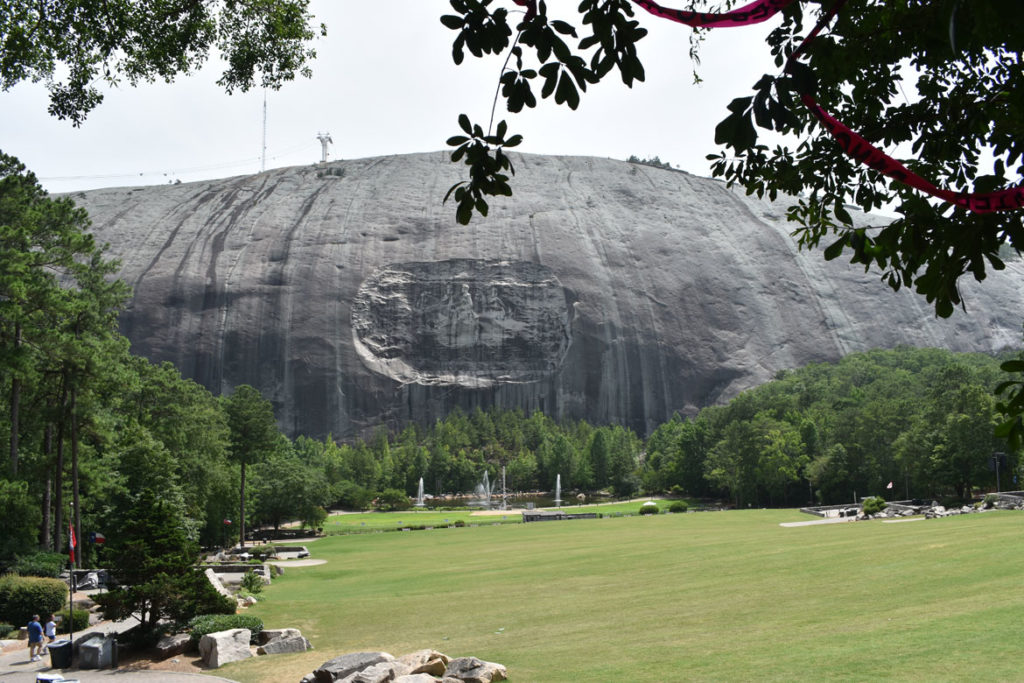
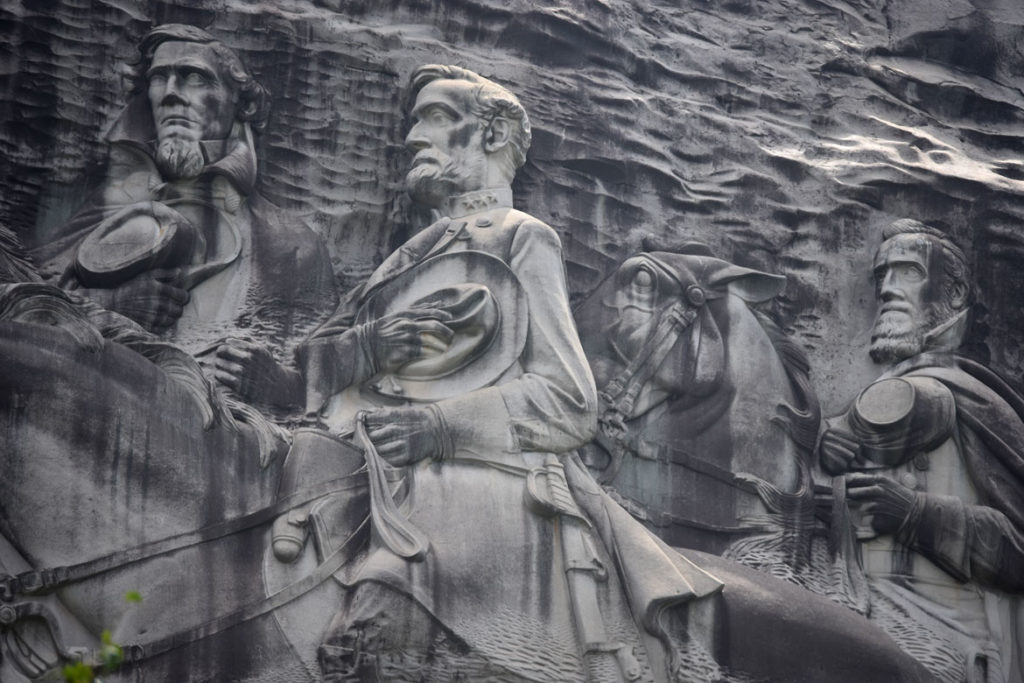
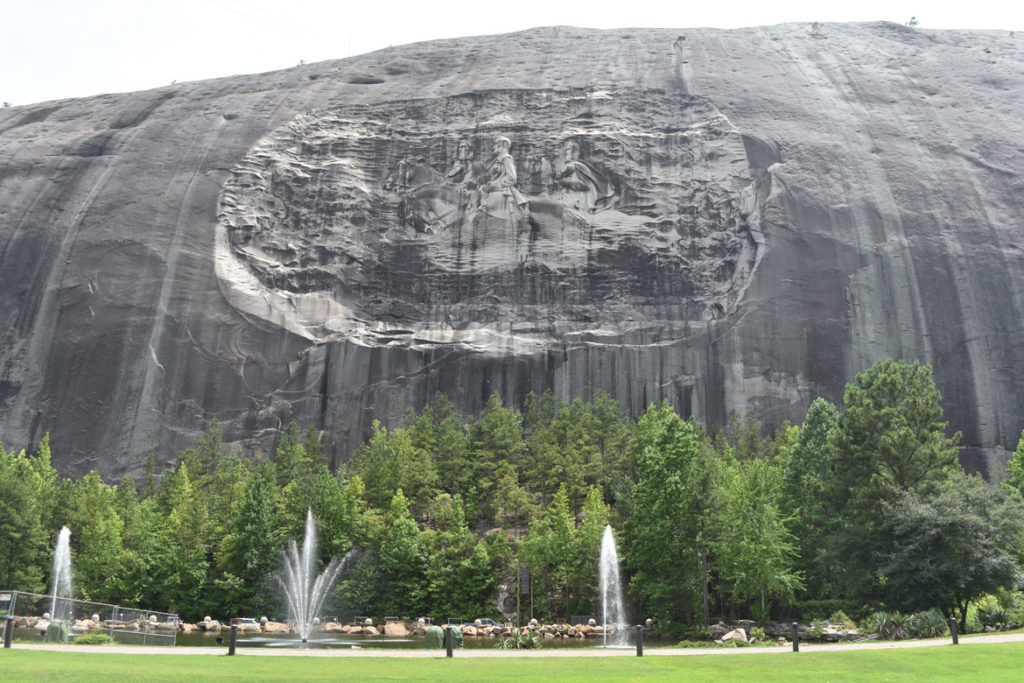
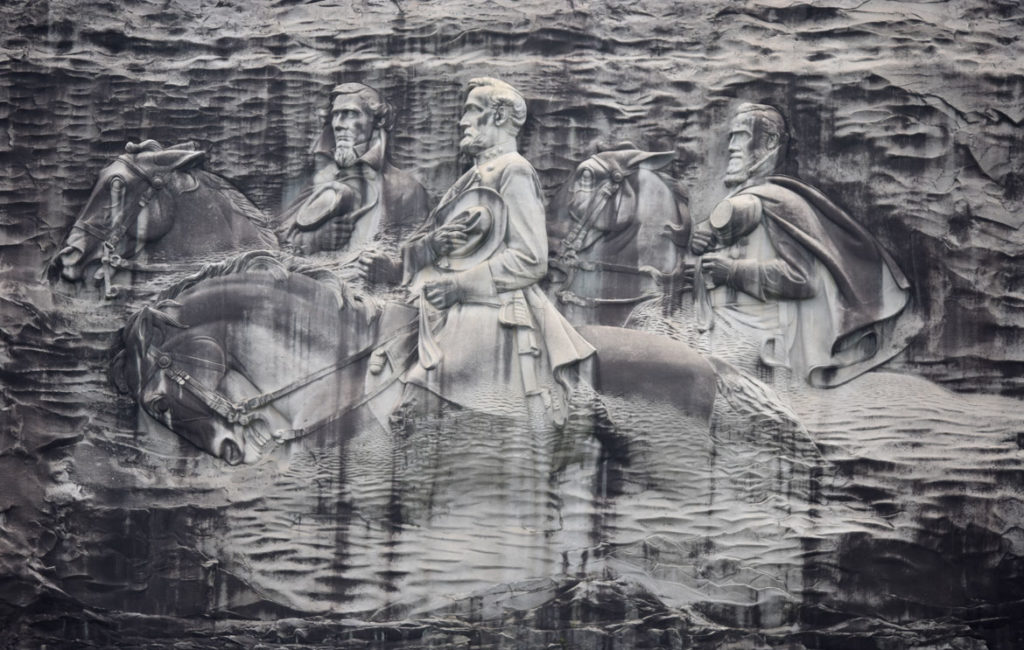
The Confederate Memorial Carving at Stone Mountain—dubbed the Confederate Mount Rushmore—stands 15 miles east of Atlanta on “3,200 acres of natural beauty” with golfing, camping and amusements that make it “Georgia’s most visited attraction.” We saw black folks jogging and biking there and whites, South Asians and Latinos taking photos of the monument.
The carving is a gargantuan depiction of three white men who turned traitor to the United States to defend the enslavement of people and white supremacy: President Jefferson Davis and Generals Robert E. Lee and Thomas J. “Stonewall” Jackson. Their depiction spans 90 by 190 feet, “larger than a football field and Mount Rushmore.” Lee is as tall as a nine-story building. It radiates evil.
Work on the sculpture began in 1915 by artist Gutzon Borglum from Connecticut. On Nov. 25 of that year, a group of men burned a cross at the top the granite peak, to signal the rebirth of the Ku Klux Klan. The Klan would hold annual rallies atop the mountain or nearby beginning in 1931. But Borglum would quit the project after a dispute with organizers and go on to carve Mount Rushmore in South Dakota. Financial woes and ownership issues also caused delays. The Confederate tribute wouldn’t be finished until 1972. But the park had officially debuted to the public with a grand opening on April 14, 1965—the hundredth anniversary of the assassination of President Abraham Lincoln.
Martin Luther King Jr.’s Atlanta
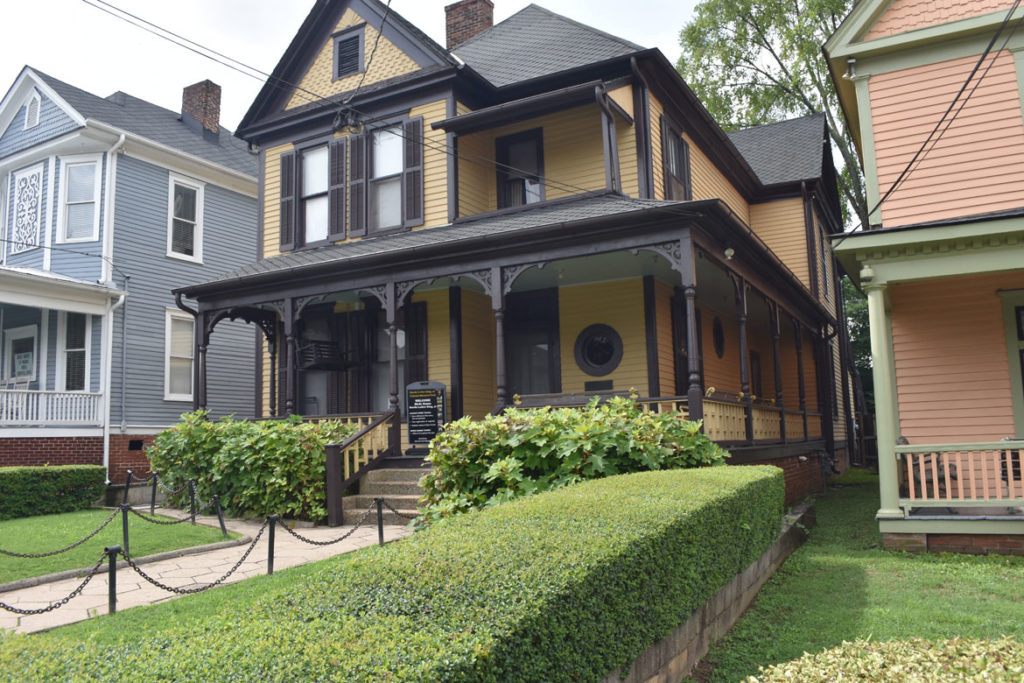
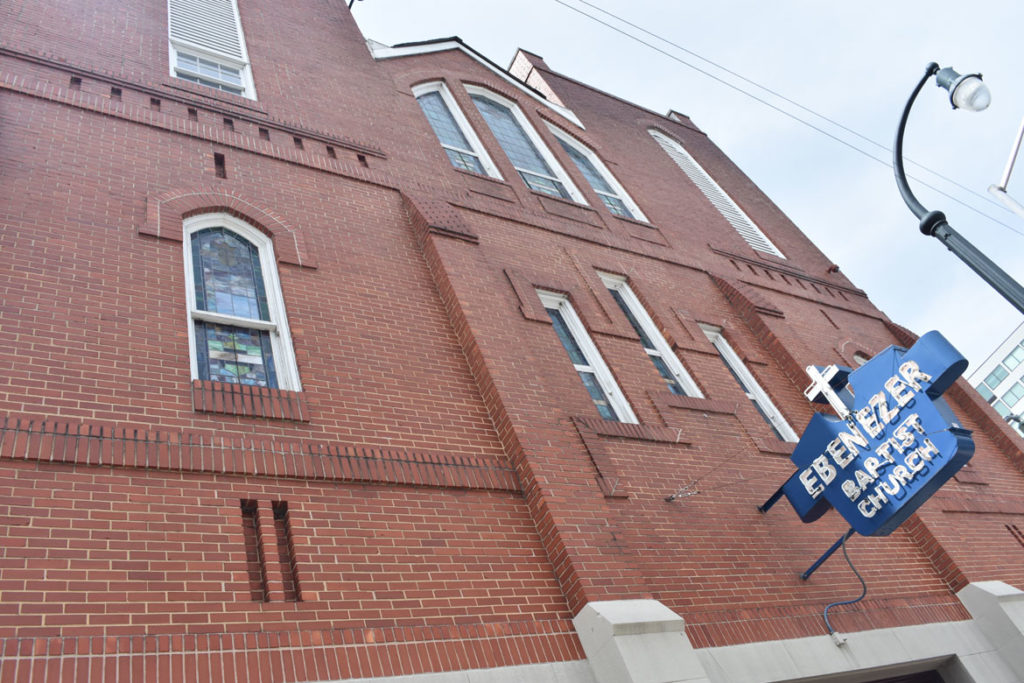
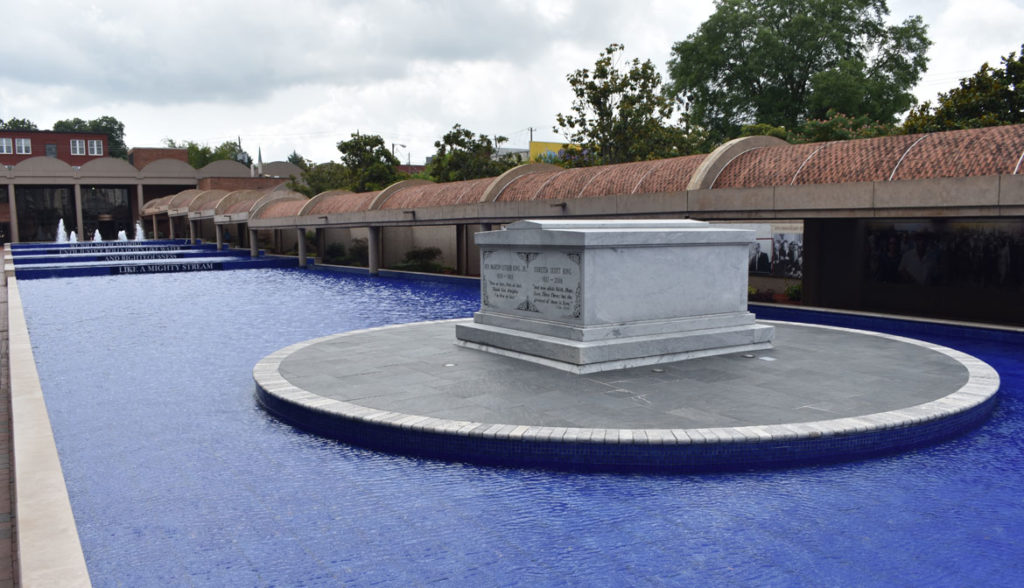
Our visit to the Martin Luther King Jr. National Historical Park in Atlanta, Georgia, was a haunting and ultimately inspiring occasion.
We took a guided tour of the two-story frame Queen Anne style house at 501 Auburn Ave. in Atlanta where Martin Luther King Jr., the great American civil rights activist, was born upstairs in 1929 and lived until he was 12. Here his father and grandfather, both ministers, steered their communities and planned civil rights actions, including a voter drive. After Dr. King was assassinated on April 4, 1968, the house was restored as an historic museum.
Down the street, we visited Ebenezer Baptist Church, the nearby church led by the King family in Atlanta, where Martin Luther King Jr. was ordained a minister after giving a trial sermon at age 19. He became co-paster there with his father, Rev. Martin Luther King Sr., know as “Daddy” King, in 1960. He held that position until his murder, when his funeral was held in the church. A restoration begun in 2001 has restored the church to its 1960s appearance.
Prince Hall Masonic Building at 332-334 Auburn Ave., Atlanta, served as the headquarters of the Southern Christian Leadership Conference, where Martin Luther King Jr. developed civil rights campaigns with Ralph Abernathy, Andrew Young and other activists.
King’s tomb is an island amidst the reflecting pool at the Martin Luther King Jr. Center for Nonviolent Social Change, which was founded by his widow Coretta Scott King in 1968. (Mrs. King was buried there as well after her death in 2006.) Water cascades down the reflecting pool, over steps with tile spelling out a line from King’s “I Have a Dream” speech at the 1963 March On Washington for Jobs and Freedom: “We will not be satisfied / until justice rolls down like water / and righteousness / like a mighty stream.”
Atlanta, Georgia
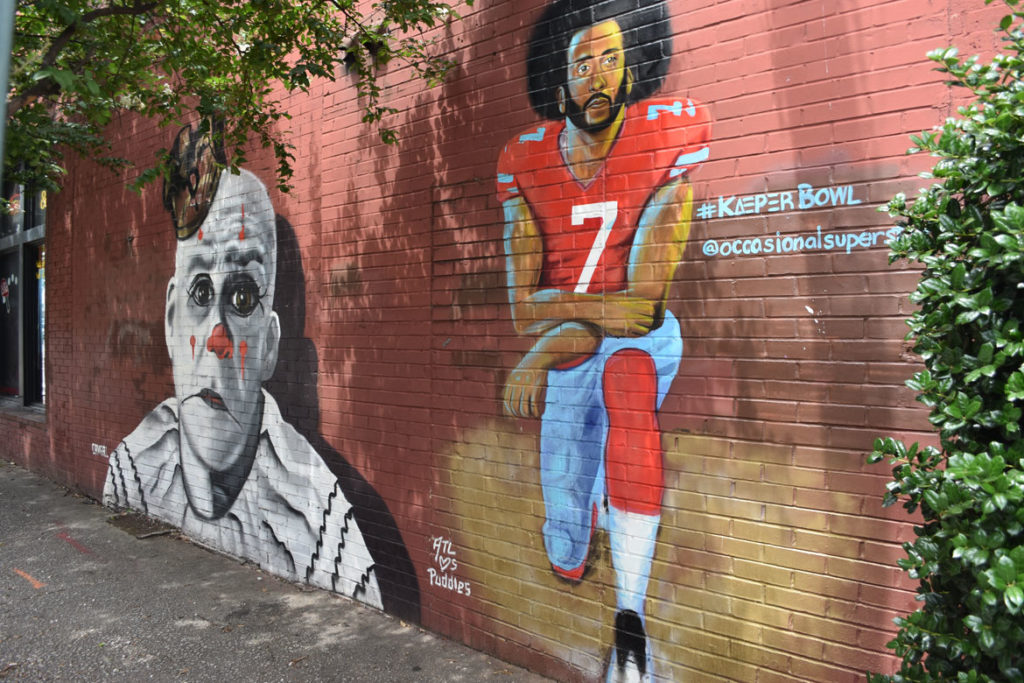
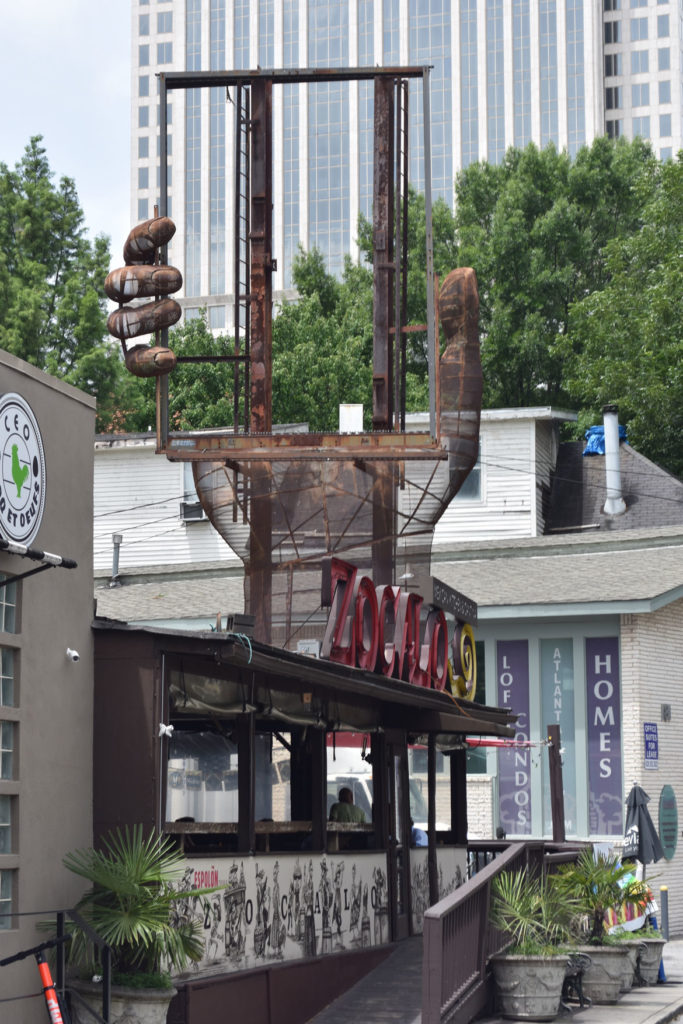
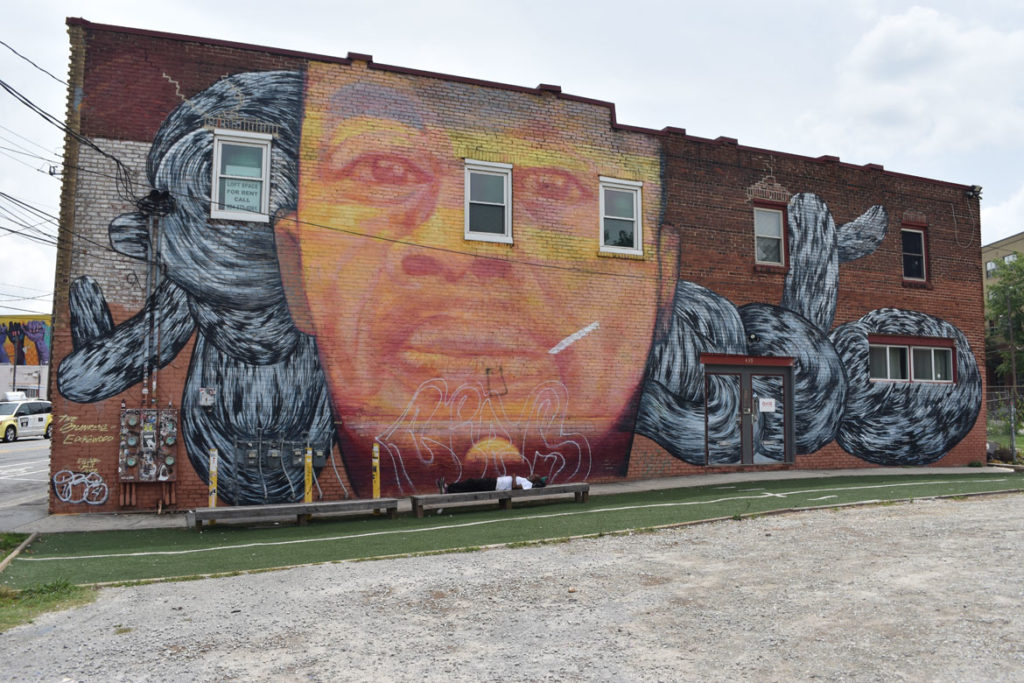
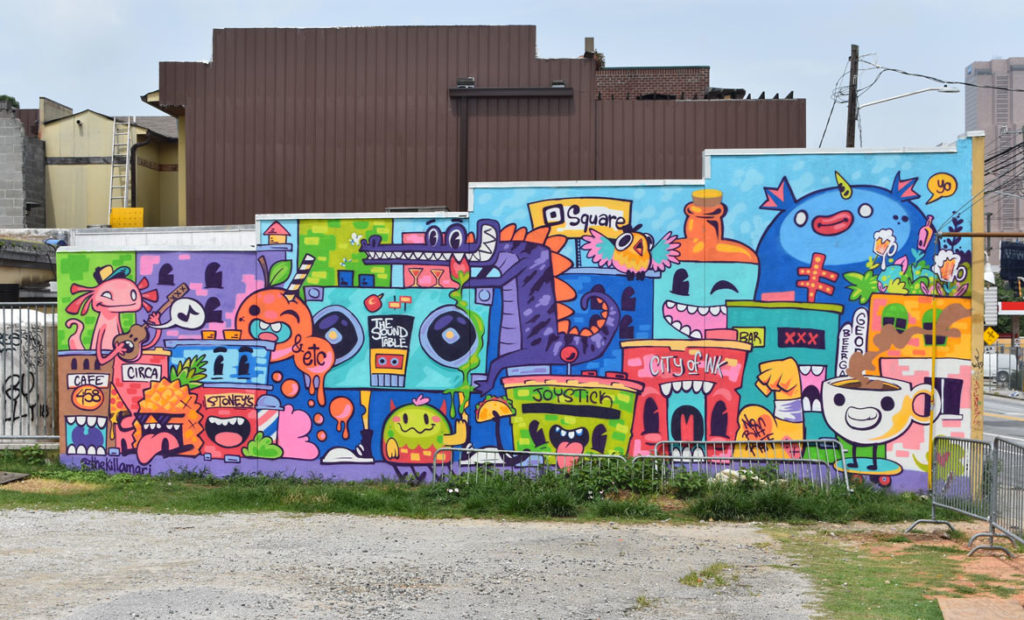
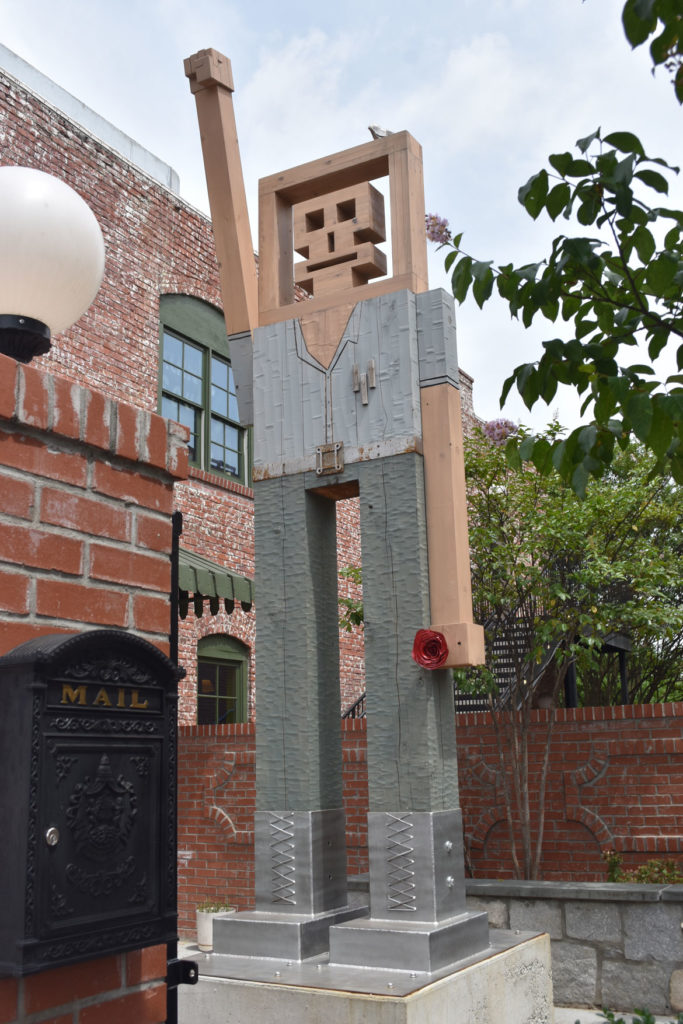
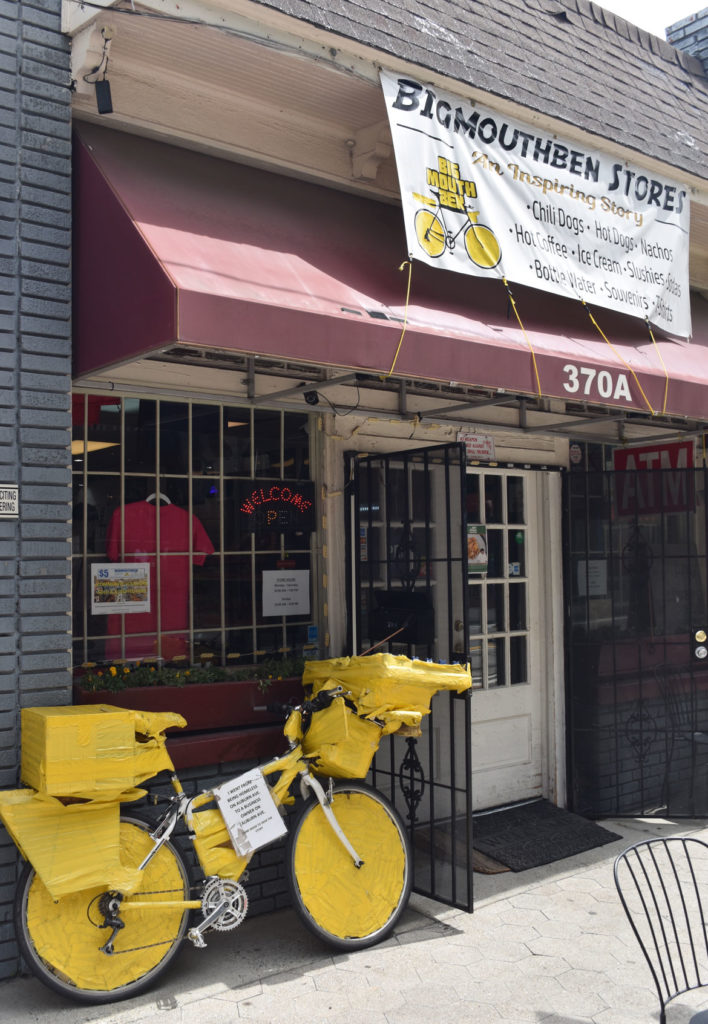
Pasaquan at Buena Vista, Georgia
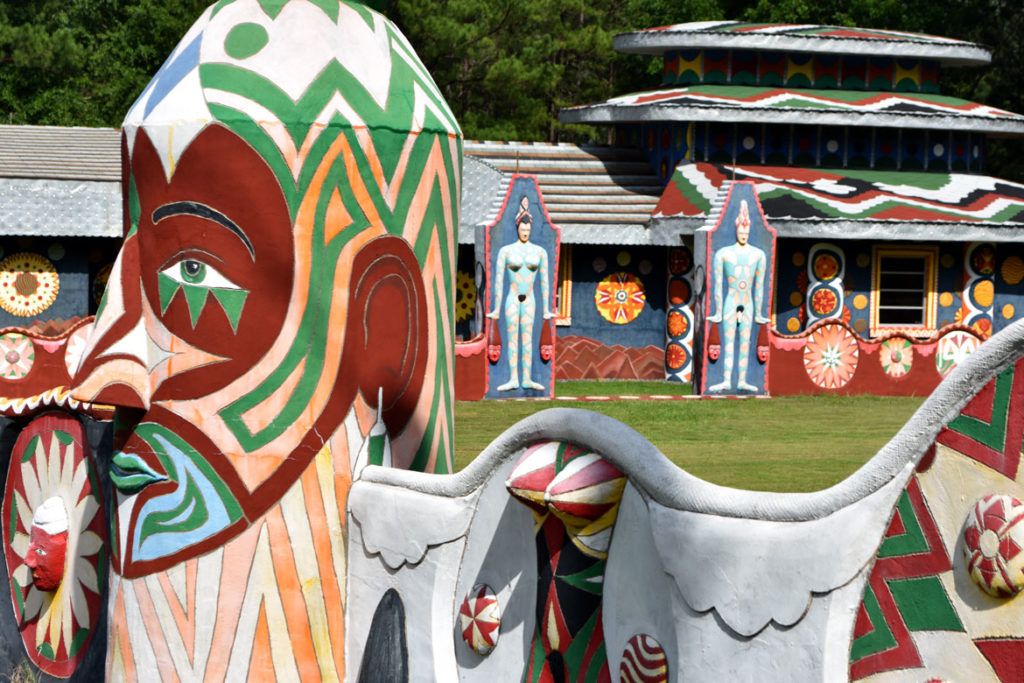
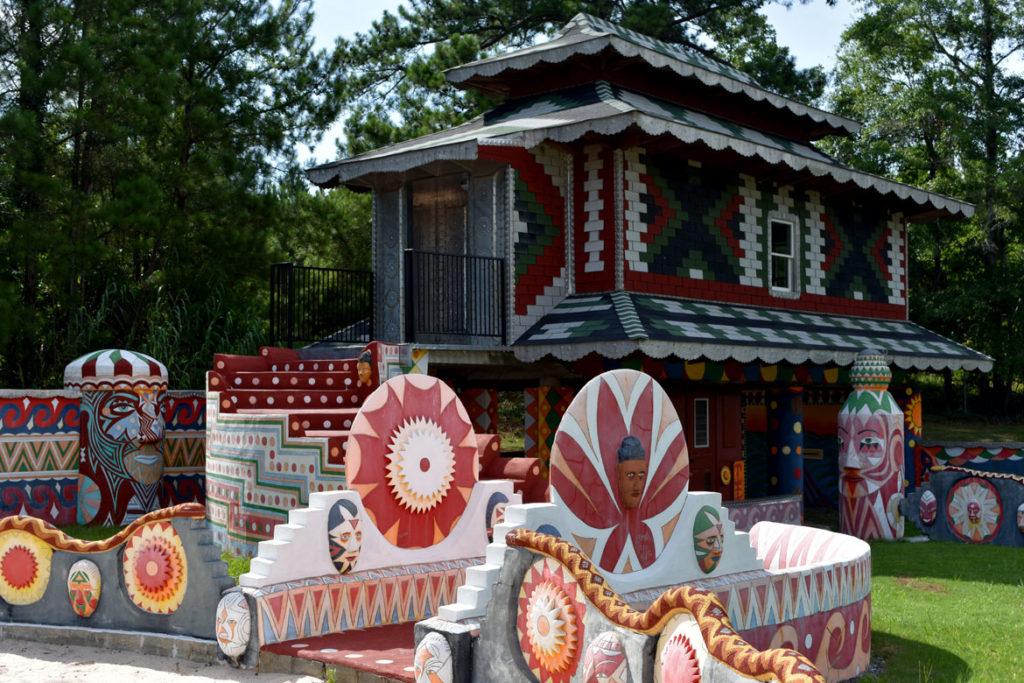
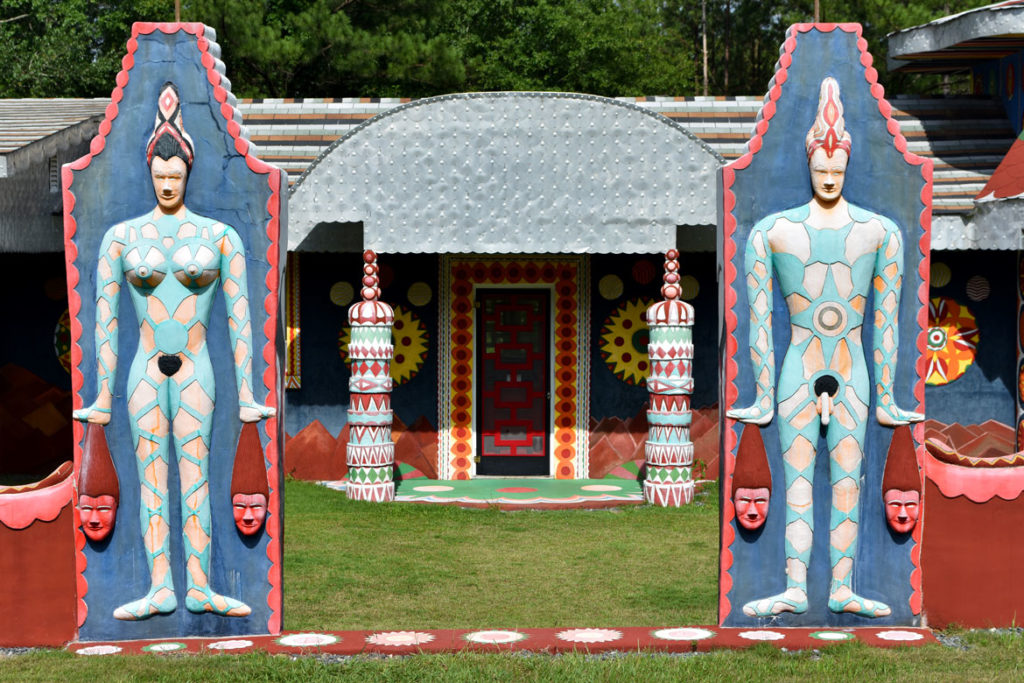
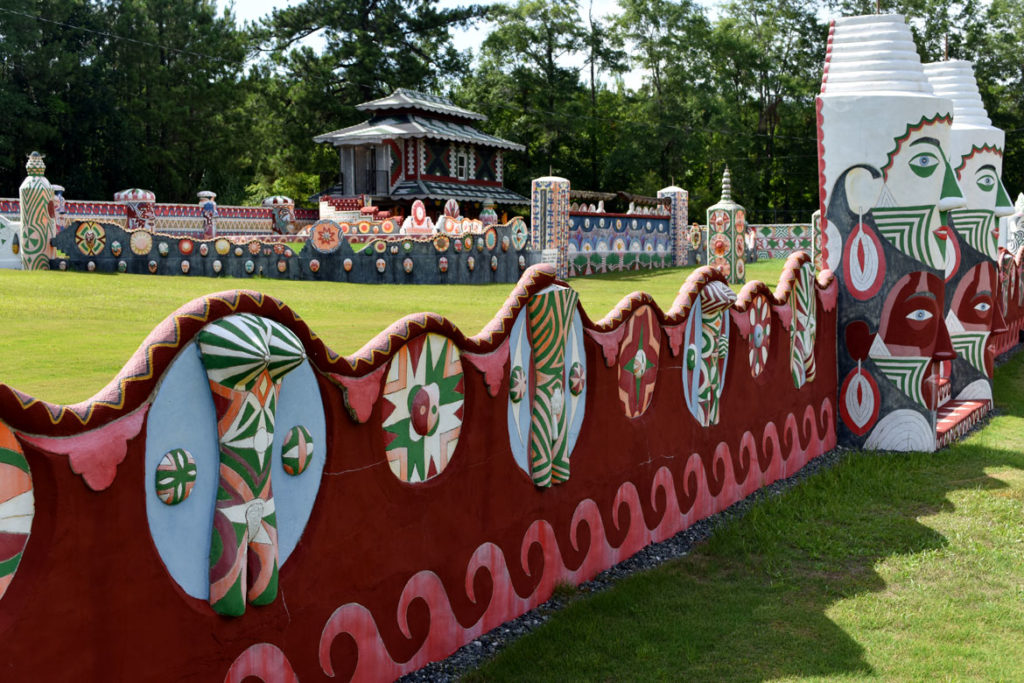
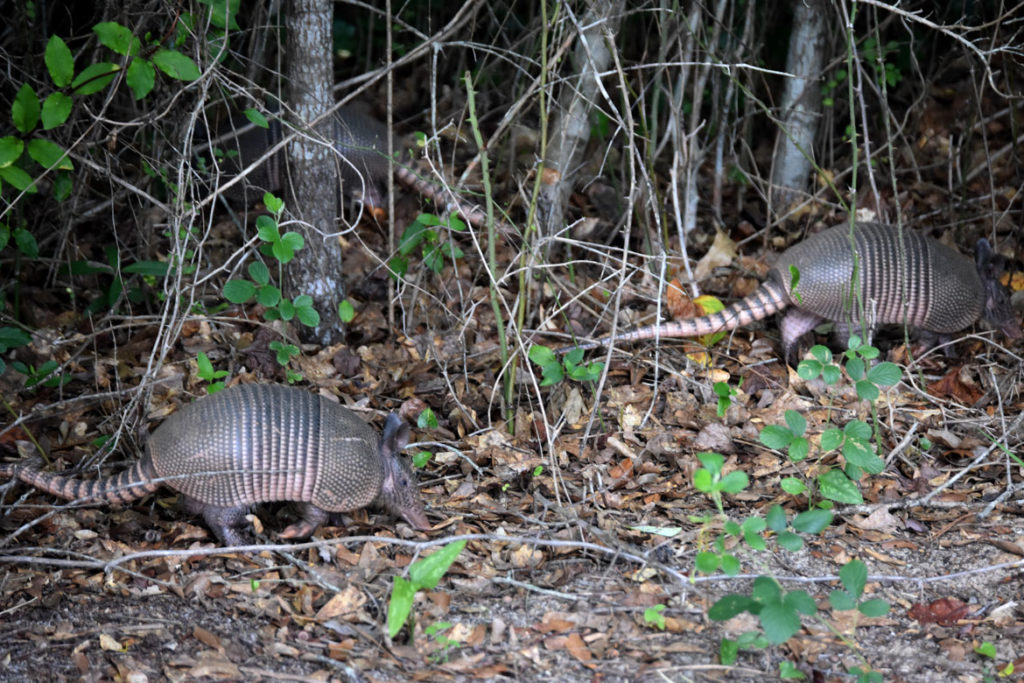
Eddie Owens Martin had been a street hustler, bartender, gambler, drag queen and fortuneteller in New York. But after his mother died, he returned to his native, Buena Vista, Georgia, in 1957 and moved into her old farmhouse. He wore robes and feathered headdresses and offered to tell people’s fortunes for money, which he used to turn his mother’s property into a 7-acre visionary estate Pasaquan.
“You’re gonna be the start of somethin’ new,” he said, “and you’ll call yourself ‘Saint EOM,’ and you’ll be a Pasaquoyan—the first one in the world.”
Over three decades, he created six major structures, mandala murals and more than 900 feet of elaborately painted masonry walls inspired by African, Hindu, pre-Columbian Mexico and Native American traditions. When his health flagged, he committed suicide in 1986. And Pasaquan began to fade. But the place is vividly hued again after a 2014 restoration by the Pasaquan Preservation Society, Kohler Foundation and Columbus State University.
Jimmy Carter’s Plains, Georgia
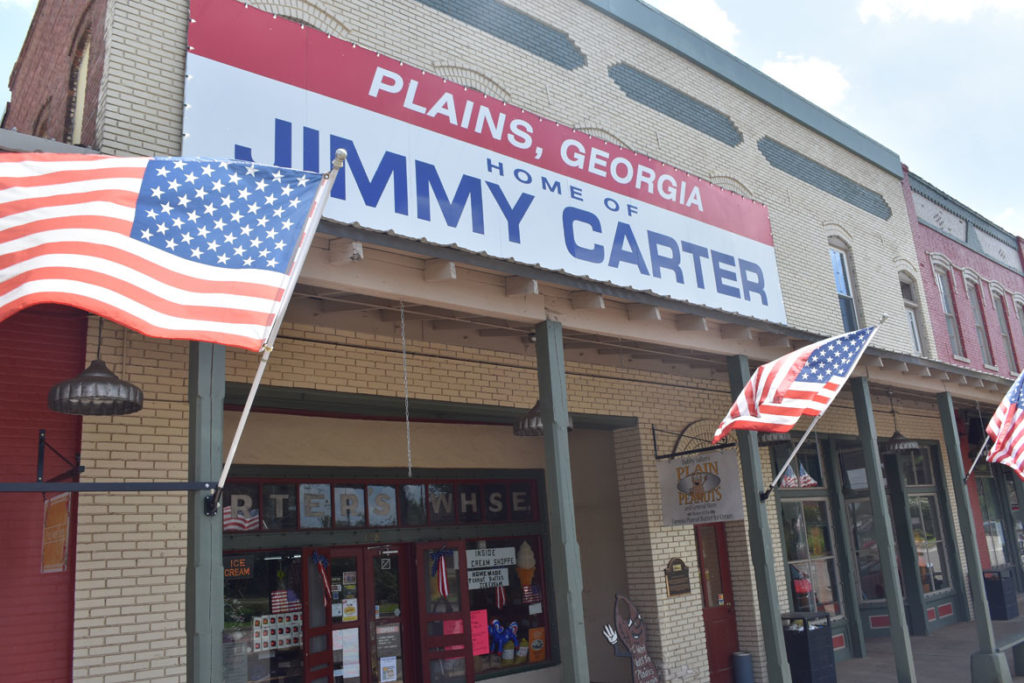
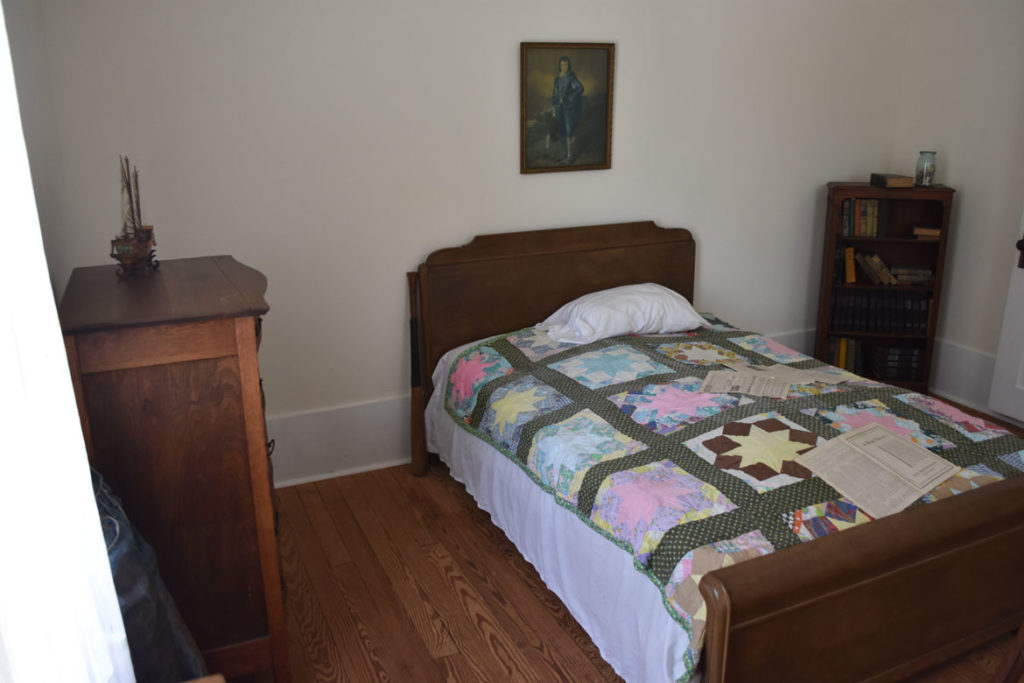
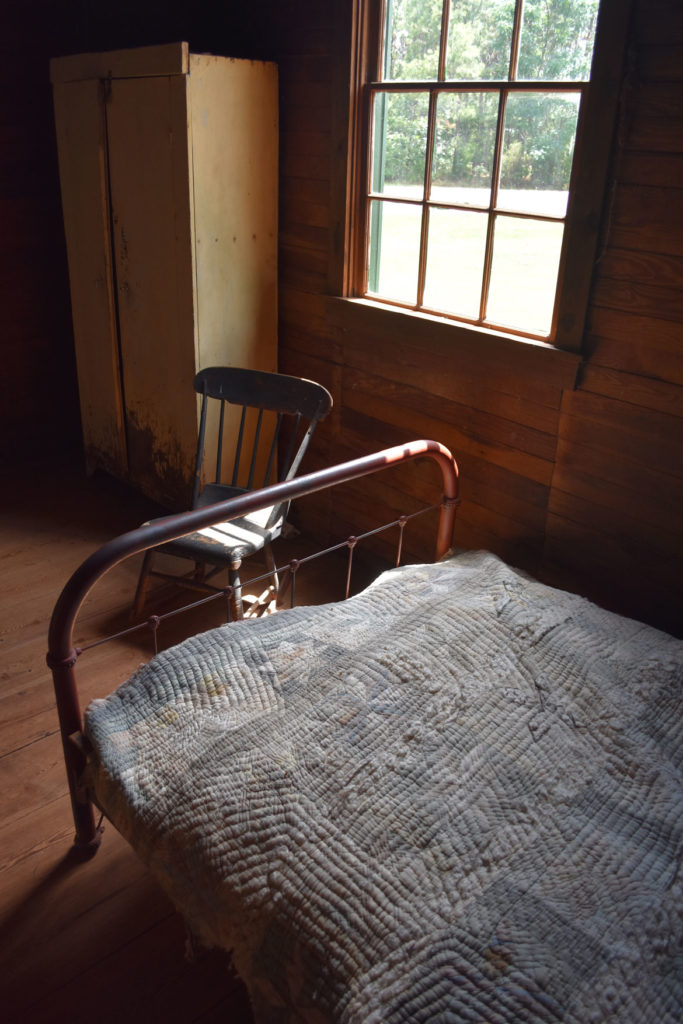
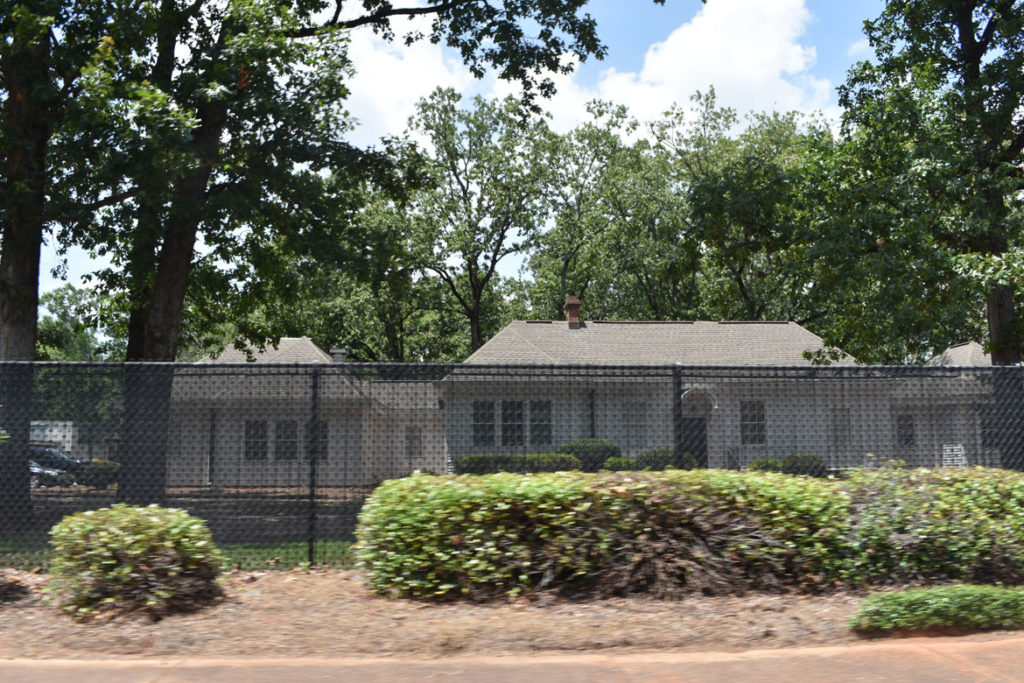
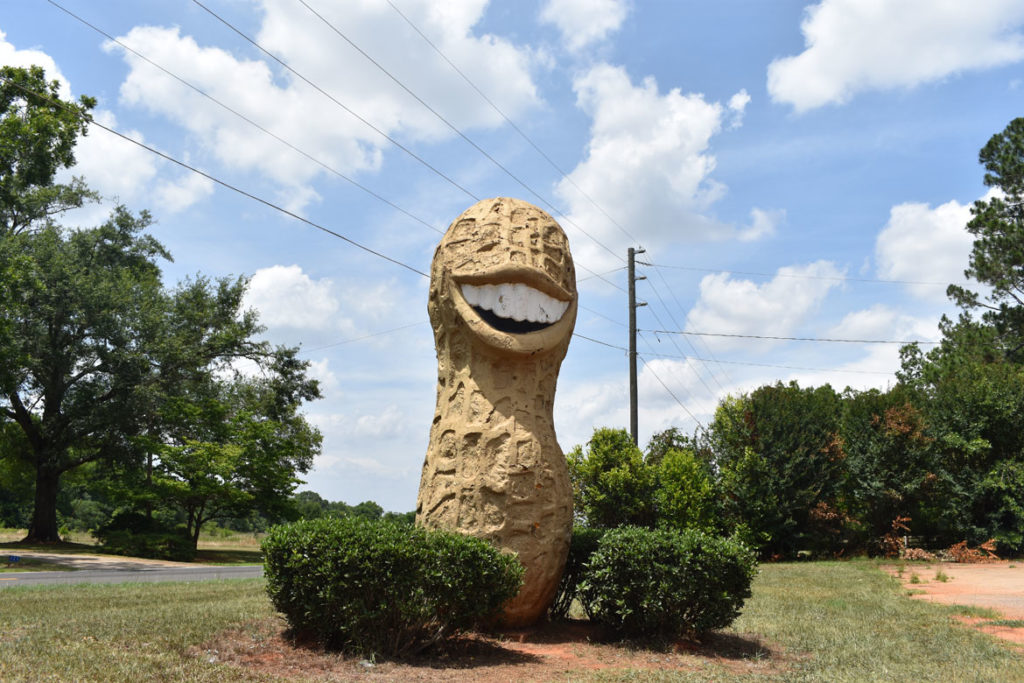
Americus, Georgia
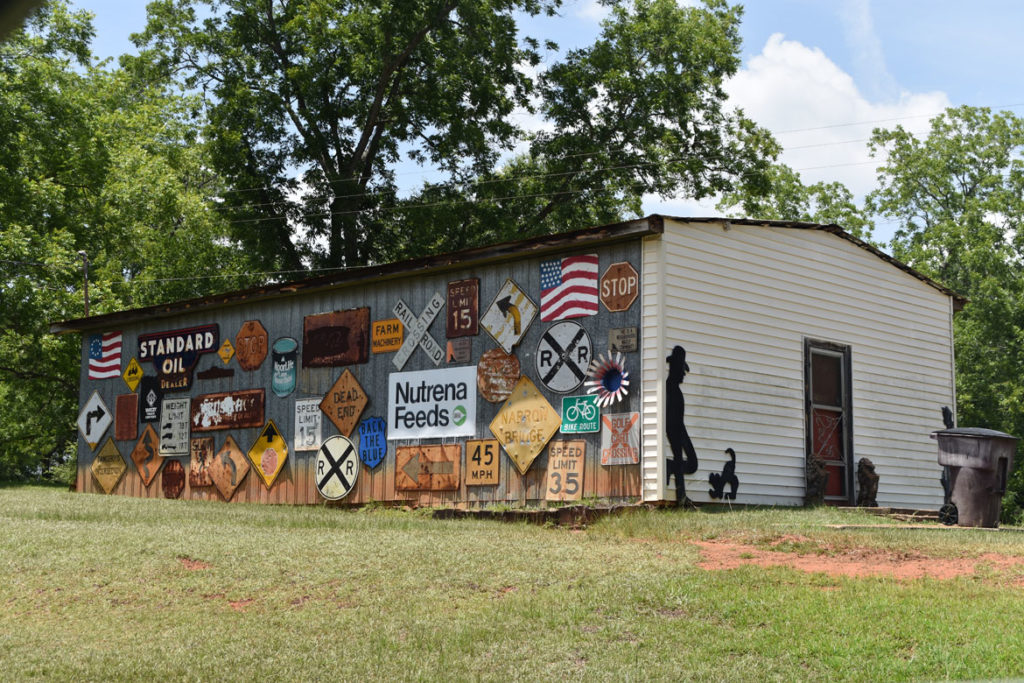
Savannah, Georgia
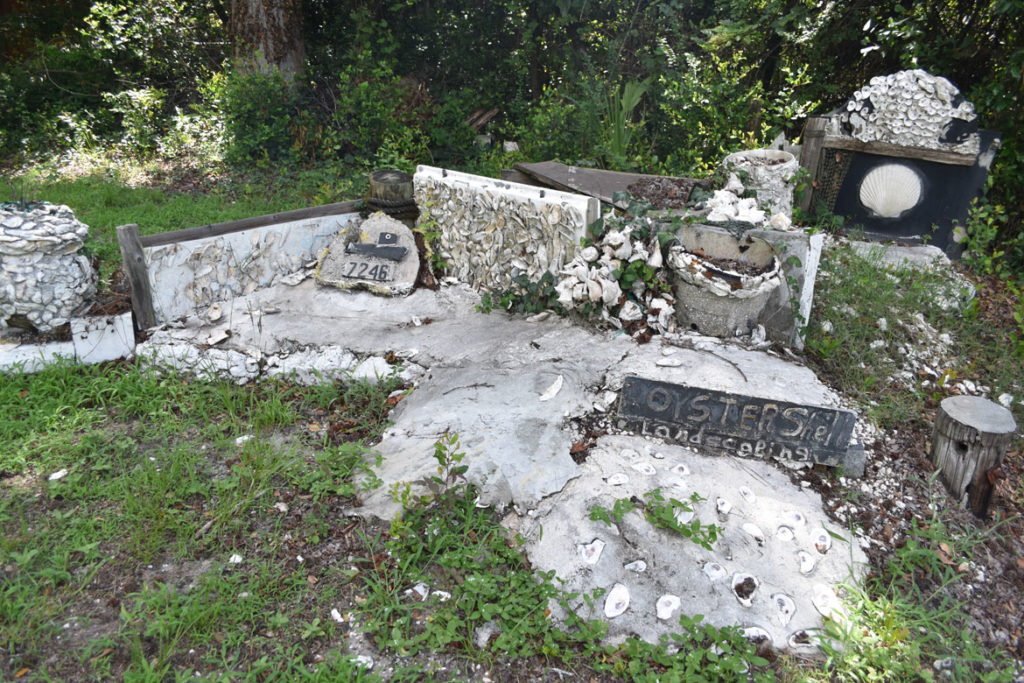
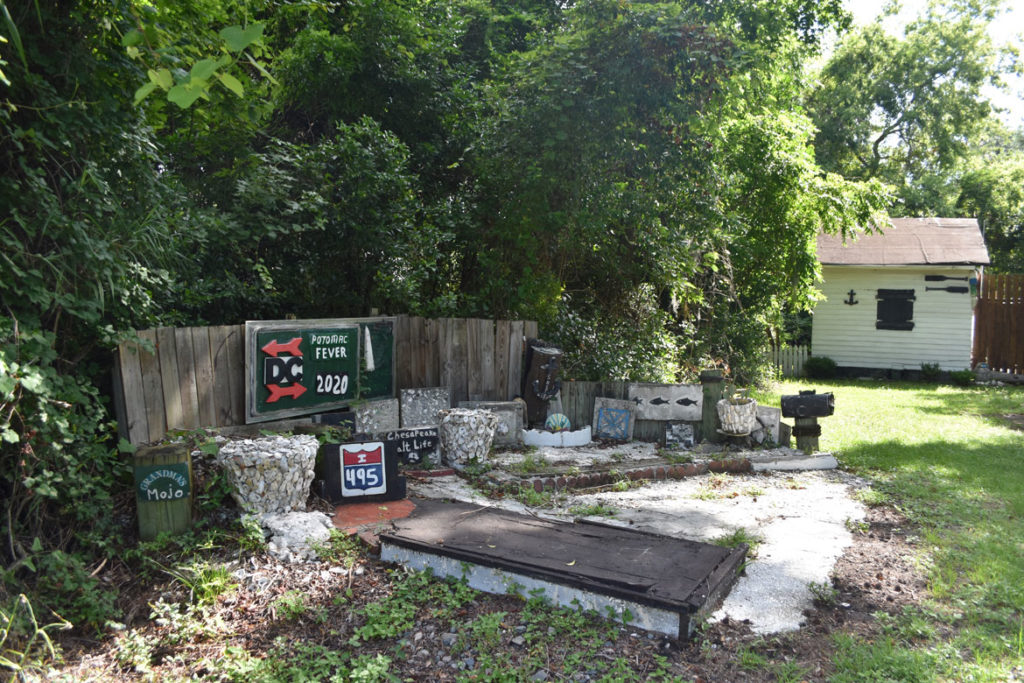
“Chesapeake Salt Life” and “Oyster Shell Landscaping” at 7246 Skidaway Road, Savannah, Georgia.
Tybee Island at Savannah, Georgia
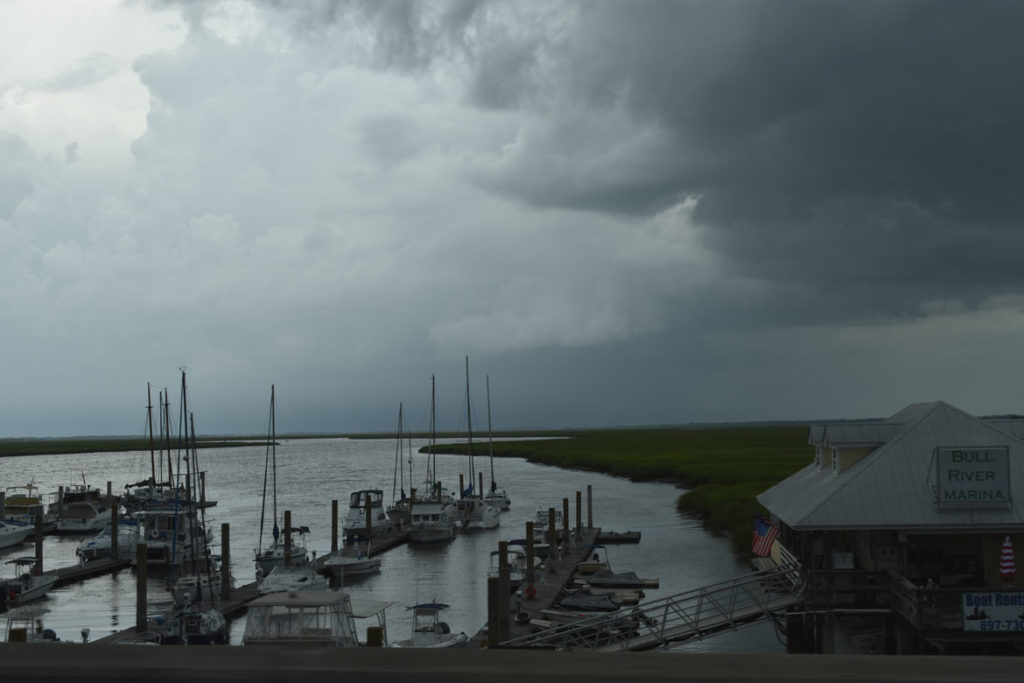
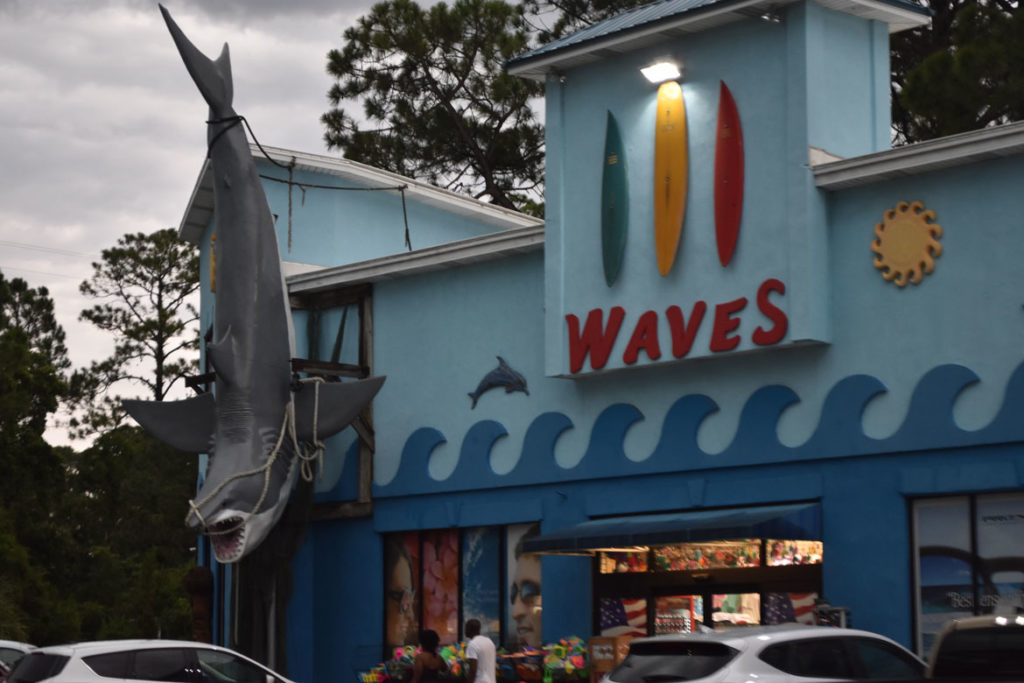
Oyotunji African Village at Seabrook, South Carolina
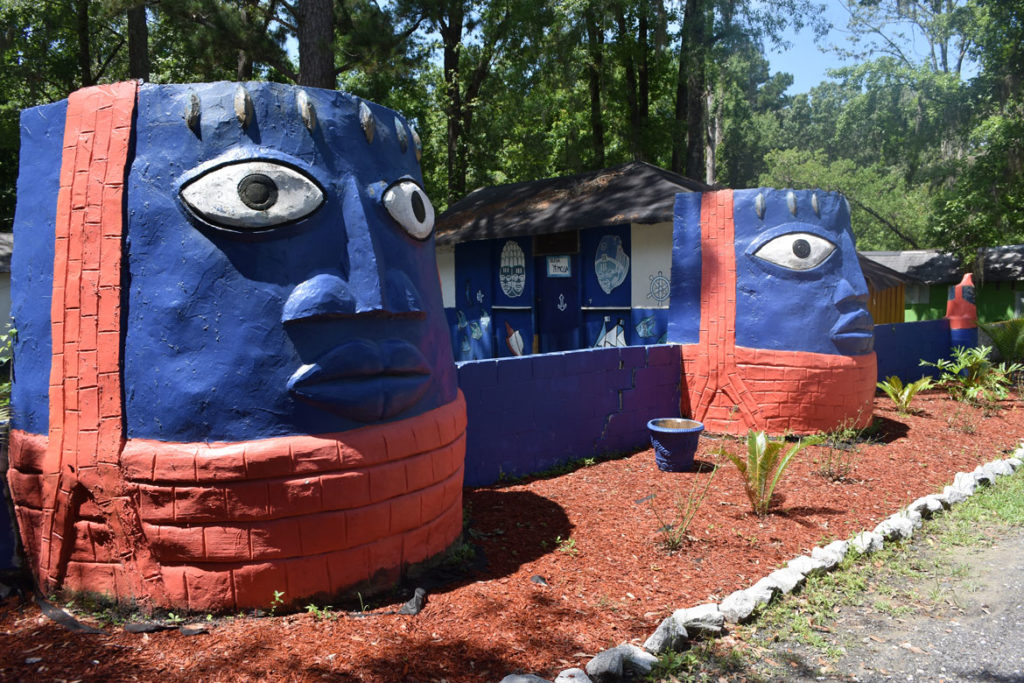
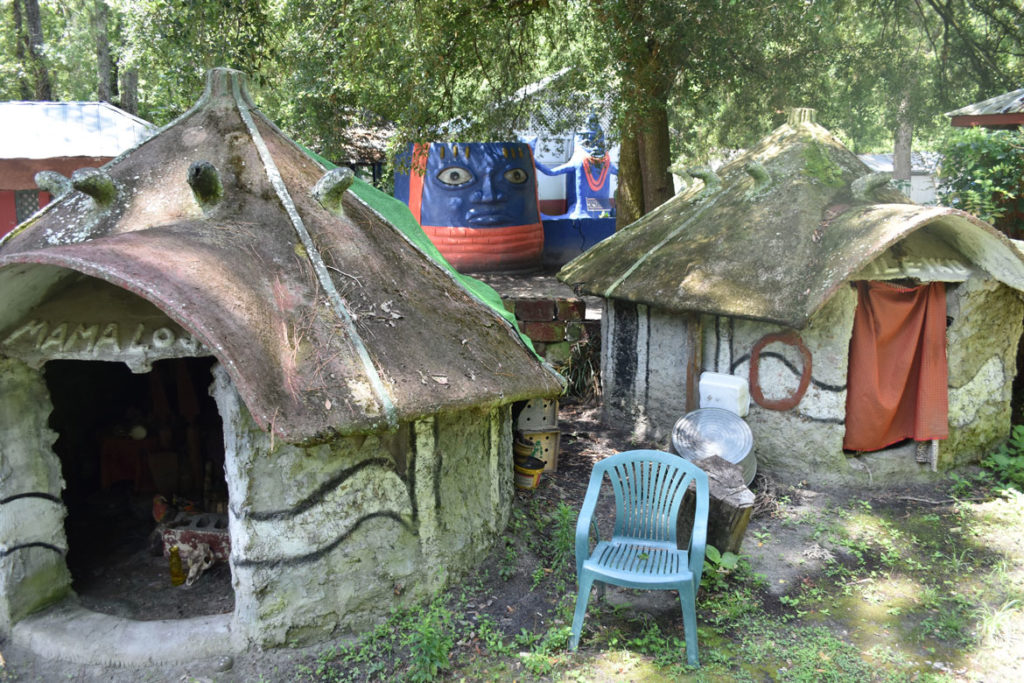
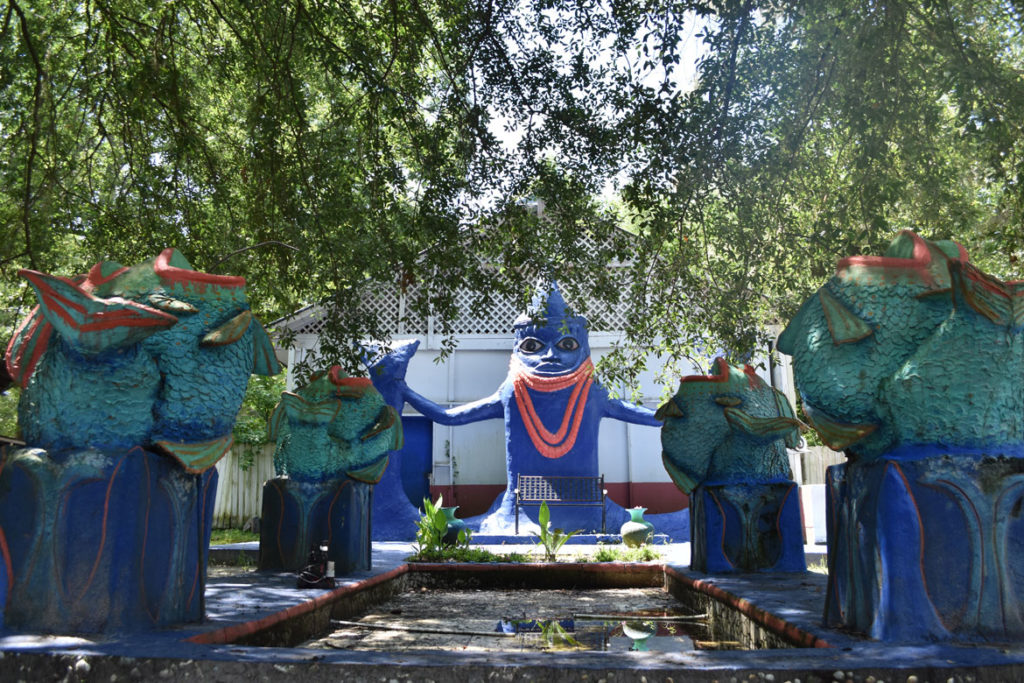
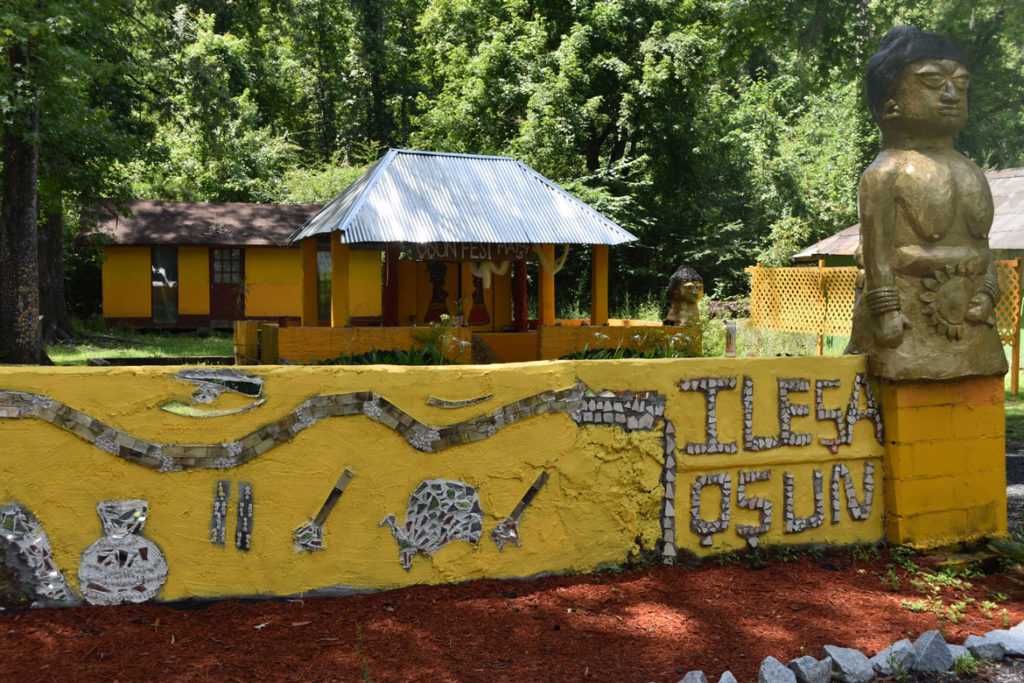
Founded in 1970, Oyotunji African Village describes itself at “the first intentional community in North America based on the culture of the Yoruba and Dahomey tribes of West Africa.”
Charleston, South Carolina
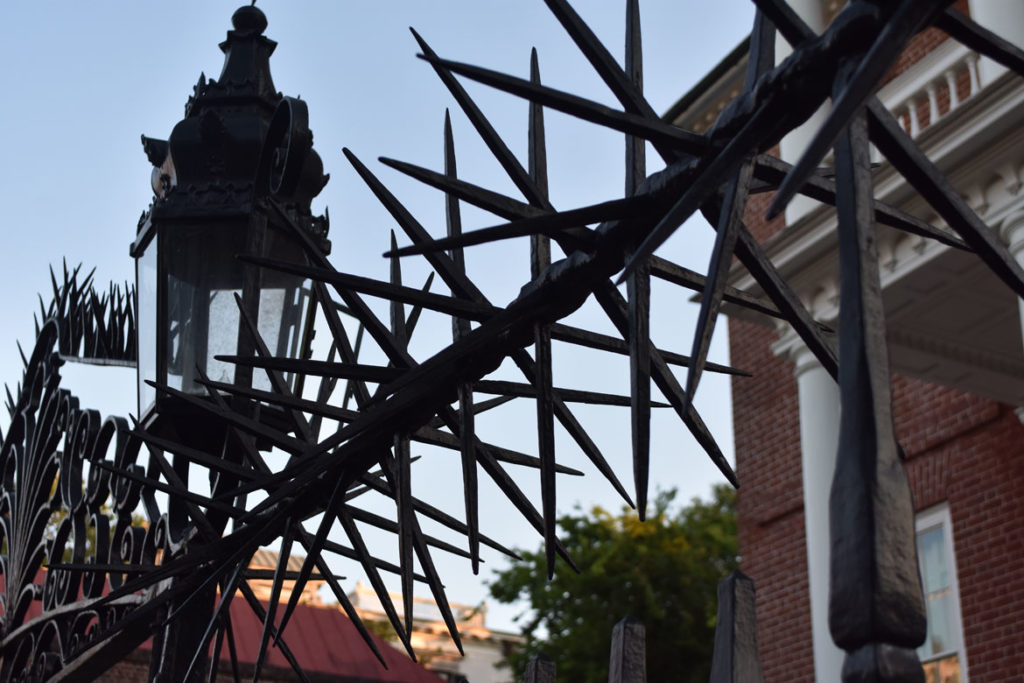
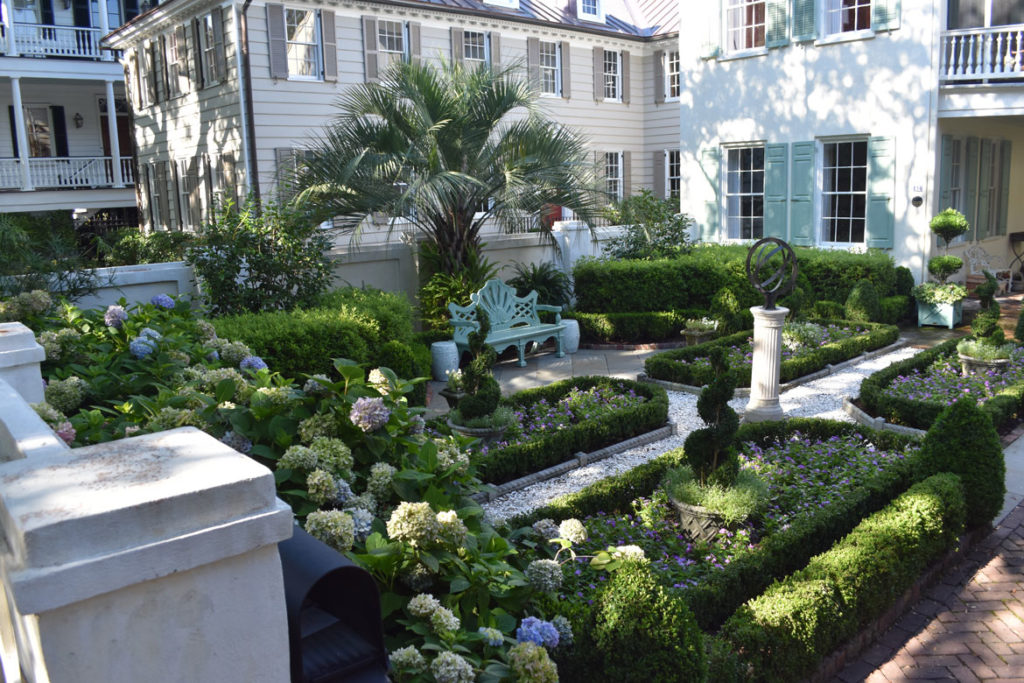
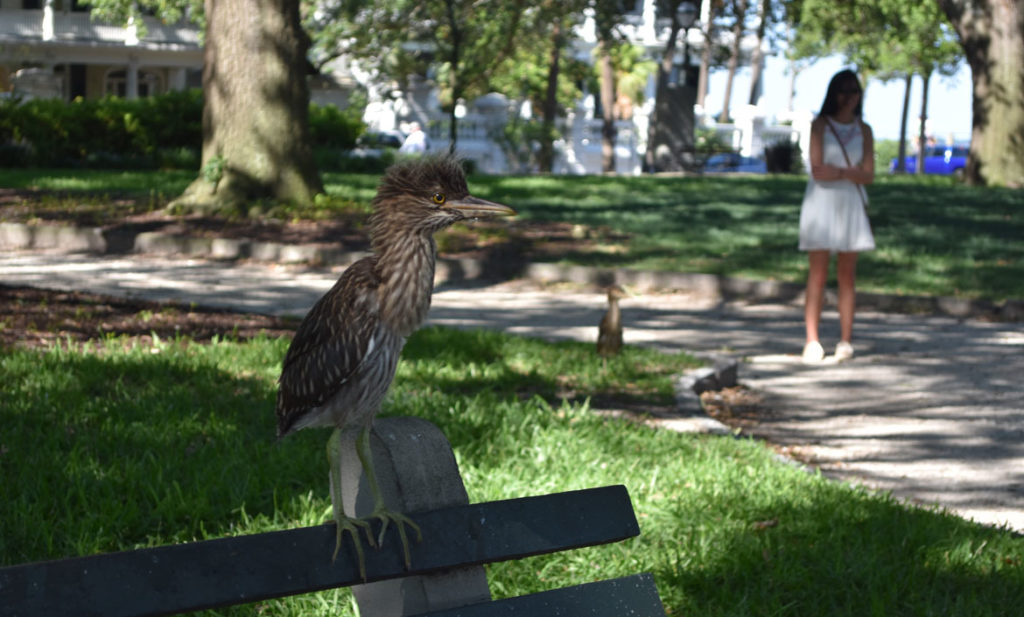
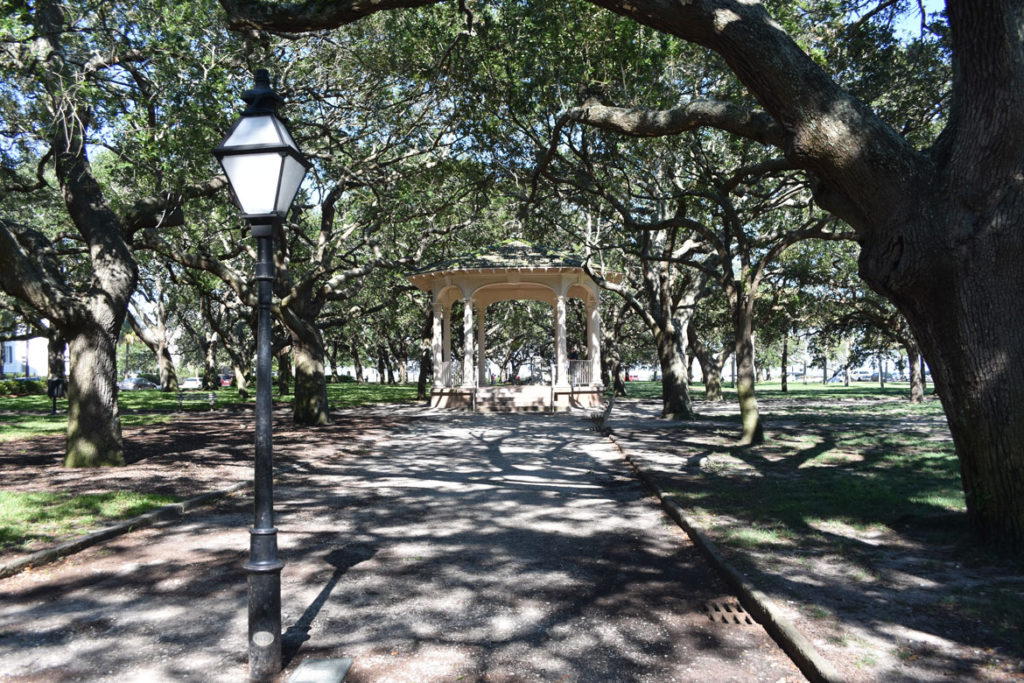
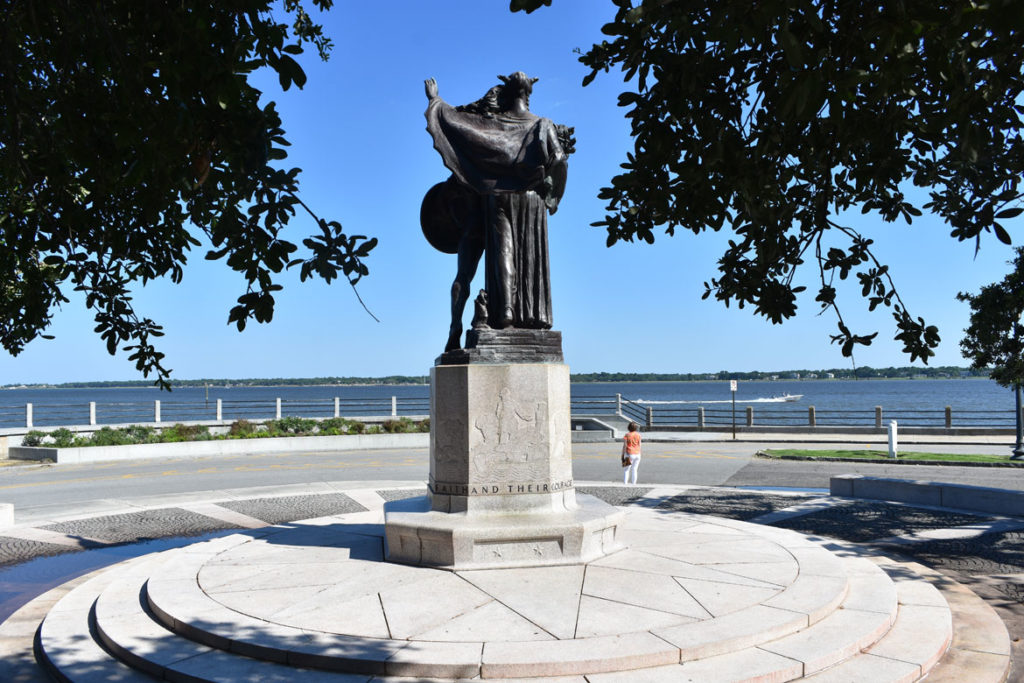
Middleton Place at Charleston, South Carolina
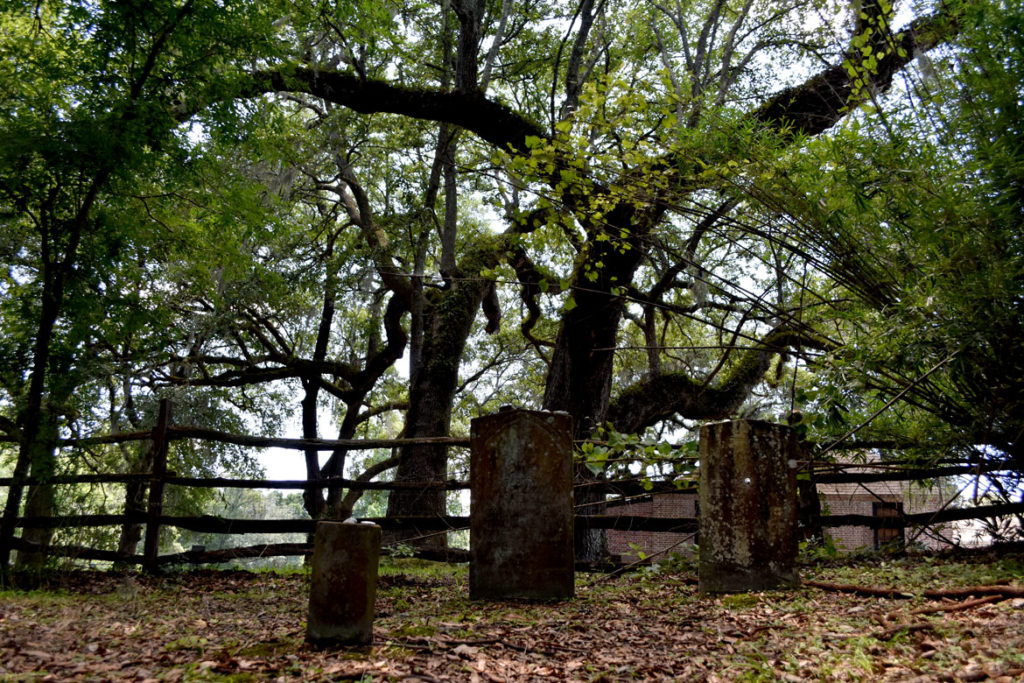
Tombstones of John Johnston (d. 1859) and Edward Brown (d. 1851), both thought to have been enslaved at Middleton Place, a Charleston, South Carolina, slave labor estate owned by a signer of the American Declaration of Independence and later his descendent, a signer of South Carolina’s documents seceding from the United States as part of the American Civil War as well as a major financial backer of the traitorous Confederacy.
Francis Marion National Forest, north of Charleston, South Carolina
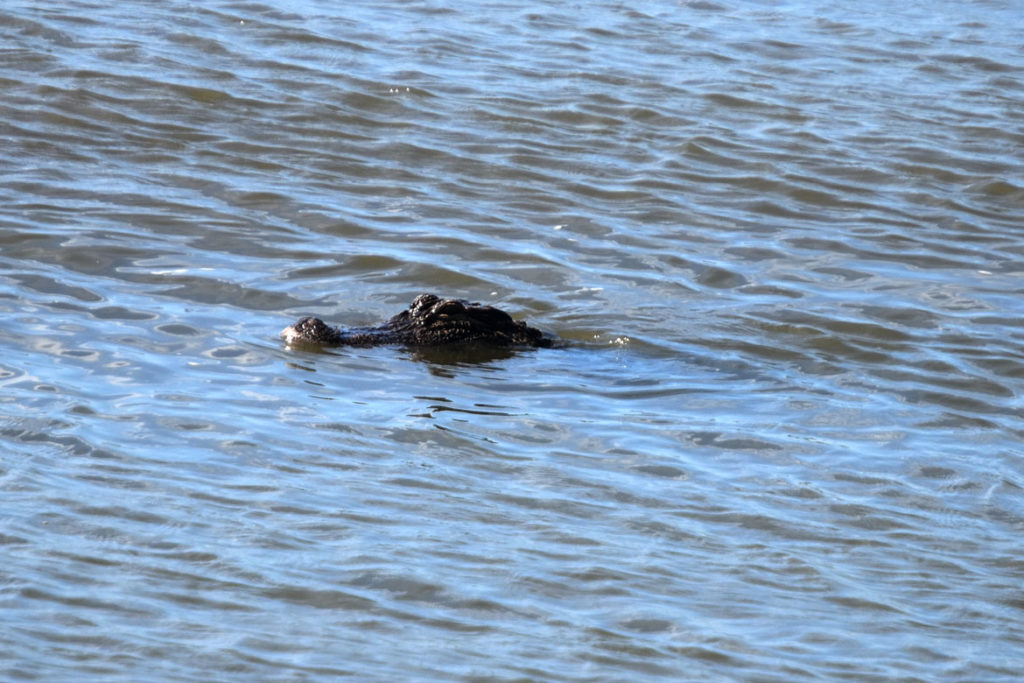
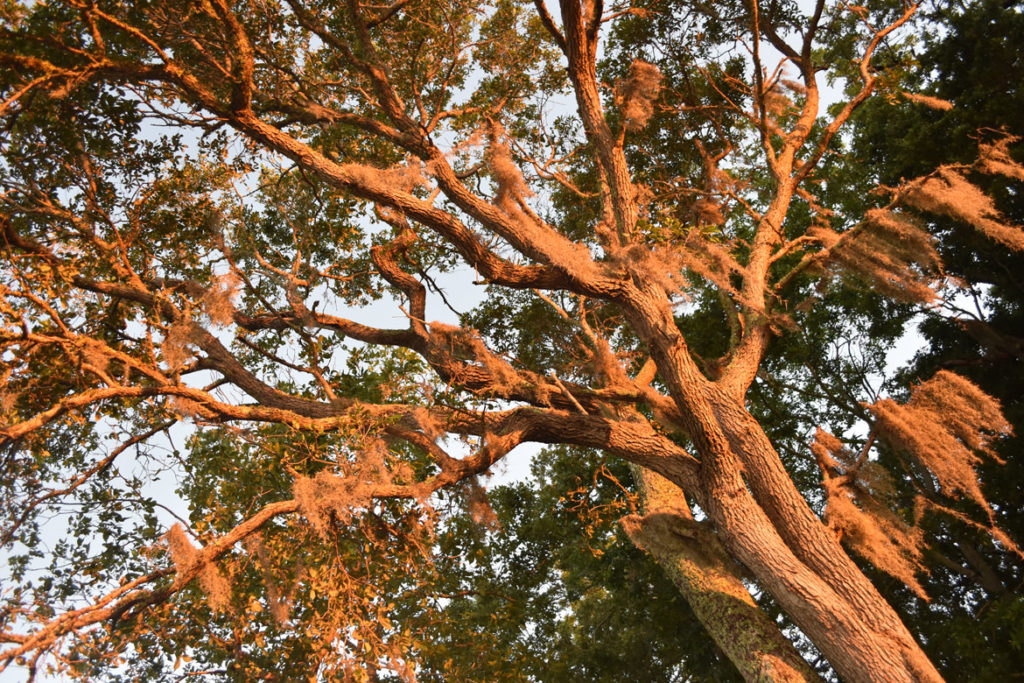
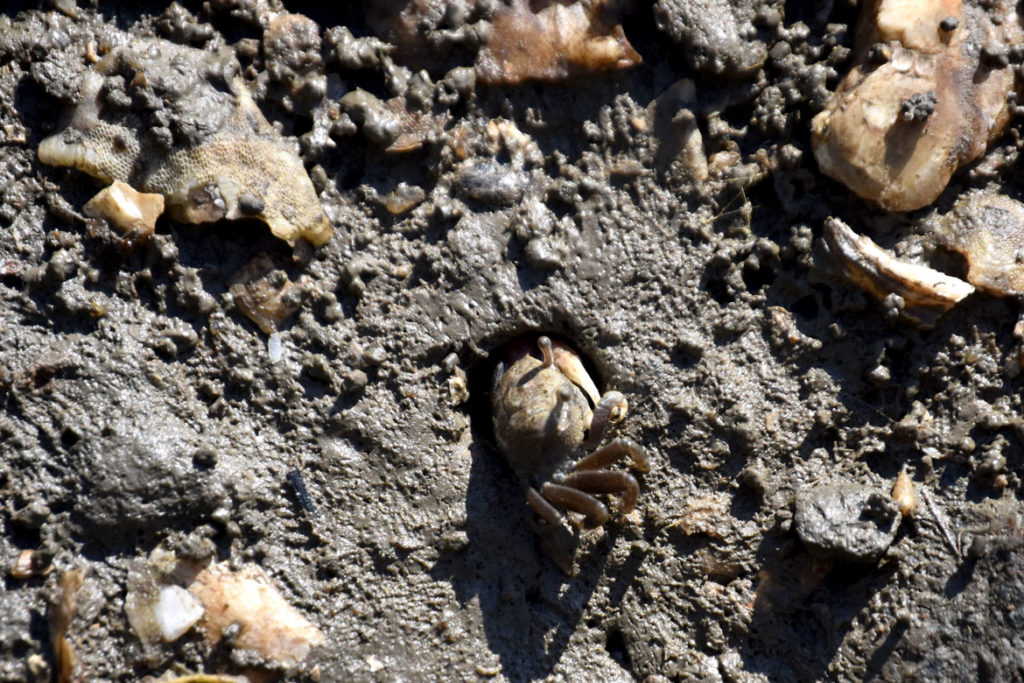

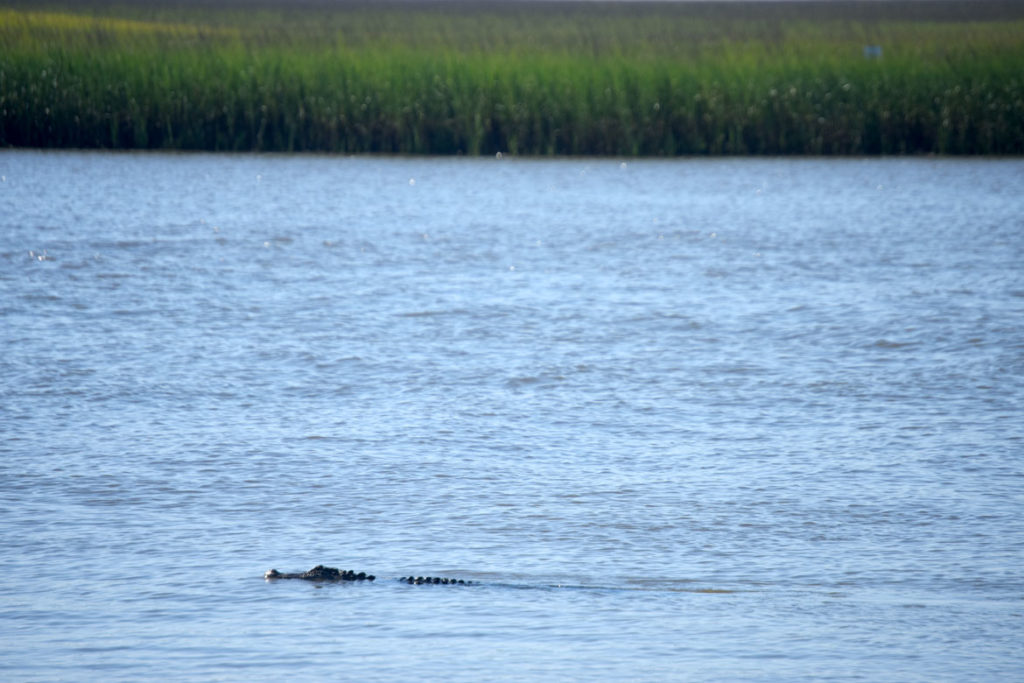
We drove through an angry thunderstorm, that threw trees across the highway, to arrive at Francis Marion National Forest’s Buck Hall Recreation Area. The rain ended just after we got out tent up to camp there, about an hour and a half drive north of Charleston, South Carolina. The next morning dawned sunny and hot and clear at our site just yards from a tidal river running through the marsh. The place teemed with wildlife–birds, frogs, fish. We spotted an alligator. And then a dolphin swamp past the alligator. (Unfortunately I didn’t get a photo of the dolphin.)
The UFO Welcome Center at Bowman, South Carolina
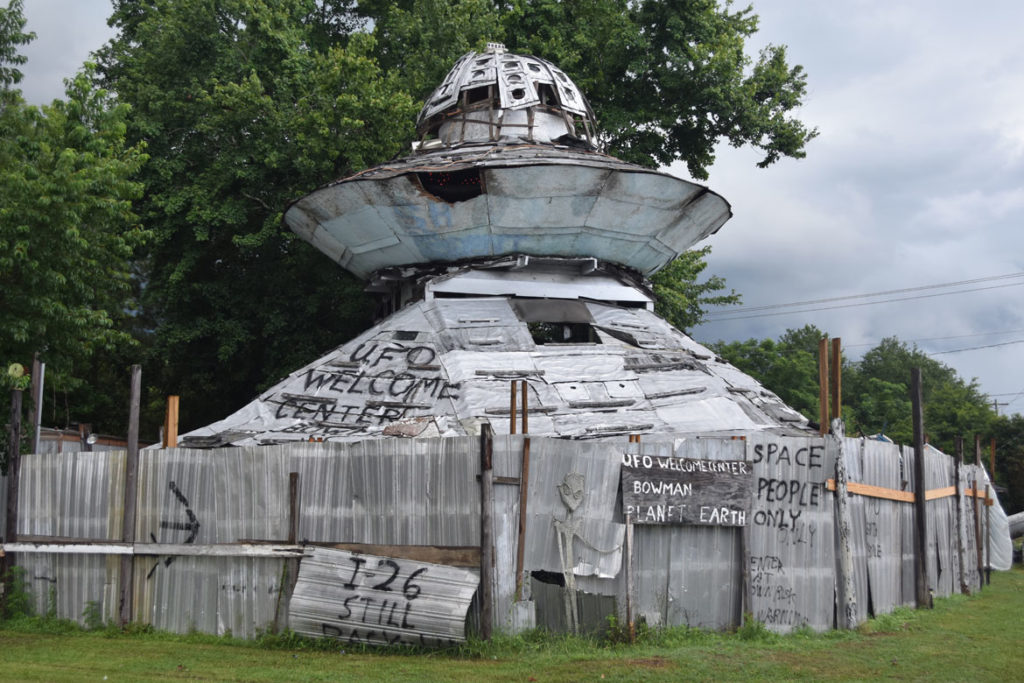
The UFO Welcome Center at Bowman, South Carolina, is like a makeshift backyard Noah’s Ark for the 21st century. Picture a flying saucer made out of plywood and you’ve got a pretty good image of the thing. Outside it’s a rough but impressive structure with broadsides painted on the surrounding fence that seem to warn: “Please do not take pictures of visitors from other planets with out their O.K. or you may be zapped.” You can climb up to the top inside, about three stories high, via terrifyingly precariously placed ladders. The flying saucer’s windows are made from glass pie plates. But the inside is filled with trash and graffiti and sadness.
Woods Bay State Park at Olanta, South Carolina
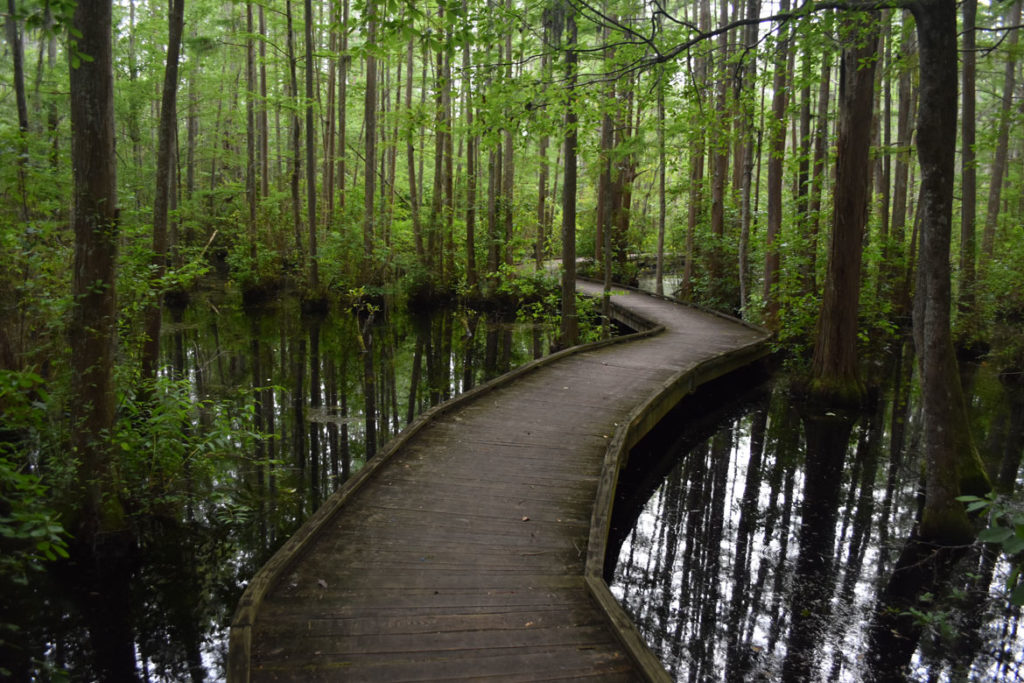
A ranger at Woods Bay State Park at Olanta, South Carolina, told us that he’d seen some alligators there earlier in the day. We saw a turtle and startled a brown patterned snake (the 6-year-old: “That was one of those poisonous ones and it was pretty big”) but no alligators. Thunder rumbled, then the water was dotted by a drizzle. We returned to the car.
Pearl Fryar’s Topiary Garden in Bishopville, South Carolina
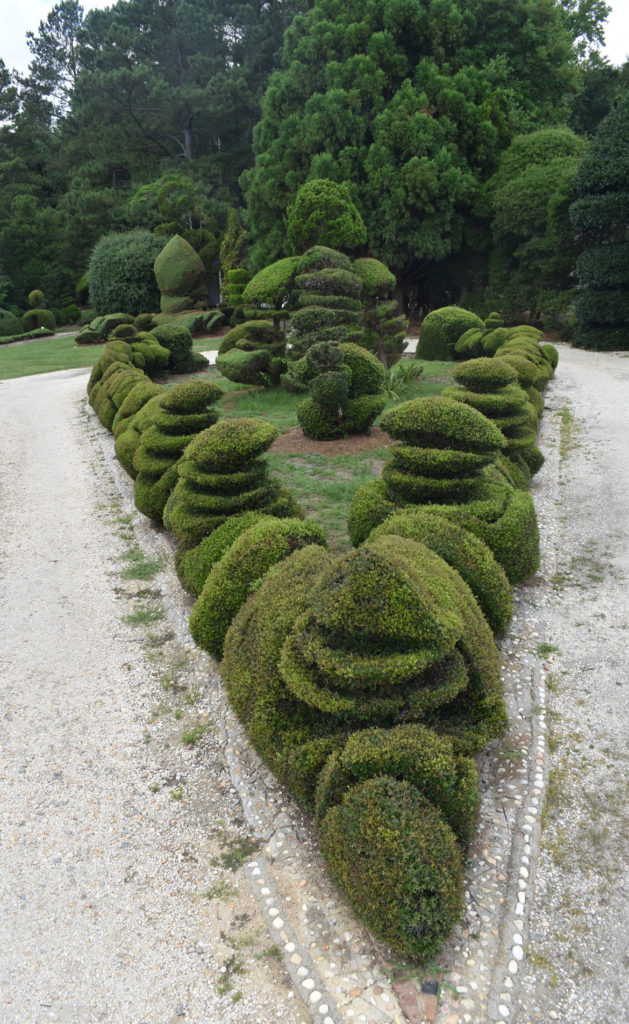
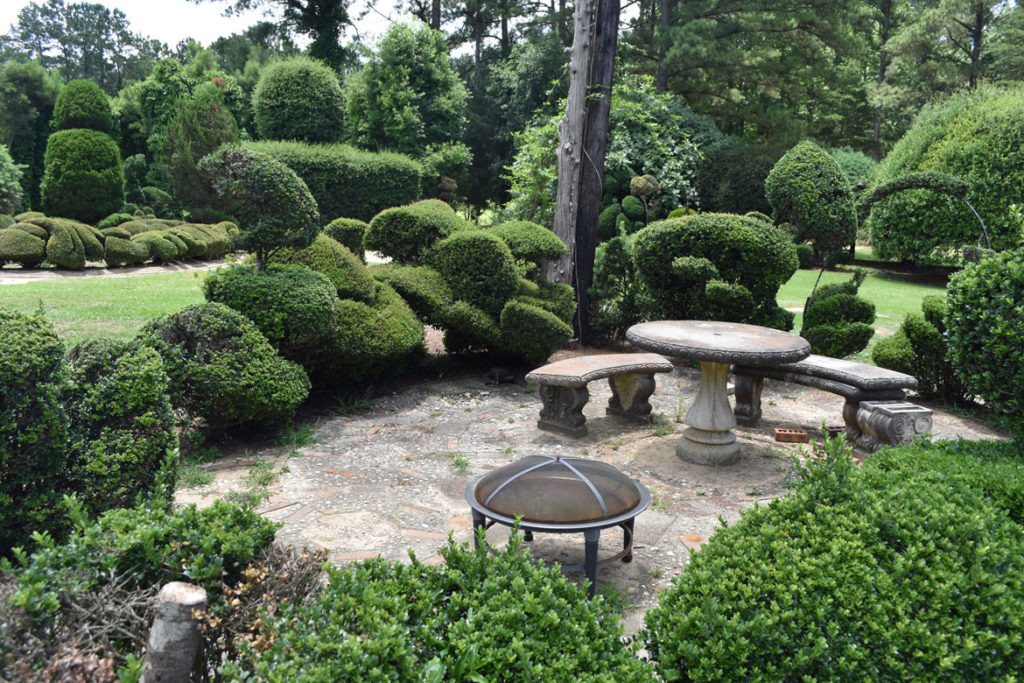
In the early 1980s, Pearl Fryar began transforming his Bishopville home into a fantastic topiary garden, often using plants rescued from the compost piles of local nurseries. “I didn’t have any limitations because I really didn’t know anything about horticulture,” he has said. “I just figured I could do whatever I wanted to with any plant I had.”
Dalton Stevens’s Button King Museum in Bishopville, South Carolina
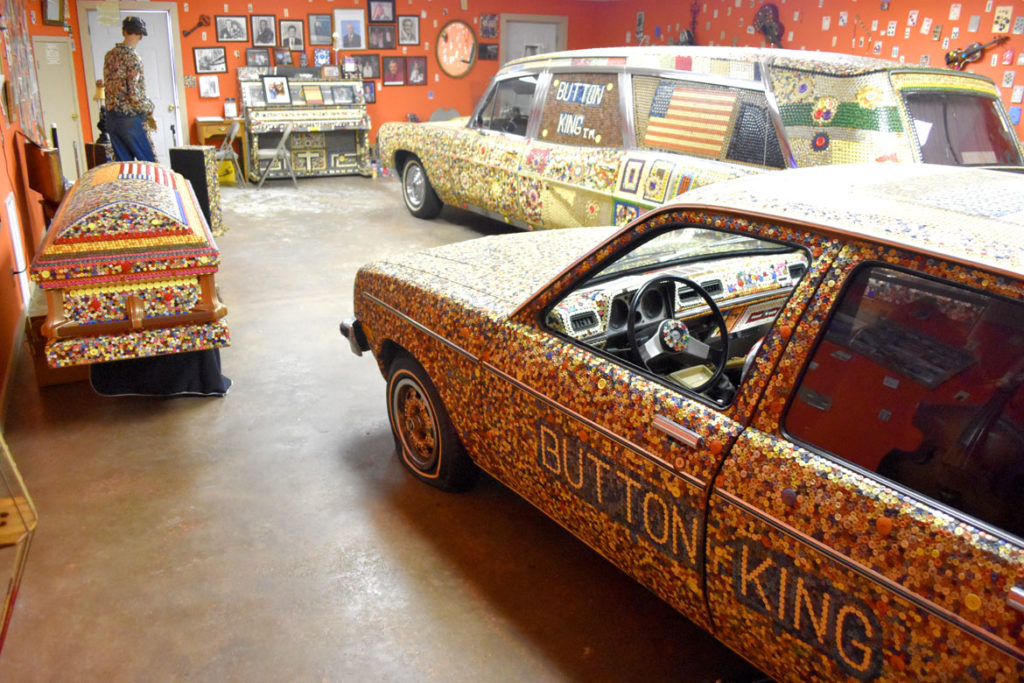
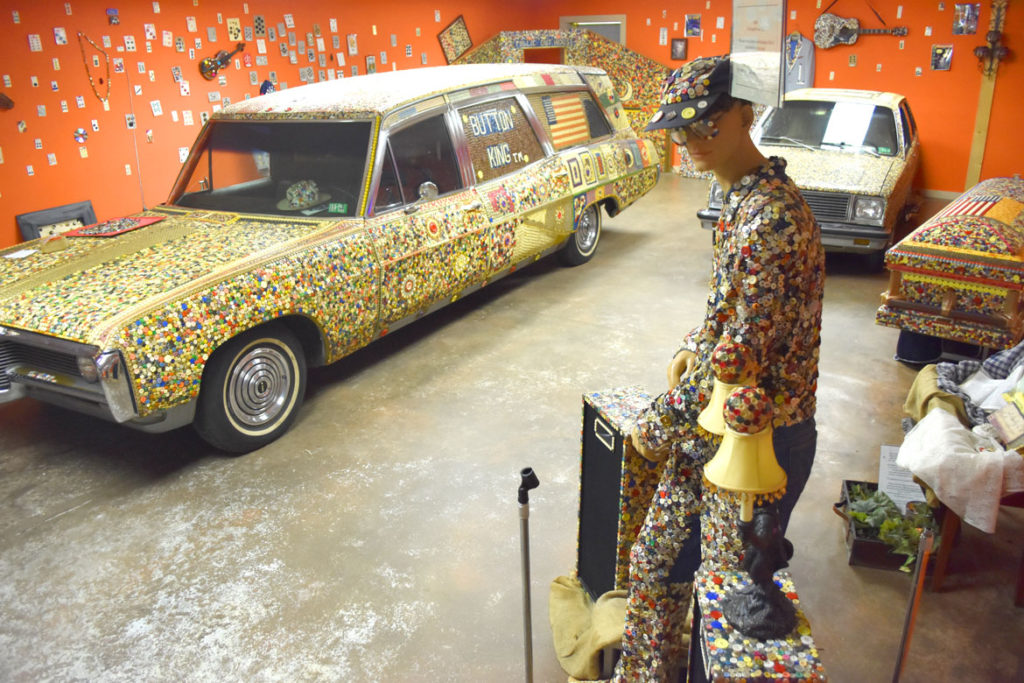
The Button King Museum is located in a Quonset hut along a dirt road curving through a farm field in Bishopville, South Carolina. “My name is Dalton Stevens and I suffer from insomnia. In 1983 it got so bad that I got up one night and started sewing buttons on a denim suit,” according to a sign authored by Stevens, who died in 2016. “Two years and 10 months later I still couldn’t sleep and the suit was covered with 16,333 buttons. It weighted 16 pounds. Things kind of evolved from that starting point.” Inside the building, we found a button-covered hearse, car, coffin, outhouse, guitar, piano, grandfather clock and the suit that started it all.
Bishopville, South Carolina
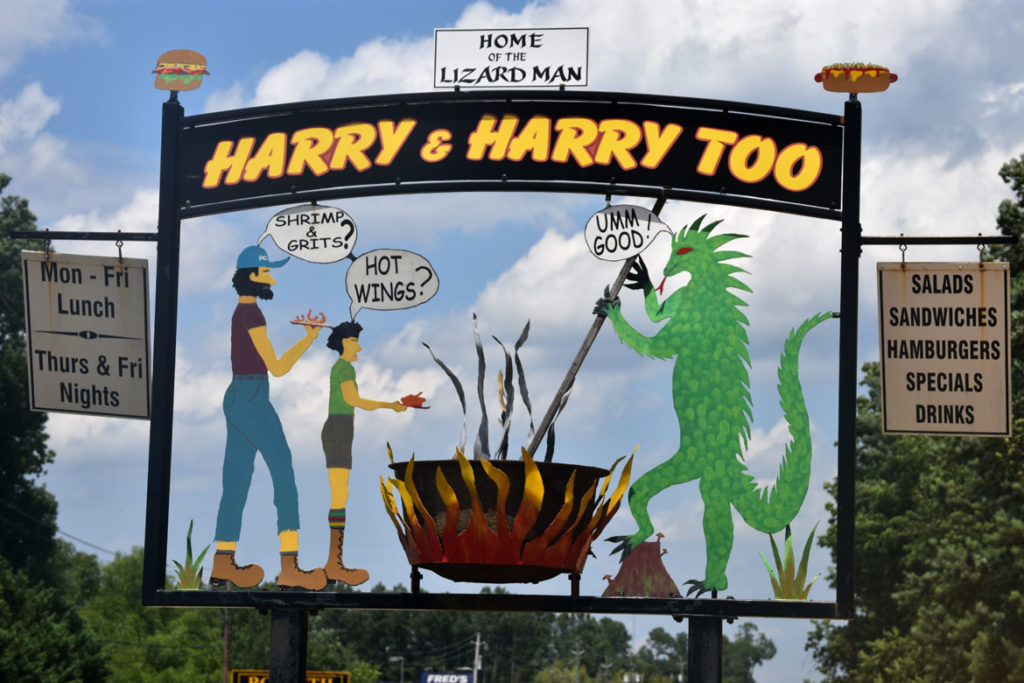
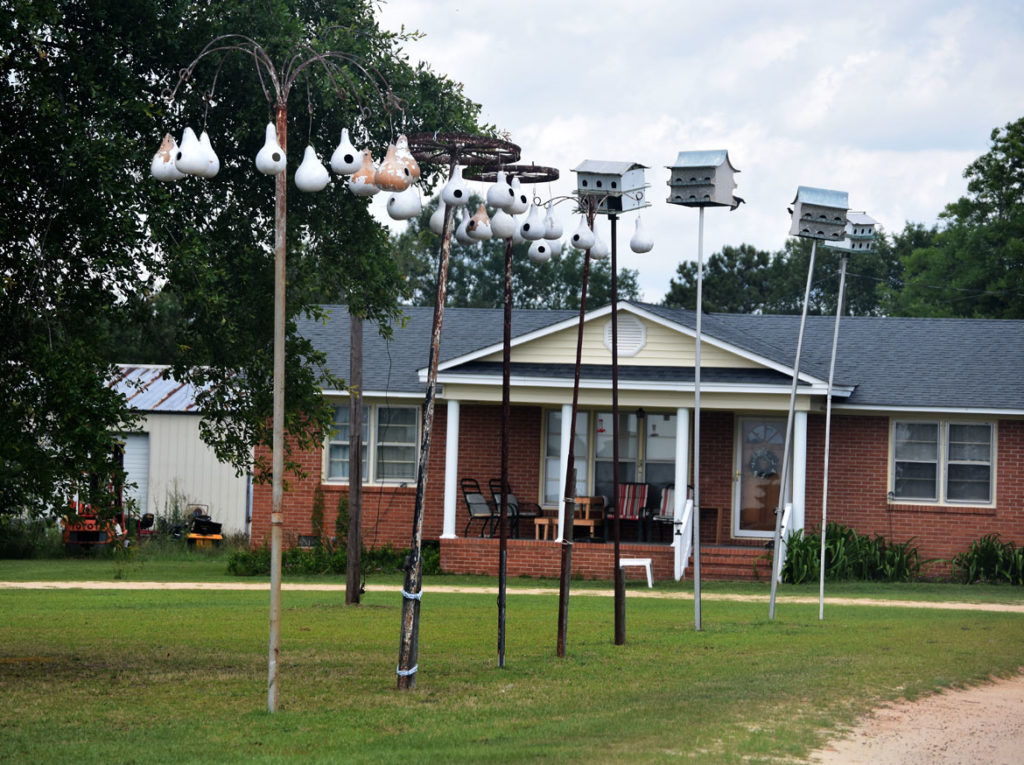
South Of The Border at Hamer, South Carolina
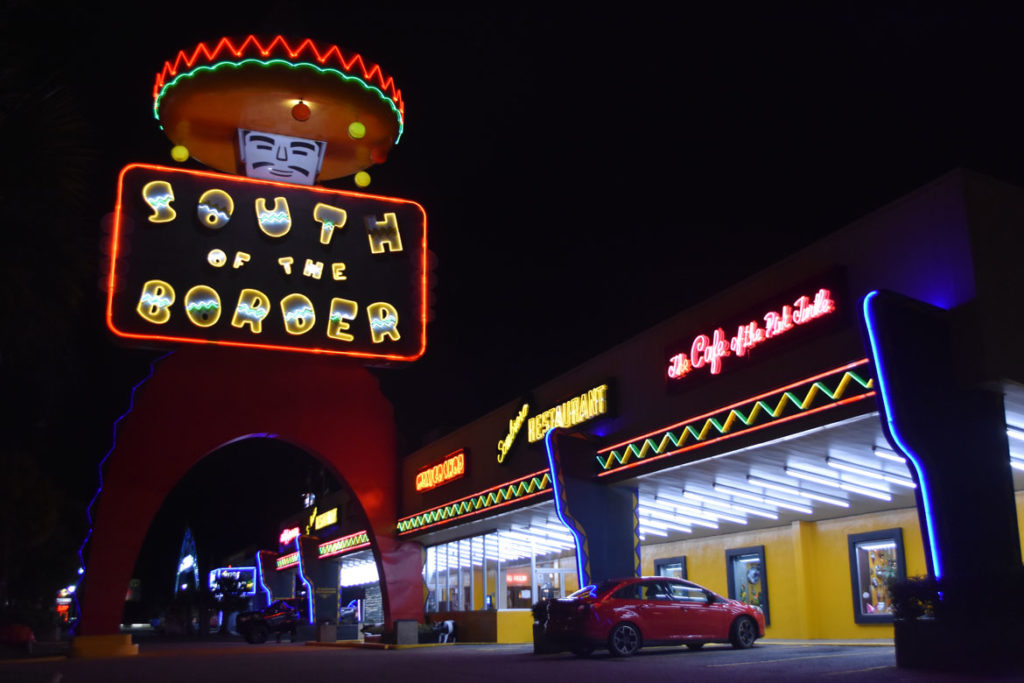
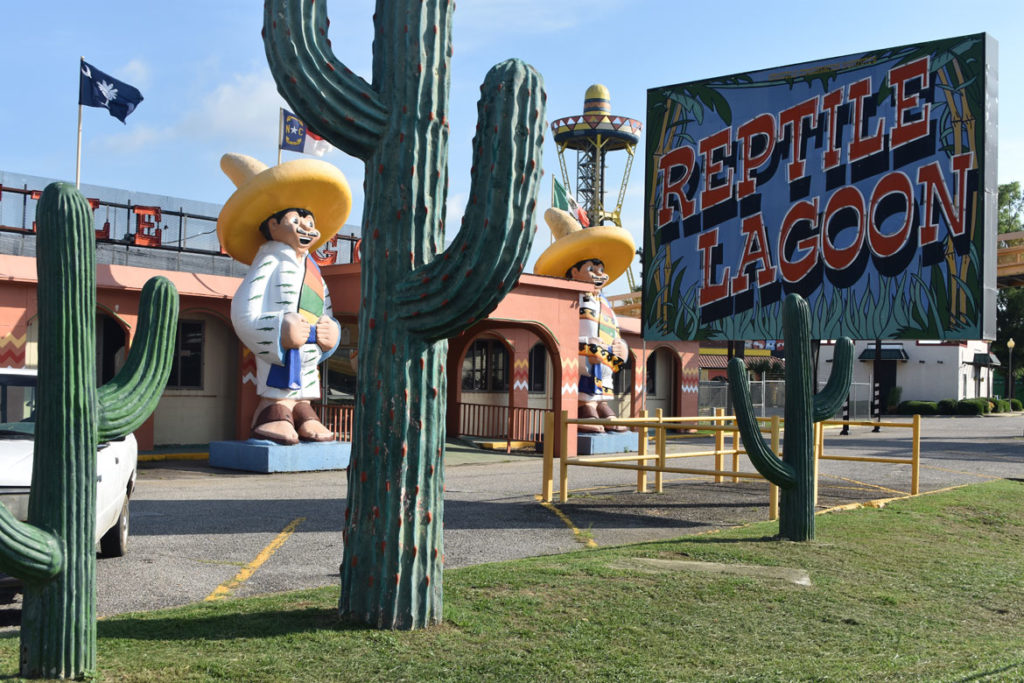
Neon lights up a tourist trap of racist stereotypes apparently inspired by its location just south of the North Carolina-South Carolina border along Route 95.
Vollis Simpson Whirligig Park at Wilson, North Carolina
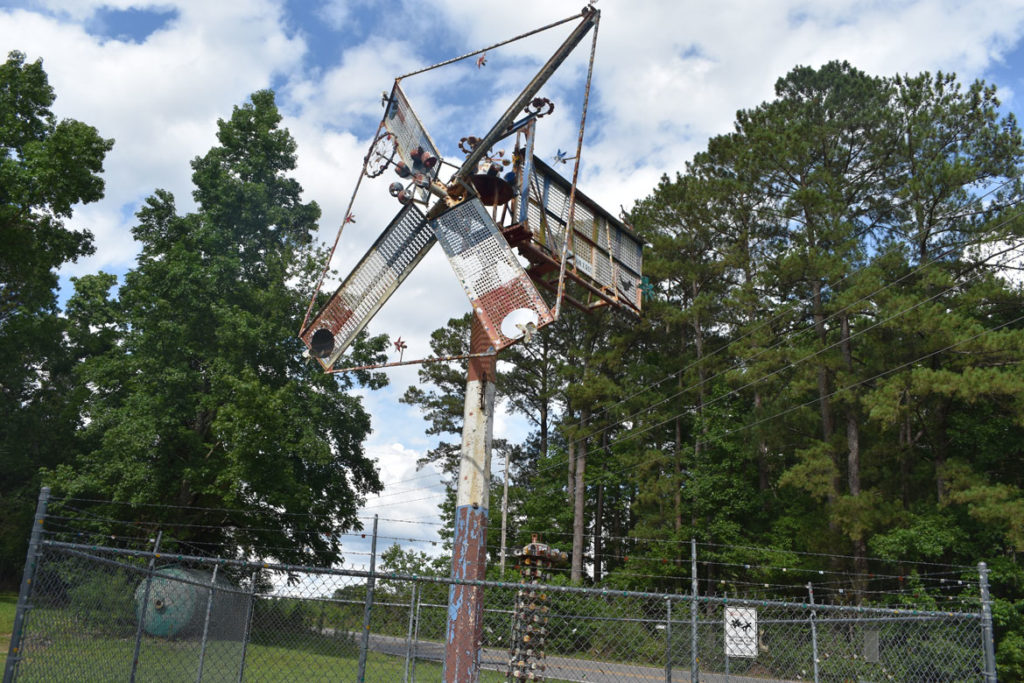
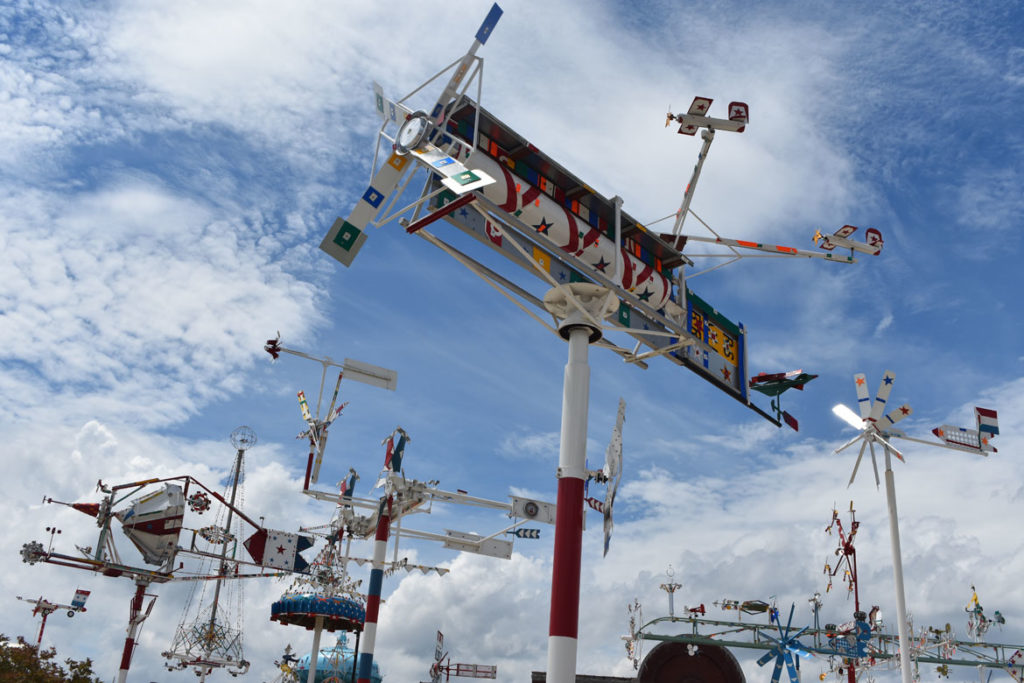
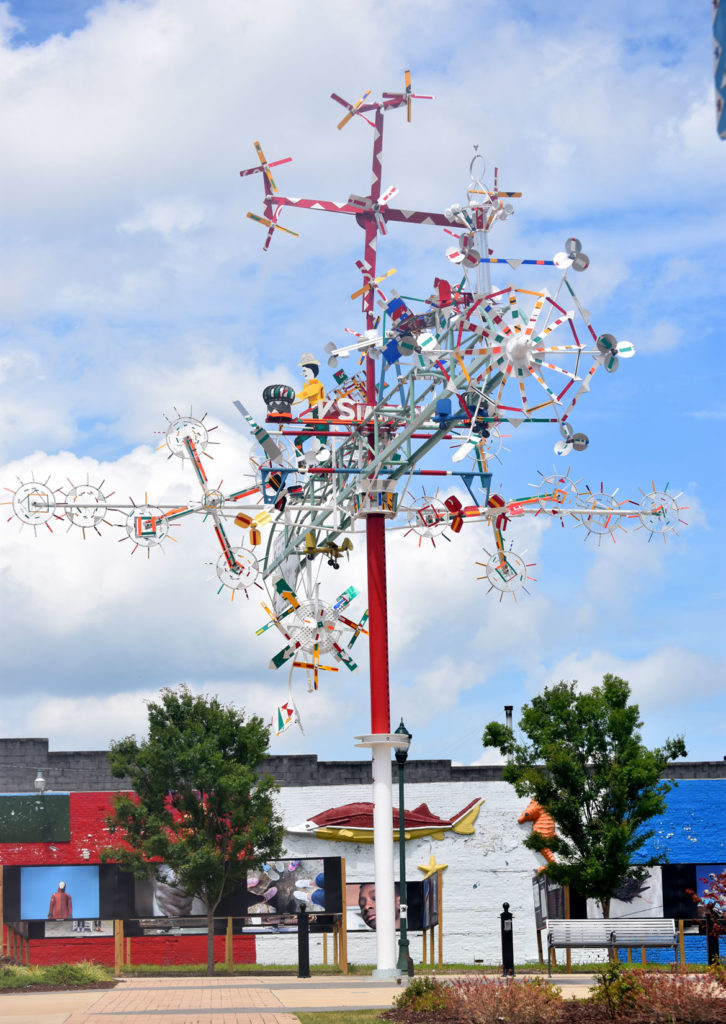
When he neared retirement age, Vollis Simpson, a farm machinery repairman based at a quiet rural crossroads in Lucama, North Carolina, began constructing giant kalediscopic kinetic sculptures and placing them around a pond across from his shop. Some rose more than 50 feet into the sky. The shop and whirligig garden are mostly overgrown now. There’s barbed wire and signs warn to keep out. At the corner stands one of his monumental whirligigs, paint fading, but still elegantly spinning in the wind. Before he died at age 94 in May 2013, a plan was hatched to move most of them to the city of Wilson, 11 miles away, where a park would be created specifically dedicated to them. There are some 30 of them there now, spruced up in bright red, white and blue, astonishingly huge and yet delicately dancing in the wind. They’re joyous and make you attentive to the air currents. They’re like a carnival of the sky.
Quentin J. Stephenson: Occoneeche Trapper’s Lodge
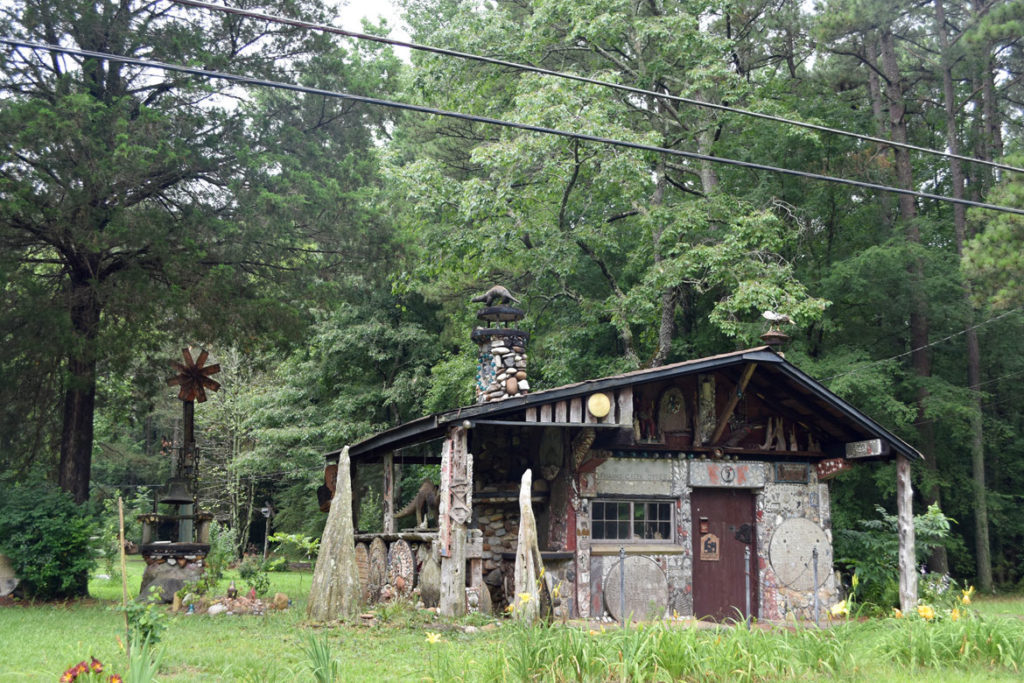
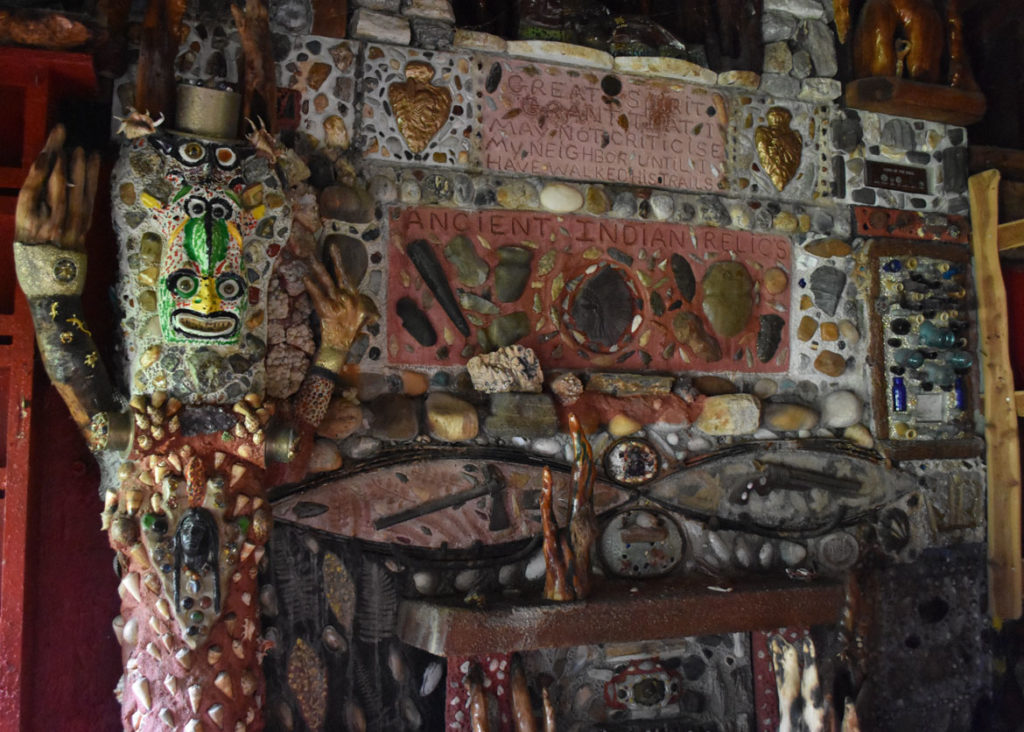
About two years ago, a couple bought the home of Quentin J. Stephenson at Garysburg, North Carolina, including his Occoneeche Trapper’s Lodge, in the front yard right along the road. The lodge is a sort of art monument or museum that Stephenson, who died in 1997, decorated with mosaics, cedar knees and sculptures addressing environmental and Native American themes.
Merchants Millpond State Park, North Carolina
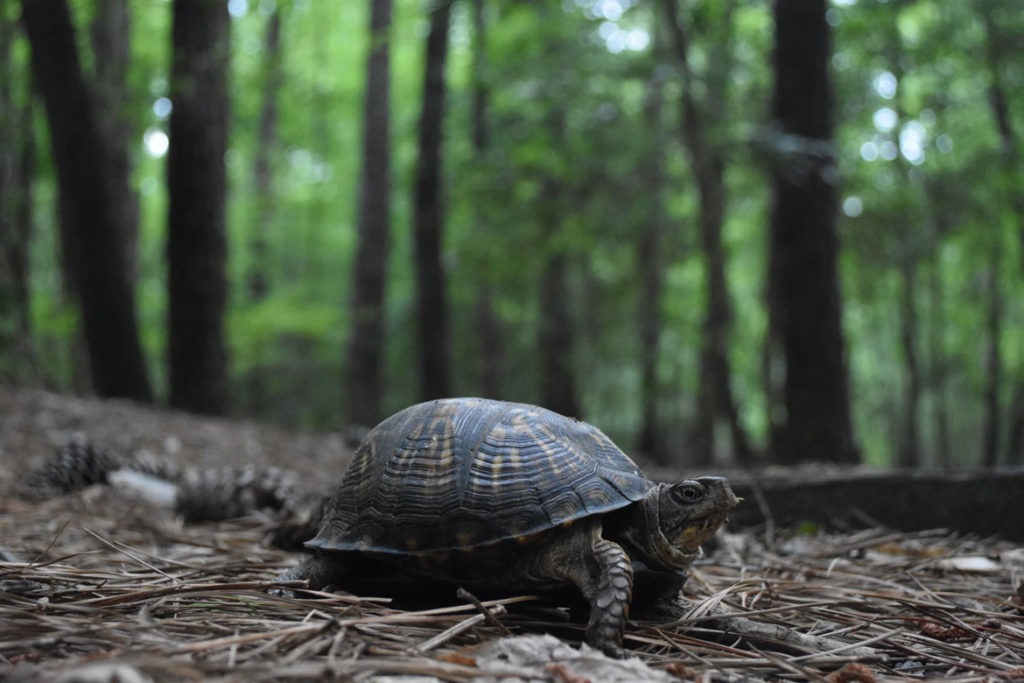
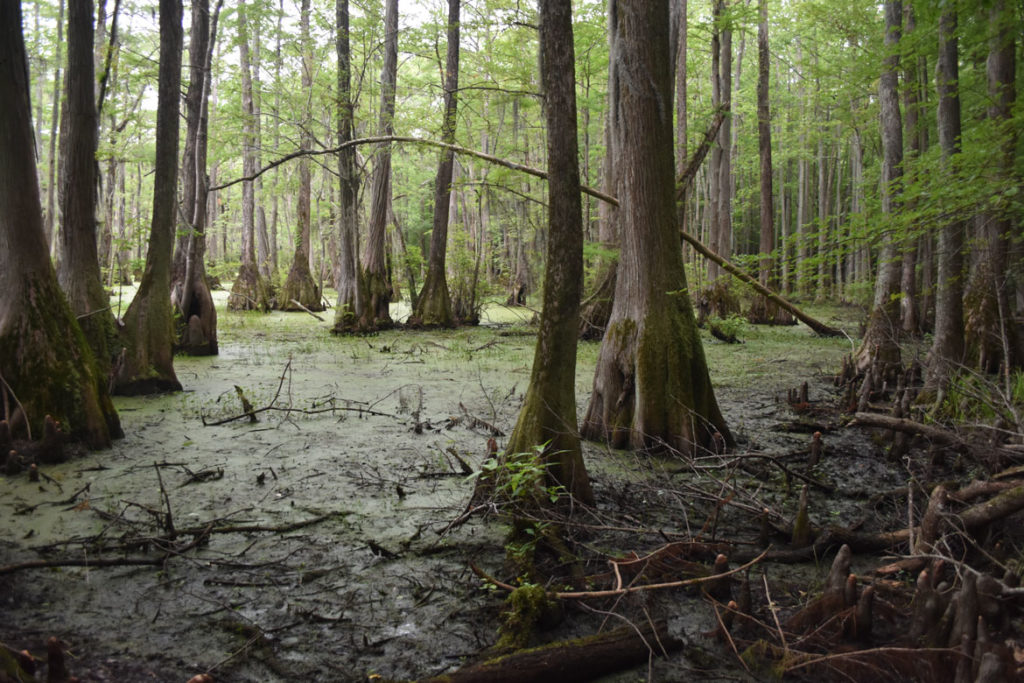
Not far south and west of the Great Dismal Swamp is Merchants Millpond State Park. Our only neighbors in the campground that night were Eastern box turtles, ticks and other critters. In the morning, we made a short hike to the cypress swamp.
Gas station just south of the border into Virgina.
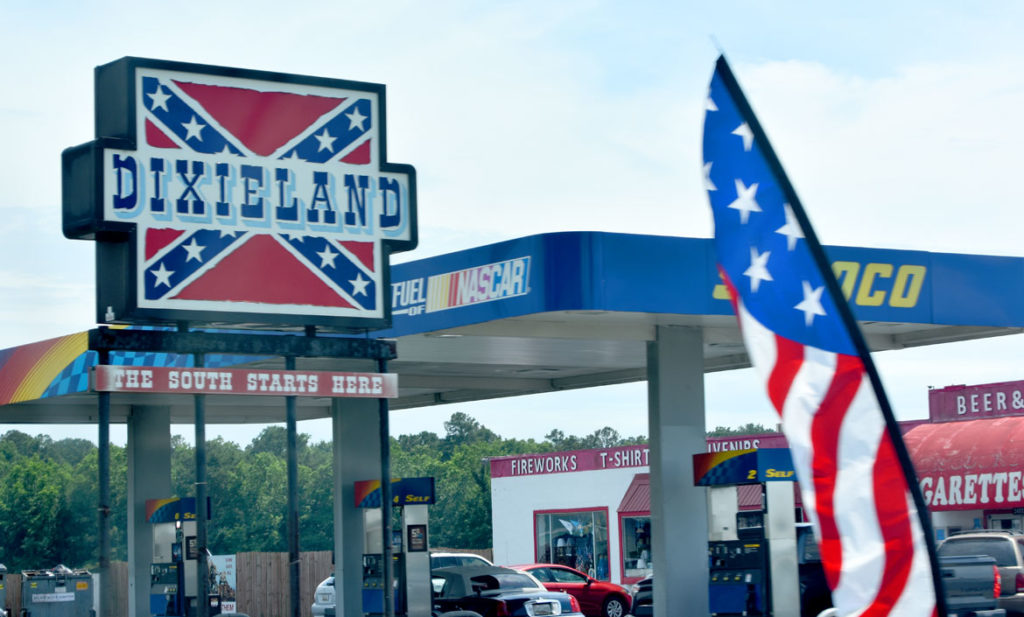
Harriet Tubman’s Duchess County, Maryland
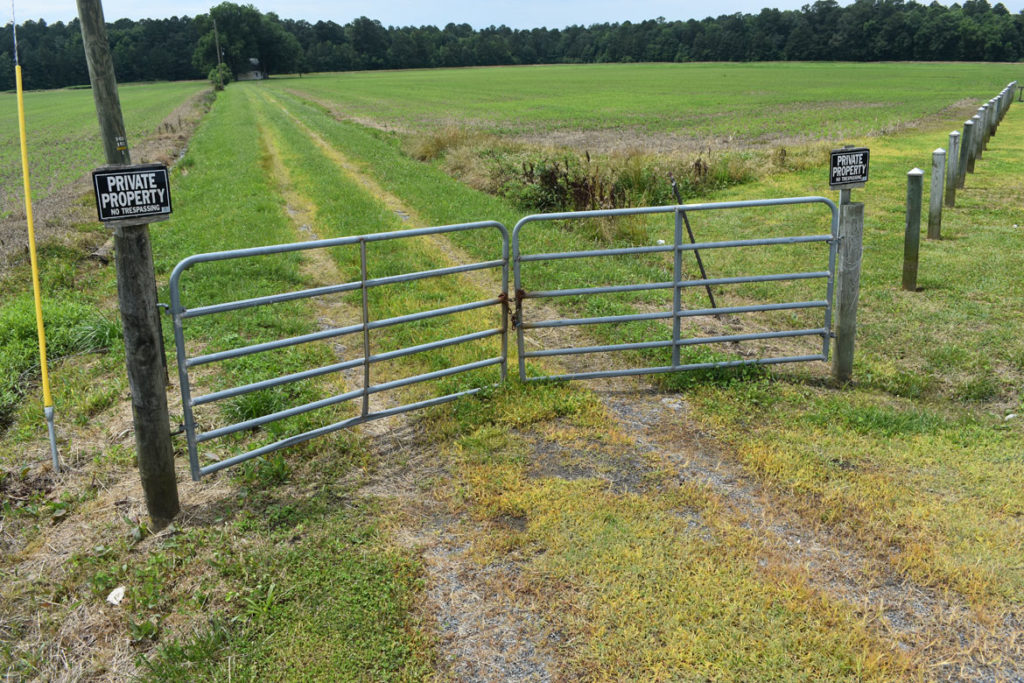
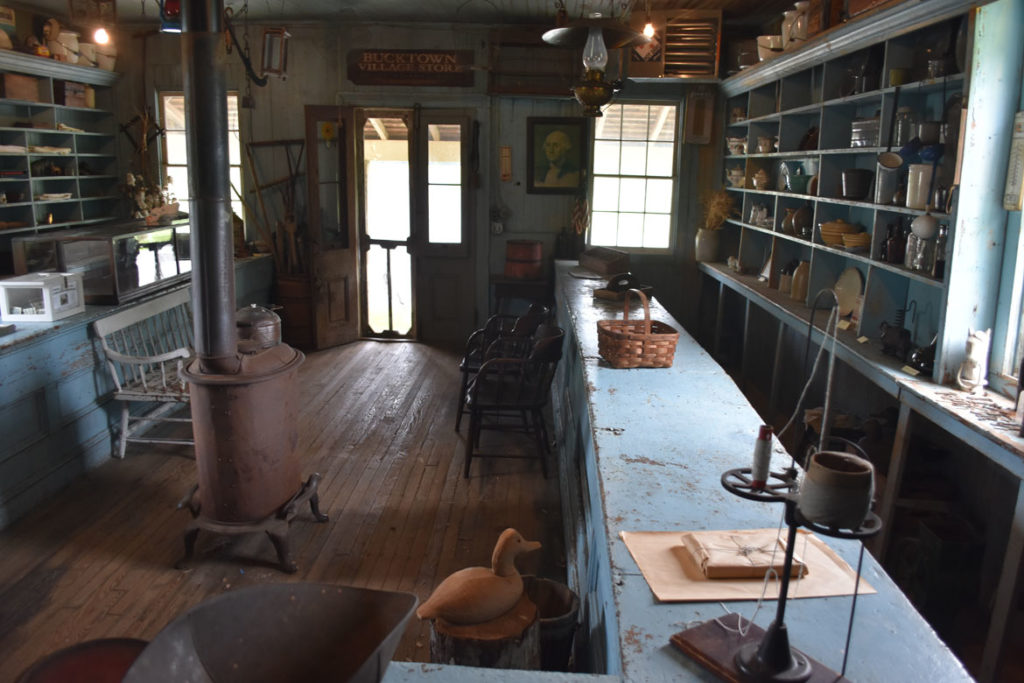
We made a pilgrimage to Dorchester County on Maryland’s Eastern Shore to see where Harriet Tubman was born around 1822. About a mile from Brodess Farm, where she was enslaved as a young girl, the Bucktown Village Store stands at the highway crossroads. Tubman was nearly fatally injured there one day, when an overseer tried to throw a 2-pound weight from a grocery scale at an enslaved boy. Instead he hit Tubman in the head, causing a lifetime of seizures, headaches and visions. In 1849, Tubman escaped from slavery here, making her way to the free city of Philadelphia. Over the next decade, she snuck back into to Maryland—mainly this area in particular—at least 13 times to rescue her parents and brothers and friends from imprisonment.
Assateague State Park, Maryland
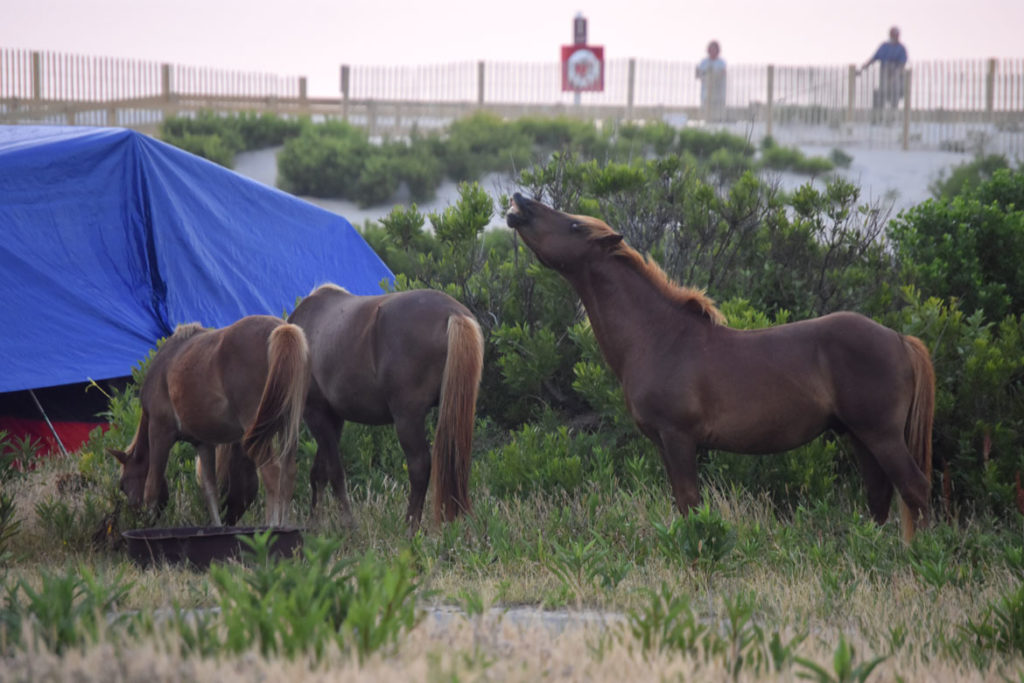
We arrived at Assateague State Park, a barrier beach in Maryland, with a thunderstorm lighting up the night sky to the west. We hurried to set up our tent in the dunes as an orange full moon rose over the sea. In the morning, we spotted the park’s famed feral horses grazing around campsites down the way.
Clarke Bedford’s Vanadu Gardens, Hyattsville, Maryland
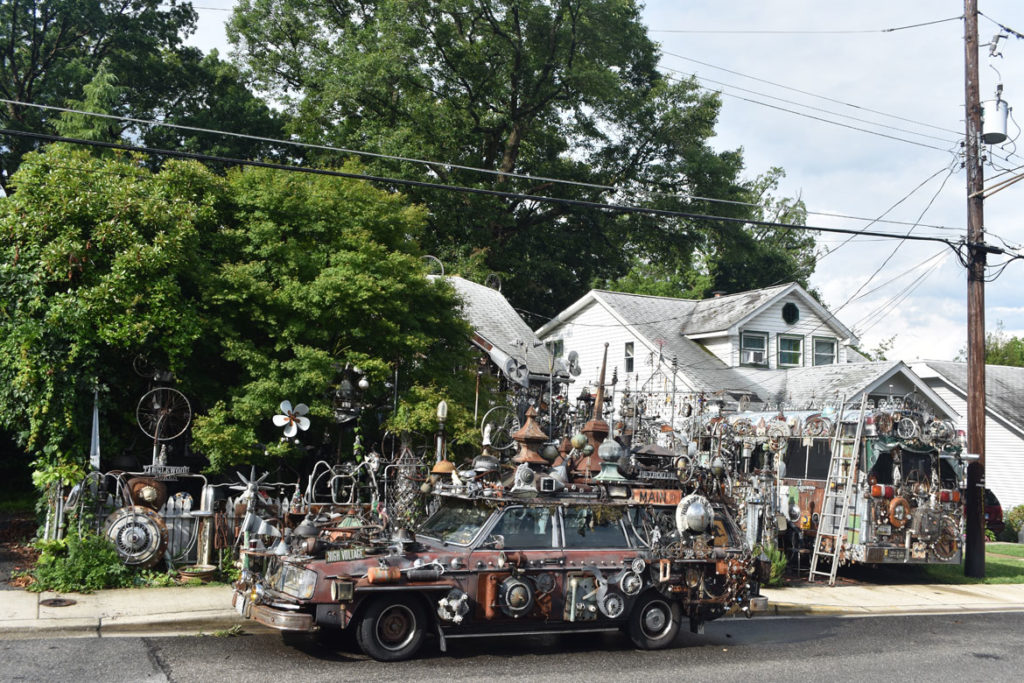
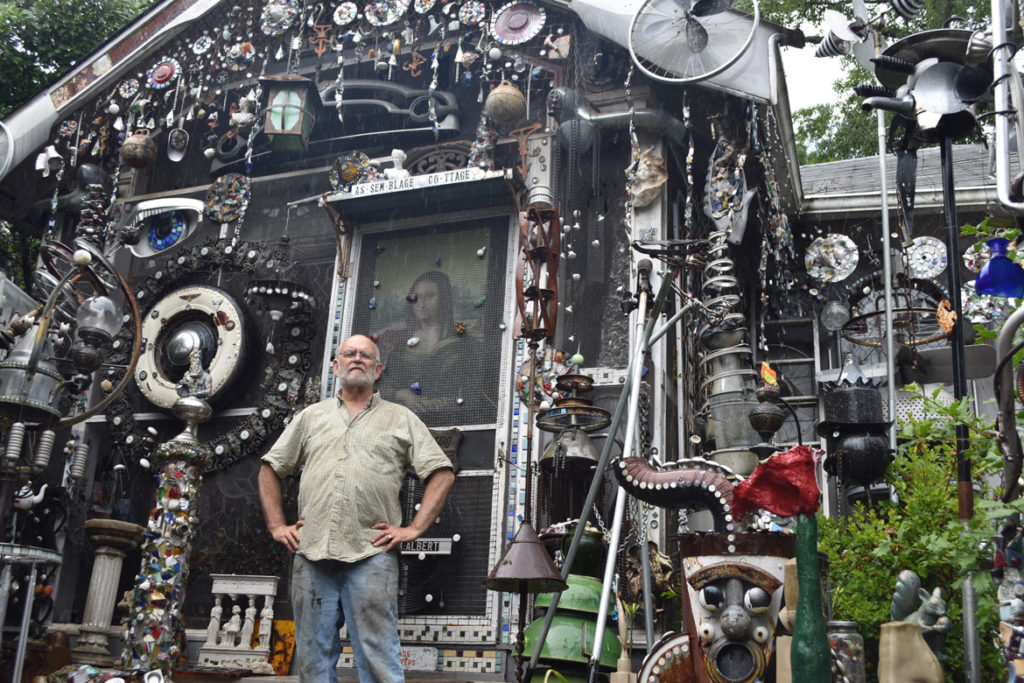
Clark Bedford has transformed his home in Hyattsville, Maryland, near Washington, D.C., into Vanadu Gardens, a wonderland of metal contraptions and constructions, two buses, a station wagon, a van and whirligigs.
Cascade Falls at Patapsco Valley State Park, Maryland
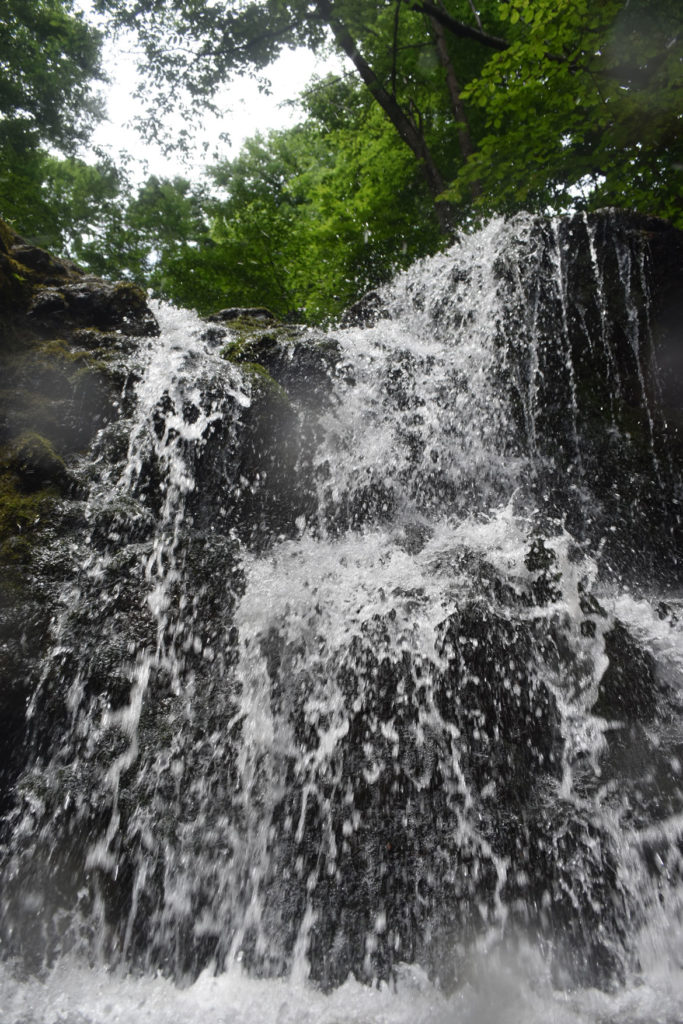
After a short walk up a wooded hill, we came to the first pool and little falls. We clambered up the boulders to the cascade flowing into a pond. Kids with kids with squirt guns splashed around. In the pool above the falls, our kids caught water striders.
Home of Katherine Fahey and Dan Van Allen, Baltimore
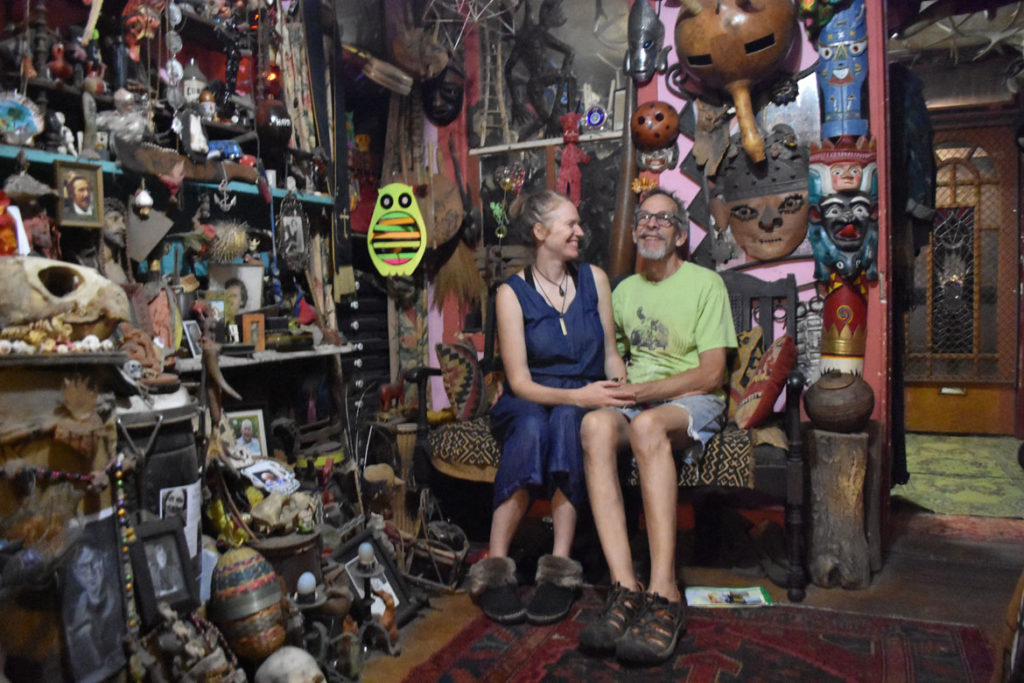
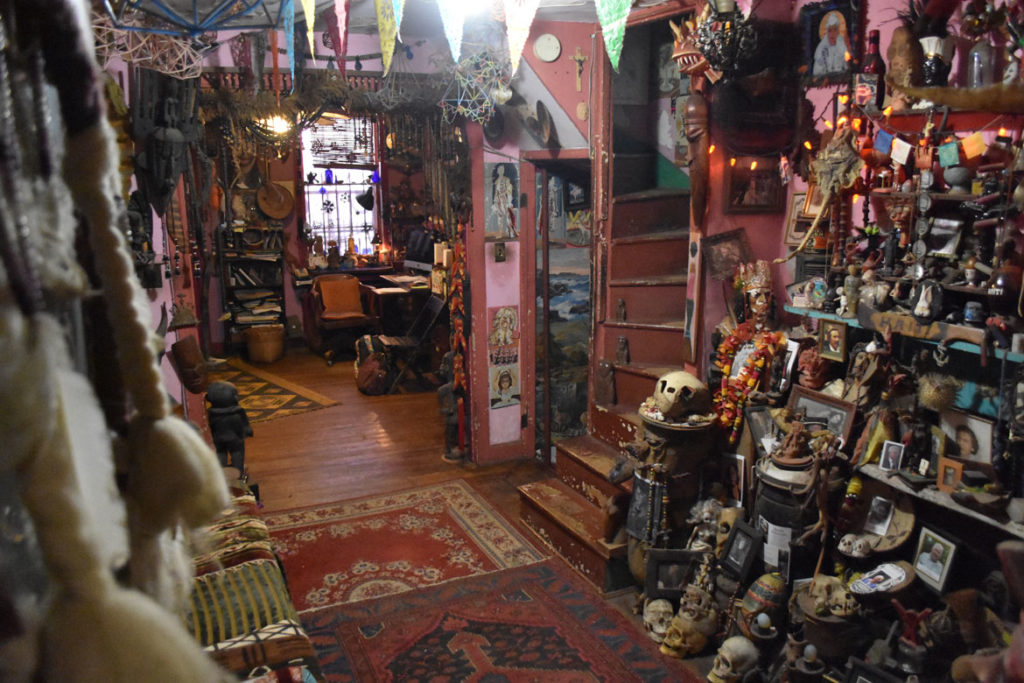
In Baltimore, we visited the home of Katherine Fahey, puppeteer and crankie-maker, and Dan Van Allen, artist and furniture restorer. He’s lived there for decades, filling rooms with altars and shrines and collections.
If this is the kind of coverage of arts, cultures and activisms you appreciate, please support Wonderland by contributing to Wonderland on Patreon. And sign up for our free, weekly newsletter so that you don’t miss any of our reporting.
